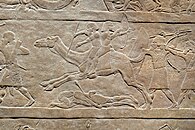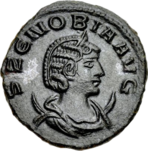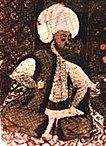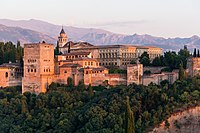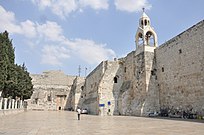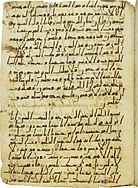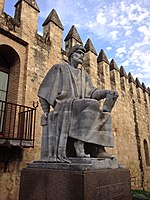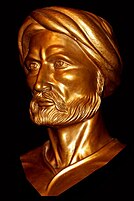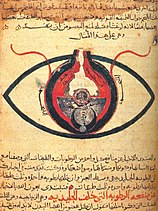Arabs
 From Wikipedia - Reading time: 109 min
From Wikipedia - Reading time: 109 min
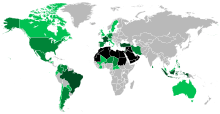 | |
| Total population | |
c. 400 million[1][2] to 420+ million[3][4]
| |
| Regions with significant populations | |
| 350,000,000[5][6] | |
| 11,600,000–20,000,000[7][8][9] | |
| 5,500,000–7,000,000[10][11] | |
| 5,000,000[12][a] | |
| 3,700,000[14] | |
| 3,500,000[15] | |
| 3,200,000[16][17][18][19][20] | |
| 2,080,000[21] | |
| 1,800,000[22] | |
| 1,600,000[23]–4,000,000[24] | |
| 1,600,000[25] | |
| 1,401,950[26] | |
| 1,350,000[27][28] | |
| 1,100,000[29] | |
| 800,000[30][31][32] | |
| 750,925[33] | |
| 705,968[34] | |
| 543,350[35] | |
| 500,000[36] | |
| 500,000[37] | |
| 480,000–613,800[38] | |
| 300,000[39] | |
| 280,000[40] | |
| 170,000 [41] | |
| 150,000 (2006)[42] | |
| 121,000[43] | |
| 118,866 (2010)[44] | |
| 100,000[45][46][47][48][49] | |
| 80,000 (2010)[50] | |
| 75,000[51] | |
| 70,000[52] | |
| 59,021 (2019)[53] | |
| 30,000[54] | |
| Languages | |
| Arabic | |
| Religion | |
Predominantly:
| |
| Related ethnic groups | |
| Other peoples of the Middle East and North Africa[55] | |
The Arabs (Arabic: عَرَب, DIN 31635: ʿarab, Arabic pronunciation:[b] [ˈʕɑ.rɑb] ), also known as the Arab people (الشَّعْبَ الْعَرَبِيّ), are an ethnic group[c] mainly inhabiting the Arab world in West Asia and North Africa. A significant Arab diaspora is present in various parts of the world.[74]
Arabs have been in the Fertile Crescent for thousands of years.[75] In the 9th century BCE, the Assyrians made written references to Arabs as inhabitants of the Levant, Mesopotamia, and Arabia.[76] Throughout the Ancient Near East, Arabs established influential civilizations starting from 3000 BCE onwards, such as Dilmun, Gerrha, and Magan, playing a vital role in trade between Mesopotamia, and the Mediterranean.[77] Other prominent tribes include Midian, ʿĀd, and Thamud mentioned in the Bible and Quran. Later, in 900 BCE, the Qedarites enjoyed close relations with the nearby Canaanite and Aramaean states, and their territory extended from Lower Egypt to the Southern Levant.[78] From 1200 BCE to 110 BCE, powerful kingdoms emerged such as Saba, Lihyan, Minaean, Qataban, Hadhramaut, Awsan, and Homerite emerged in Arabia.[79] According to the Abrahamic tradition, Arabs are descendants of Abraham through his son Ishmael.[80]
During classical antiquity, the Nabataeans established their kingdom with Petra as the capital in 300 BCE,[81] by 271 CE, the Palmyrene Empire with the capital Palmyra, led by Queen Zenobia, encompassed the Syria Palaestina, Arabia Petraea, and Egypt, as well as large parts of Anatolia.[82] The Arab Itureans inhabited Lebanon, Syria, and northern Palestine (Galilee) during the Hellenistic and Roman periods.[83] The Osroene and Hatran were Arab kingdoms in Upper Mesopotamia around 200 CE.[84] In 164 CE, the Sasanians recognized the Arabs as "Arbayistan", meaning "land of the Arabs,"[85] as they were part of Adiabene in upper Mesopotamia.[86] The Arab Emesenes ruled by 46 BCE Emesa (Homs), Syria.[87] During late antiquity, the Tanukhids, Salihids, Lakhmids, Kinda, and Ghassanids were dominant Arab tribes in the Levant, Mesopotamia, and Arabia, they predominantly embraced Christianity.[88]
During the Middle Ages, Islam fostered a vast Arab union, leading to significant Arab migrations to the Maghreb, the Levant, and neighbouring territories under the rule of Arab empires such as the Rashidun, Umayyad, Abbasid, and Fatimid, ultimately leading to the decline of the Byzantine and Sasanian empires. At its peak, Arab territories stretched from southern France to western China, forming one of history's largest empires.[89] The Great Arab Revolt in the early 20th century aided in dismantling the Ottoman Empire, ultimately leading to the formation of the Arab League on 22 March 1945, with its Charter endorsing the principle of a "unified Arab homeland".[90]
Arabs from Morocco to Iraq share a common bond based on ethnicity, language, culture, history, identity, ancestry, nationalism, geography, unity, and politics,[91] which give the region a distinct identity and distinguish it from other parts of the Muslim world.[92] They also have their own customs, literature, music, dance, media, food, clothing, society, sports, architecture, art and, mythology.[93] Arabs have significantly influenced and contributed to human progress in many fields, including science, technology, philosophy, ethics, literature, politics, business, art, music, comedy, theatre, cinema, architecture, food, medicine, and religion.[94] Before Islam, most Arabs followed polytheistic Semitic religion, while some tribes adopted Judaism or Christianity and a few individuals, known as the hanifs, followed a form of monotheism.[95] Currently, around 93% of Arabs are Muslims, while the rest are mainly Arab Christians, as well as Arab groups of Druze and Baháʼís.[96]
Etymology
[edit]
The earliest documented use of the word Arab in reference to a people appears in the Kurkh Monoliths, an Akkadian-language record of the Assyrian conquest of Aram (9th century BCE). The Monoliths used the term to refer to Bedouins of the Arabian Peninsula under King Gindibu, who fought as part of a coalition opposed to Assyria.[97] Listed among the booty captured by the army of the Assyrian king Shalmaneser III in the Battle of Qarqar (853 BCE) are 1000 camels of "Gîndibuʾ the Arbâya" or "[the man] Gindibu belonging to the Arabs" (ar-ba-a-a being an adjectival nisba of the noun ʿArab).[97]
The related word ʾaʿrāb is used to refer to Bedouins today, in contrast to ʿArab which refers to Arabs in general.[98] Both terms are mentioned around 40 times in pre-Islamic Sabaean inscriptions. The term ʿarab ('Arab') occurs also in the titles of the Himyarite kings from the time of 'Abu Karab Asad until MadiKarib Ya'fur. According to Sabaean grammar, the term ʾaʿrāb is derived from the term ʿarab. The term is also mentioned in Quranic verses, referring to people who were living in Madina and it might be a south Arabian loanword into Quranic language.[99]
The oldest surviving indication of an Arab national identity is an inscription made in an archaic form of Arabic in 328 CE using the Nabataean alphabet, which refers to Imru' al-Qays ibn 'Amr as 'King of all the Arabs'.[100][101] Herodotus refers to the Arabs in the Sinai, southern Palestine, and the frankincense region (Southern Arabia). Other Ancient-Greek historians like Agatharchides, Diodorus Siculus and Strabo mention Arabs living in Mesopotamia (along the Euphrates), in Egypt (the Sinai and the Red Sea), southern Jordan (the Nabataeans), the Syrian steppe and in eastern Arabia (the people of Gerrha). Inscriptions dating to the 6th century BCE in Yemen include the term 'Arab'.[102]
The most popular Arab account holds that the word Arab came from an eponymous father named Ya'rub, who was supposedly the first to speak Arabic. Abu Muhammad al-Hasan al-Hamdani had another view; he states that Arabs were called gharab ('westerners') by Mesopotamians because Bedouins originally resided to the west of Mesopotamia; the term was then corrupted into Arab.
Yet another view is held by al-Masudi that the word Arab was initially applied to the Ishmaelites of the Arabah valley. In Biblical etymology, Arab (Hebrew: arvi) comes from the desert origin of the Bedouins it originally described (arava means 'wilderness').
The root ʿ-r-b has several additional meanings in Semitic languages—including 'west, sunset', 'desert', 'mingle', 'mixed', 'merchant' and 'raven'—and are "comprehensible" with all of these having varying degrees of relevance to the emergence of the name. It is also possible that some forms were metathetical from ʿ-B-R, 'moving around' (Arabic: ʿ-B-R, 'traverse') and hence, it is alleged, 'nomadic'.[103]
Origins
[edit]Arabic is a Semitic language that belongs to the Afroasiatic language family. The majority of scholars accept the "Arabian peninsula" has long been accepted as the original Urheimat (linguistic homeland) of the Semitic languages.[104][105][106][107] with some scholars investigating if its origins are in the Levant.[108] The ancient Semitic-speaking peoples lived in the ancient Near East, including the Levant, Mesopotamia, and the Arabian Peninsula from the 3rd millennium BCE to the end of antiquity. Proto-Semitic likely reached the Arabian Peninsula by the 4th millennium BCE, and its daughter languages spread outward from there,[109] while Old Arabic began to differentiate from Central Semitic by the start of the 1st millennium BCE.[110] Central Semitic is a branch of the Semitic language includes Arabic, Aramaic, Canaanite, Phoenician, Hebrew and others.[111][112] The origins of Proto-Semitic may lie in the Arabian Peninsula, with the language spreading from there to other regions. This theory proposes that Semitic peoples reached Mesopotamia and other areas from the deserts to the west, such as the Akkadians who entered Mesopotamia around the late 4th millennium BCE.[109] The origins of Semitic peoples are thought to include various regions Mesopotamia, the Levant, the Arabian Peninsula, and North Africa. Some view that Semitic may have originated in the Levant around 3800 BCE and subsequently spread to the Horn of Africa around 800 BCE from Arabia, as well as to North Africa.[113][114]
In Abrahamic traditions
[edit]According to Arab–Islamic–Jewish traditions, Ishmael, the son of Abraham and Hagar was "father of the Arabs".[115][116][117][118][119] The Book of Genesis narrates that God promised Hagar to beget from Ishmael twelve princes and turn his descendants into a "great nation".[120][121][122][123][124][125] Ishmael was considered the ancestor of the Islamic prophet Muhammad, the founder of Islam. The tribes of Central West Arabia called themselves the "people of Abraham and the offspring of Ishmael."[126] Ibn Khaldun, an Arab scholar in the 8th century, described the Arabs as having Ishmaelite origins.[127]

The Quran mentions that Ibrahim (Abraham) and his wife Hajar (Hagar) bore a prophetic child named Ishmael, who was gifted by God a favor above other nations.[128] God ordered Ibrahim to bring Hajar and Ishmael to Mecca, where he prayed for them to be provided with water and fruits. Hajar ran between the hills of Safa and Marwa in search of water, and an angel appeared to them and provided them with water. Ishmael grew up in Mecca. Ibrahim was later ordered to sacrifice Ishmael in a dream, but God intervened and replaced him with a goat. Ibrahim and Ishmael then built the Kaaba in Mecca, which was originally constructed by Adam.[129]
According to the Samaritan book Asaṭīr adds:[130]: 262 "And after the death of Abraham, Ishmael reigned twenty-seven years; And all the children of Nebaot ruled for one year in the lifetime of Ishmael; And for thirty years after his death from the river of Egypt to the river Euphrates; and they built Mecca."[131] Josephus also lists the sons and states that they "...inhabit the lands which are between Euphrates and the Red Sea, the name of which country is Nabathæa.[132][133] The Targum Onkelos annotates (Genesis 25:16), describing the extent of their settlements: The Ishmaelites lived from Hindekaia (India) to Chalutsa (possibly in Arabia), by the side of Mizraim (Egypt), and from the area around Arthur (Assyria) up towards the north. This description suggests that the Ishmaelites were a widely dispersed group with a presence across a significant portion of the ancient Near East.[134][135]
History
[edit]The nomads of Arabia have been spreading through the desert fringes of the Fertile Crescent since at least 3000 BCE, but the first known reference to the Arabs as a distinct group is from an Assyrian scribe recording a battle in 853 BCE.[136][137] The history of the Arabs during the pre-Islamic period in various regions, including Arabia, Levant, Mesopotamia, and Egypt. The Arabs were mentioned by their neighbors, such as Assyrian and Babylonian Royal Inscriptions from 9th to 6th century BCE, mention the king of Qedar as king of the Arabs and King of the Ishmaelites.[138][139][140][141] Of the names of the sons of Ishmael the names "Nabat, Kedar, Abdeel, Dumah, Massa, and Teman" were mentioned in the Assyrian Royal Inscriptions as tribes of the Ishmaelites. Jesur was mentioned in Greek inscriptions in the 1st century BCE.[142] There are also records from Sargon's reign that mention sellers of iron to people called Arabs in Ḫuzaza in Babylon, causing Sargon to prohibit such trade out of fear that the Arabs might use the resource to manufacture weapons against the Assyrian army. The history of the Arabs in relation to the Bible shows that they were a significant part of the region and played a role in the lives of the Israelites. The study asserts that the Arab nation is an ancient and significant entity; however, it highlights that the Arabs lacked a collective awareness of their unity. They did not inscribe their identity as Arabs or assert exclusive ownership over specific territories.[143]

Magan, Midian, and ʿĀd are all ancient tribes or civilizations that are mentioned in Arabic literature and have roots in the Arabia. Magan (Arabic: مِجَانُ, Majan), known for its production of copper and other metals, the region was an important trading center in ancient times and is mentioned in the Qur'an as a place where Musa (Moses) traveled during his lifetime.[144][145] Midian (Arabic: مَدْيَن, Madyan), on the other hand, was a region located in the northwestern part of the Arabia, the people of Midian are mentioned in the Qur'an as having worshiped idols and having been punished by God for their disobedience.[146][147] Moses also lived in Midian for a time, where he married and worked as a shepherd. ʿĀd (Arabic: عَادَ, ʿĀd), as mentioned earlier, was an ancient tribe that lived in the southern Arabia, the tribe was known for its wealth, power, and advanced technology, but they were ultimately destroyed by a powerful windstorm as punishment for their disobedience to God.[148] ʿĀd is regarded as one of the original Arab tribes.[149][150] The historian Herodotus provided extensive information about Arabia, describing the spices, terrain, folklore, trade, clothing, and weapons of the Arabs. In his third book, he mentioned the Arabs (Άραβες) as a force to be reckoned with in the north of the Arabian Peninsula just before Cambyses’ campaign against Egypt. Other Greek and Latin authors who wrote about Arabia include Theophrastus, Strabo, Diodorus Siculus, and Pliny the Elder. The Jewish historian Flavius Josephus wrote about the Arabs and their king, mentioning their relationship with Cleopatra, the queen of Egypt. The tribute paid by the Arab king to Cleopatra was collected by Herod, the king of the Jews, but the Arab king later became slow in his payments and refused to pay without further deductions. This sheds some light on the relations between the Arabs, Jews, and Egypt at that time.[151] Geshem the Arab was an Arab man who opposed Nehemiah in the Hebrew Bible (Neh. 2:19, 6:1). He was likely the chief of the Arab tribe "Gushamu" and have been a powerful ruler with influence stretching from northern Arabia to Judah. The Arabs and the Samaritans made efforts to hinder Nehemiah's rebuilding of the walls of Jerusalem.[152][153][154]
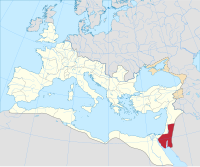
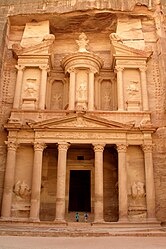
The term "Saracens" was a term used in the early centuries, both in Greek and Latin writings, to refer to the "Arabs" who lived in and near what was designated by the Romans as Arabia Petraea (Levant) and Arabia Deserta (Arabia).[155][156] The Christians of Iberia used the term Moor to describe all the Arabs and Muslims of that time. Arabs of Medina referred to the nomadic tribes of the deserts as the A'raab, and considered themselves sedentary, but were aware of their close racial bonds. Hagarenes is a term widely used by early Syriac, Greek, and Armenian to describe the early Arab conquerors of Mesopotamia, Syria and Egypt, refers to the descendants of Hagar, who bore a son named Ishmael to Abraham in the Old Testament. In the Bible, the Hagarenes referred to as "Ishmaelites" or "Arabs."[157] The Arab conquests in the 7th century was a sudden and dramatic conquest led by Arab armies, which quickly conquered much of the Middle East, North Africa, and Spain. It was a significant moment for Islam, which saw itself as the successor of Judaism and Christianity.[158] The term ʾiʿrāb has the same root refers to the Bedouin tribes of the desert who rejected Islam and resisted Muhammad.(Quran 9:97) The 14th century Kebra Nagast says "And therefore the children of Ishmael became kings over Tereb, and over Kebet, and over Nôbâ, and Sôba, and Kuergue, and Kîfî, and Mâkâ, and Môrnâ, and Fînḳânâ, and ’Arsîbânâ, and Lîbâ, and Mase'a, for they were the seed of Shem."[159]
Antiquity
[edit]
Limited local historical coverage of these civilizations means that archaeological evidence, foreign accounts and Arab oral traditions are largely relied on to reconstruct this period. Prominent civilizations at the time included, Dilmun civilization was an important trading centre[162] which at the height of its power controlled the Arabian Gulf trading routes.[162] The Sumerians regarded Dilmun as holy land.[163] Dilmun is regarded as one of the oldest ancient civilizations in the Middle East.[164][165] which arose around the 4th millennium BCE and lasted to 538 BCE. Gerrha was an ancient city of Eastern Arabia, on the west side of the Gulf, Gerrha was the center of an Arab kingdom from approximately 650 BCE to circa CE 300. Thamud, which arose around the 1st millennium BCE and lasted to about 300 CE. From the beginning of the first millennium BCE, Proto-Arabic, or Ancient North Arabian, texts give a clearer picture of the Arabs' emergence. The earliest are written in variants of epigraphic south Arabian musnad script, including the 8th century BCE Hasaean inscriptions of eastern Saudi Arabia, the Thamudic texts found throughout the Arabian Peninsula and Sinai.
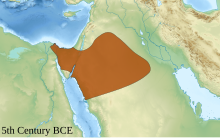
The Qedarites were a largely nomadic ancient Arab tribal confederation centred in the Wādī Sirḥān in the Syrian Desert. They were known for their nomadic lifestyle and for their role in the caravan trade that linked the Arabian Peninsula with the Mediterranean world. The Qedarites gradually expanded their territory over the course of the 8th and 7th centuries BCE, and by the 6th century BCE, they had consolidated into a kingdom that covered a large area in northern Arabia, southern Palestine, and the Sinai Peninsula. The Qedarites were influential in the ancient Near East, and their kingdom played a significant role in the political and economic affairs of the region for several centuries.[166]
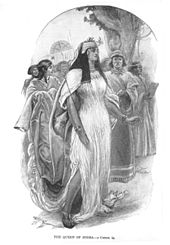
Sheba (Arabic: سَبَأٌ Saba) is kingdom mentioned in the Hebrew Bible (Old Testament) and the Quran, though Sabaean was a South Arabian languaged and not an Arabic one. Sheba features in Jewish, Muslim, and Christian traditions, whose lineage goes back to Qahtan son of Hud, one of the ancestors of the Arabs,[167][168][169] Sheba was mentioned in Assyrian inscriptions and in the writings of Greek and Roman writers.[170] One of the ancient written references that also spoke of Sheba is the Old Testament, which stated that the people of Sheba supplied Syria and Egypt with incense, especially frankincense, and exported gold and precious stones to them.[171] The Queen of Sheba who travelled to Jerusalem to question King Solomon, great caravan of camels, carrying gifts of gold, precious stones, and spices,[172] when she arrived, she was impressed by the wisdom and wealth of King Solomon, and she posed a series of difficult questions to him.[173] King Solomon was able to answer all of her questions, and the Queen of Sheba was impressed by his wisdom and his wealth.(1 Kings 10)

Sabaeans are mentioned several times in the Hebrew Bible. In the Quran,[174] they are described as either Sabaʾ (سَبَأ, not to be confused with Ṣābiʾ, صَابِئ),[168][169] or as Qawm Tubbaʿ (Arabic: قَوْم تُبَّع, lit. 'People of Tubbaʿ').[175][176] They were known for their prosperous trade and agricultural economy, which was based on the cultivation of frankincense and myrrh, these highly valued aromatic resins were exported to Egypt, Greece, and Rome, making the Sabaeans wealthy and powerful, they also traded in spices, textiles, and other luxury goods. The Maʾrib Dam was one of the greatest engineering achievements of the ancient world, and it provided water for the city of Maʾrib and the surrounding agricultural lands.[177][178][170]
Lihyan also called Dadān or Dedan was a powerful and highly organized ancient Arab kingdom that played a vital cultural and economic role in the north-western region of the Arabian Peninsula and used Dadanitic language.[179] The Lihyanites were known for their advanced organization and governance, and they played a significant role in the cultural and economic life of the region. The kingdom was centered around the city of Dedan (modern-day Al Ula), and it controlled a large territory that extended from Yathrib in the south to parts of the Levant in the north.[180][179] The Arab genealogies consider the Banu Lihyan to be Ishmaelites, and used Dadanitic language.[181]
The Kingdom of Ma'in was an ancient Arab kingdom with a hereditary monarchy system and a focus on agriculture and trade.[182] Proposed dates range from the 15th century BCE to the 1st century CE Its history has been recorded through inscriptions and classical Greek and Roman books, although the exact start and end dates of the kingdom are still debated. The Ma'in people had a local governance system with councils called "Mazood," and each city had its own temple that housed one or more gods. They also adopted the Phoenician alphabet and used it to write their language. The kingdom eventually fell to the Arab Sabaean people.[183][184]
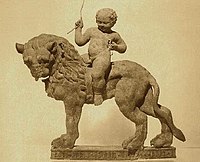
Qataban was an ancient kingdom located in the South Arabia, which existed from the early 1st millennium BCE till the late 1st or 2nd centuries CE.[186][186][187] It developed into a centralized state in the 6th century BCE with two co-kings ruling poles.[186][188] Qataban expanded its territory, including the conquest of Ma'in and successful campaigns against the Sabaeans.[187][185][189] It challenged the supremacy of the Sabaeans in the region and waged a successful war against Hadramawt in the 3rd century BCE.[185][190] Qataban's power declined in the following centuries, leading to its annexation by Hadramawt and Ḥimyar in the 1st century CE.[191][187][185][186][192][185]
The Kingdom of Hadhramaut it was known for its rich cultural heritage, as well as its strategic location along important trade routes that connected the Middle East, South Asia, and East Africa.[193] The Kingdom was established around the 3rd century BCE, and it reached its peak during the 2nd century CE, when it controlled much of the southern Arabian Peninsula. The kingdom was known for its impressive architecture, particularly its distinctive towers, which were used as watchtowers, defensive structures, and homes for wealthy families.[194] The people of Hadhramaut were skilled in agriculture, especially in growing frankincense and myrrh. They had a strong maritime culture and traded with India, East Africa, and Southeast Asia.[195] Although the kingdom declined in the 4th century, Hadhramaut remained a cultural and economic center. Its legacy can still be seen today.[196]
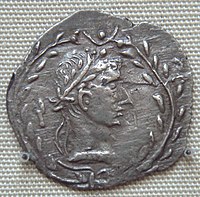
The ancient Kingdom of Awsān (8th–7th century BCE) was indeed one of the most important small kingdoms of South Arabia, and its capital Ḥajar Yaḥirr was a significant center of trade and commerce in the ancient world. It is fascinating to learn about the rich history of this region and the cultural heritage that has been preserved through the archaeological sites like Ḥajar Asfal. The destruction of the city in the 7th century BCE by the king and Mukarrib of Saba' Karab El Watar is a significant event in the history of South Arabia. It highlights the complex political and social dynamics that characterized the region at the time and the power struggles between different kingdoms and rulers. The victory of the Sabaeans over Awsān is also a testament to the military might and strategic prowess of the Sabaeans, who were one of the most powerful and influential kingdoms in the region.[197]
The Himyarite Kingdom or Himyar, was an ancient kingdom that existed from around the 2nd century BCE to the 6th century CE. It was centered in the city of Zafar, which is located in present-day Yemen. The Himyarites were an Arab people who spoke a South Arabian language and were known for their prowess in trade and seafaring,[198] they controlled the southern part of Arabia and had a prosperous economy based on agriculture, commerce, and maritime trade, they were skilled in irrigation and terracing, which allowed them to cultivate crops in the arid environment. The Himyarites converted to Judaism in the 4th century CE, and their rulers became known as the "Kings of the Jews", this conversion was likely influenced by their trade connections with the Jewish communities of the Red Sea region and the Levant, however, the Himyarites also tolerated other religions, including Christianity and the local pagan religions.[198]
Classical antiquity
[edit]The Nabataeans were nomadic Arabs who settled in a territory centred around their capital of Petra in what is now Jordan.[199][200] Their early inscriptions were in Aramaic, but gradually switched to Arabic, and since they had writing, it was they who made the first inscriptions in Arabic. The Nabataean alphabet was adopted by Arabs to the south, and evolved into modern Arabic script around the 4th century. This is attested by Safaitic inscriptions (beginning in the 1st century BCE) and the many Arabic personal names in Nabataean inscriptions. From about the 2nd century BCE, a few inscriptions from Qaryat al-Faw reveal a dialect no longer considered proto-Arabic, but pre-classical Arabic. Five Syriac inscriptions mentioning Arabs have been found at Sumatar Harabesi, one of which dates to the 2nd century CE.[201][202]
Arabs are first recorded in Palmyra in the late first millennium BCE.[203] The soldiers of the sheikh Zabdibel, who aided the Seleucids in the battle of Raphia (217 BCE), were described as Arabs; Zabdibel and his men were not actually identified as Palmyrenes in the texts, but the name "Zabdibel" is a Palmyrene name leading to the conclusion that the sheikh hailed from Palmyra.[204] After the Battle of Edessa in 260 CE. Valerian's capture by the Sassanian king Shapur I was a significant blow to Rome, and it left the empire vulnerable to further attacks. Zenobia was able to capture most of the Near East, including Egypt and parts of Asia Minor. However, their empire was short-lived, as Aurelian was able to defeat the Palmyrenes and recover the lost territories. The Palmyrenes were helped by their Arab allies, but Aurelian was also able to leverage his own alliances to defeat Zenobia and her army. Ultimately, the Palmyrene Empire lasted only a few years, but it had a significant impact on the history of the Roman Empire and the Near East.
Most scholars identify the Itureans as an Arab people who inhabited the region of Iturea,[205][206][207][208] emerged as a prominent power in the region after the decline of the Seleucid Empire in the 2nd century BCE, from their base around Mount Lebanon and the Beqaa Valley, they came to dominate vast stretches of Syrian territory,[209] and appear to have penetrated into northern parts of Palestine as far as the Galilee.[83] Tanukhids were an Arab tribal confederation that lived in the central and eastern Arabian Peninsula during the late ancient and early medieval periods. As mentioned earlier, they were a branch of the Rabi'ah tribe, which was one of the largest Arab tribes in the pre-Islamic period. They were known for their military prowess and played a significant role in the early Islamic period, fighting in battles against the Byzantine and Sassanian empires and contributing to the expansion of the Arab empire.[210]

The Osroene Arabs, also known as the Abgarids,[211][212][213] were in possession of the city of Edessa in the ancient Near East for a significant period of time. Edessa was located in the region of Osroene, which was an ancient kingdom that existed from the 2nd century BCE to the 3rd century CE. They established a dynasty known as the Abgarids, which ruled Edessa for several centuries. The most famous ruler of the dynasty was Abgar V, who is said to have corresponded with Jesus Christ and is believed to have converted to Christianity.[214] The Abgarids played an important role in the early history of Christianity in the region, and Edessa became a center of Christian learning and scholarship.[215] The Kingdom of Hatra was an ancient city located in the region of Mesopotamia, it was founded in the 2nd or 3rd century BCE and flourished as a major center of trade and culture during the Parthian Empire. The rulers of Hatra were known as the Arsacid dynasty, which was a branch of the Parthian ruling family. However, in the 2nd century CE, the Arab tribe of Banu Tanukh seized control of Hatra and established their own dynasty. The Arab rulers of Hatra assumed the title of "malka," which means king in Arabic, and they often referred to themselves as the "King of the Arabs."[216]
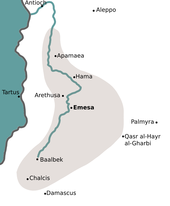
The Osroeni and Hatrans were part of several Arab groups or communities in upper Mesopotamia, which also included the Arabs of Adiabene which was an ancient kingdom in northern Mesopotamia, its chief city was Arbela (Arba-ilu), where Mar Uqba had a school, or the neighboring Hazzah, by which name the later Arabs also called Arbela.[217][218] This elaborate Arab presence in upper Mesopotamia was acknowledged by the Sasanians, who called the region Arbayistan, meaning "land of the Arabs", is first attested as a province in the Ka'ba-ye Zartosht inscription of the second Sasanian King of Kings (shahanshah) Shapur I (r. 240–270),[219] which was erected in c. 262.[220][86] The Emesene were a dynasty of Arab priest-kings that ruled the city of Emesa (modern-day Homs, Syria) in the Roman province of Syria from the 1st century CE to the 3rd century CE. The dynasty is notable for producing a number of high priests of the god El-Gabal, who were also influential in Roman politics and culture. The first ruler of the Emesene dynasty was Sampsiceramus I, who came to power in 64 CE. He was succeeded by his son, Iamblichus, who was followed by his own son, Sampsiceramus II. Under Sampsiceramus II, Emesa became a client kingdom of the Roman Empire, and the dynasty became more closely tied to Roman political and cultural traditions.[221]
Late antiquity
[edit]The Ghassanids, Lakhmids and Kindites were the last major migration of pre-Islamic Arabs out of Yemen to the north. The Ghassanids increased the Semitic presence in then-Hellenized Syria, the majority of Semites were Aramaic peoples. They mainly settled in the Hauran region and spread to modern Lebanon, Palestine and Jordan. Greeks and Romans referred to all the nomadic population of the desert in the Near East as Arabi. The Romans called Yemen "Arabia Felix".[222] The Romans called the vassal nomadic states within the Roman Empire Arabia Petraea, after the city of Petra, and called unconquered deserts bordering the empire to the south and east Arabia Magna.

The Lakhmids as a dynasty inherited their power from the Tanukhids, the mid Tigris region around their capital Al-Hira. They ended up allying with the Sassanids against the Ghassanids and the Byzantine Empire. The Lakhmids contested control of the Central Arabian tribes with the Kindites with the Lakhmids eventually destroying the Kingdom of Kinda in 540 after the fall of their main ally Himyar. The Persian Sassanids dissolved the Lakhmid dynasty in 602, being under puppet kings, then under their direct control.[223] The Kindites migrated from Yemen along with the Ghassanids and Lakhmids, but were turned back in Bahrain by the Abdul Qais Rabi'a tribe. They returned to Yemen and allied themselves with the Himyarites who installed them as a vassal kingdom that ruled Central Arabia from "Qaryah Dhat Kahl" (the present-day called Qaryat al-Faw). They ruled much of the Northern/Central Arabian peninsula, until they were destroyed by the Lakhmid king Al-Mundhir, and his son 'Amr.
The Ghassanids were an Arab tribe in the Levant in the early third century. According to Arab genealogical tradition, they were considered a branch of the Azd tribe. They fought alongside the Byzantines against the Sasanians and Arab Lakhmids. Most Ghassanids were Christians, converting to Christianity in the first few centuries, and some merged with Hellenized Christian communities. After the Muslim conquest of the Levant, few Ghassanids became Muslims, and most remained Christian and joined Melkite and Syriac communities within what is now Jordan, Palestine, Syria, and Lebanon.[224] The Salihids were Arab foederati in the 5th century, were ardent Christians, and their period is less documented than the preceding and succeeding periods due to a scarcity of sources. Most references to the Salihids in Arabic sources derive from the work of Hisham ibn al-Kalbi, with the Tarikh of Ya'qubi considered valuable for determining the Salihids' fall and the terms of their foedus with the Byzantines.[225]
Middle Ages
[edit]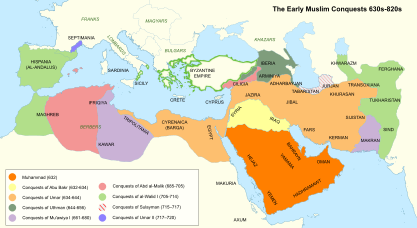
During the Middle Ages, Arab civilization flourished and the Arabs made significant contributions to the fields of science, mathematics, medicine, philosophy, and literature, with the rise of great cities like Baghdad, Cairo, and Cordoba, they became centers of learning, attracting scholars, scientists, and intellectuals.[226][227] Arabs forged many empires and dynasties, most notably, the Rashidun Empire, the Umayyad Empire, the Abbasid Empire, the Fatimid Empire, among others. These empires were characterized by their expansion, scientific achievements, and cultural flourishing, extended from Spain to India.[226] The region was vibrant and dynamic during the Middle Ages and left a lasting impact on the world.[227]

The rise of Islam began when Muhammad and his followers migrated from Mecca to Medina in an event known as the Hijra. Muhammad spent the last ten years of his life engaged in a series of battles to establish and expand the Muslim community. From 622 to 632, he led the Muslims in a state of war against the Meccans.[228] During this period, the Arabs conquered the region of Basra, and under the leadership of Umar, they established a base and built a mosque there. Another conquest was Midian, but due to its harsh environment, the settlers eventually moved to Kufa. Umar successfully defeated rebellions by various Arab tribes, bringing stability to the entire Arabian peninsula and unifying it. Under the leadership of Uthman, the Arab empire expanded through the conquest of Persia, with the capture of Fars in 650 and parts of Khorasan in 651.[229] The conquest of Armenia also began in the 640s. During this time, the Rashidun Empire extended its rule over the entire Sassanid Empire and more than two-thirds of the Eastern Roman Empire. However, the reign of Ali ibn Abi Talib, the fourth caliph, was marred by the First Fitna, or the First Islamic Civil War, which lasted throughout his rule. After a peace treaty with Hassan ibn Ali and the suppression of early Kharijite disturbances, Muawiyah I became the Caliph.[230] This marked a significant transition in leadership.[229][231]
Arab empires
[edit]Rashidun era (632–661)
[edit]After the death of Muhammad in 632, Rashidun armies launched campaigns of conquest, establishing the Caliphate, or Islamic Empire, one of the largest empires in history. It was larger and lasted longer than the previous Arab empire Tanukhids of Queen Mawia or the Arab Palmyrene Empire. The Rashidun state was a completely new state and unlike the Arab kingdoms of its century such as the Himyarite, Lakhmids or Ghassanids.
During the Rashidun era, the Arab community expanded rapidly, conquering many territories and establishing a vast Arab empire, which is marked by the reign of the first four caliphs, or leaders, of the Arab community.[232] These caliphs are Abu Bakr, Umar, Uthman and Ali, who are collectively known as the Rashidun, meaning "rightly guided." The Rashidun era is significant in Arab and Islamic history as it marks the beginning of the Arab empire and the spread of Islam beyond the Arabian Peninsula. During this time, the Arab community faced numerous challenges, including internal divisions and external threats from neighboring empires.[232][233]
Under the leadership of Abu Bakr, the Arab community successfully quelled a rebellion by some tribes who refused to pay Zakat, or Islamic charity. During the reign of Umar ibn al-Khattab, the Arab empire expanded significantly, conquering territories such as Egypt, Syria, and Iraq. The reign of Uthman ibn Affan was marked by internal dissent and rebellion, which ultimately led to his assassination. Ali, the cousin and son-in-law of Muhammad, succeeded Uthman as caliph but faced opposition from some members of the Islamic community who believed he was not rightfully appointed.[232] Despite these challenges, the Rashidun era is remembered as a time of great progress and achievement in Arab and Islamic history, the caliphs established a system of governance that emphasized justice and equality for all members of the Islamic community. They also oversaw the compilation of the Quran into a single text and spread Arabic teachings and principles throughout the empire. Overall, the Rashidun era played a crucial role in shaping Arab history and continues to be revered by Muslims worldwide as a period of exemplary leadership and guidance.[234]
Umayyad era (661–750 and 756–1031)
[edit]In 661, the Rashidun Caliphate fell into the hands of the Umayyad dynasty and Damascus was established as the empire's capital. The Umayyads were proud of their Arab identity and sponsored the poetry and culture of pre-Islamic Arabia. They established garrison towns at Ramla, Raqqa, Basra, Kufa, Mosul and Samarra, all of which developed into major cities.[235] Caliph Abd al-Malik established Arabic as the Caliphate's official language in 686.[236] Caliph Umar II strove to resolve the conflict when he came to power in 717. He rectified the disparity, demanding that all Muslims be treated as equals, but his intended reforms did not take effect, as he died after only three years of rule. By now, discontent with the Umayyads swept the region and an uprising occurred in which the Abbasids came to power and moved the capital to Baghdad.
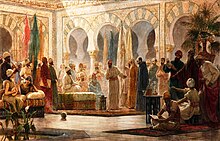
Umayyads expanded their Empire westwards capturing North Africa from the Byzantines. Before the Arab conquest, North Africa was conquered or settled by various people including Punics, Vandals and Romans. After the Abbasid Revolution, the Umayyads lost most of their territories with the exception of Iberia.
Their last holding became known as the Emirate of Córdoba. It was not until the rule of the grandson of the founder of this new emirate that the state entered a new phase as the Caliphate of Córdoba. This new state was characterized by an expansion of trade, culture and knowledge, and saw the construction of masterpieces of al-Andalus architecture and the library of Al-Ḥakam II which housed over 400,000 volumes. With the collapse of the Umayyad state in 1031 CE, Al-Andalus was divided into small kingdoms.[237]
Abbasid era (750–1258 and 1261–1517)
[edit]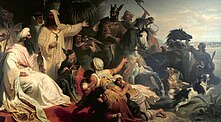
The Abbasids were the descendants of Abbas ibn Abd al-Muttalib, one of the youngest uncles of Muhammad and of the same Banu Hashim clan. The Abbasids led a revolt against the Umayyads and defeated them in the Battle of the Zab effectively ending their rule in all parts of the Empire with the exception of al-Andalus. In 762, the second Abbasid Caliph al-Mansur founded the city of Baghdad and declared it the capital of the Caliphate. Unlike the Umayyads, the Abbasids had the support of non-Arab subjects.[235] The Islamic Golden Age was inaugurated by the middle of the 8th century by the ascension of the Abbasid Caliphate and the transfer of the capital from Damascus to the newly founded city of Baghdad. The Abbasids were influenced by the Quranic injunctions and hadith such as "The ink of the scholar is more holy than the blood of martyrs" stressing the value of knowledge.
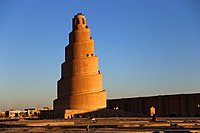
During this period the Arab Empire became an intellectual centre for science, philosophy, medicine and education as the Abbasids championed the cause of knowledge and established the "House of Wisdom" (Arabic: بيت الحكمة) in Baghdad. Rival dynasties such as the Fatimids of Egypt and the Umayyads of al-Andalus were also major intellectual centres with cities such as Cairo and Córdoba rivaling Baghdad.[238] The Abbasids ruled for 200 years before they lost their central control when Wilayas began to fracture in the 10th century; afterwards, in the 1190s, there was a revival of their power, which was ended by the Mongols, who conquered Baghdad in 1258 and killed the Caliph Al-Musta'sim. Members of the Abbasid royal family escaped the massacre and resorted to Cairo, which had broken from the Abbasid rule two years earlier; the Mamluk generals taking the political side of the kingdom while Abbasid Caliphs were engaged in civil activities and continued patronizing science, arts and literature.
Fatimid era (909–1171)
[edit]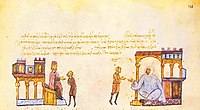
The Fatimid caliphate was founded by al-Mahdi Billah, a descendant of Fatimah, the daughter of Muhammad, the Fatimid Caliphate was a Shia that existed from 909 to 1171 CE. The empire was based in North Africa, with its capital in Cairo, and at its height, it controlled a vast territory that included parts of modern-day Egypt, Libya, Tunisia, Algeria, Morocco, Syria, and Palestine. The Fatimid state took shape among the Kutama, in the West of the North African littoral, in Algeria, in 909 conquering Raqqada, the Aghlabid capital. In 921 the Fatimids established the Tunisian city of Mahdia as their new capital. In 948 they shifted their capital to Al-Mansuriya, near Kairouan in Tunisia, and in 969 they conquered Egypt and established Cairo as the capital of their caliphate.
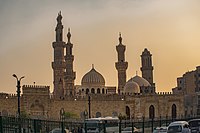
The Fatimids were known for their religious tolerance and intellectual achievements, they established a network of universities and libraries that became centers of learning in the Islamic world. They also promoted the arts, architecture, and literature, which flourished under their patronage. One of the most notable achievements of the Fatimids was the construction of the Al-Azhar Mosque and Al-Azhar University in Cairo. Founded in 970 CE, it is one of the oldest universities in the world and remains an important center of Islamic learning to this day. The Fatimids also had a significant impact on the development of Islamic theology and jurisprudence. They were known for their support of Shia Islam and their promotion of the Ismaili branch of Shia Islam. Despite their many achievements, the Fatimids faced numerous challenges during their reign. They were constantly at war with neighboring empires, including the Abbasid Caliphate and the Byzantine Empire. They also faced internal conflicts and rebellions, which weakened their empire over time. In 1171 CE, the Fatimid Caliphate was conquered by the Ayyubid dynasty, led by Saladin. Although the Fatimid dynasty came to an end, its legacy continued to influence Arab-Islamic culture and society for centuries to come.[239]
Ottoman era (1517–1918)
[edit]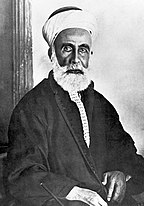
From 1517 to 1918, The Ottomans defeated the Mamluk Sultanate in Cairo, and ended the Abbasid Caliphate in the battles of Marj Dabiq and Ridaniya. They entered the Levant and Egypt as conquerors, and brought down the Abbasid caliphate after it lasted for many centuries. In 1911, Arab intellectuals and politicians from throughout the Levant formed al-Fatat ("the Young Arab Society"), a small Arab nationalist club, in Paris. Its stated aim was "raising the level of the Arab nation to the level of modern nations." In the first few years of its existence, al-Fatat called for greater autonomy within a unified Ottoman state rather than Arab independence from the empire. Al-Fatat hosted the Arab Congress of 1913 in Paris, the purpose of which was to discuss desired reforms with other dissenting individuals from the Arab world.[240] However, as the Ottoman authorities cracked down on the organization's activities and members, al-Fatat went underground and demanded the complete independence and unity of the Arab provinces.[241]

The Arab Revolt was a military uprising of Arab forces against the Ottoman Empire during World War I, began in 1916, led by Sherif Hussein bin Ali, the goal of the revolt was to gain independence for the Arab lands under Ottoman rule and to create a unified Arab state. The revolt was sparked by a number of factors, including the Arab desire for greater autonomy within the Ottoman Empire, resentment towards Ottoman policies, and the influence of Arab nationalist movements. The Arab Revolt was a significant factor in the eventual defeat of the Ottoman Empire. The revolt helped to weaken Ottoman military power and tie up Ottoman forces that could have been deployed elsewhere. It also helped to increase support for Arab independence and nationalism, which would have a lasting impact on the region in the years to come.[242][243] The Empire's defeat and the occupation of part of its territory by the Allied Powers in the aftermath of World War I, the Sykes–Picot Agreement had a significant impact on the Arab world and its people. The agreement divided the Arab territories of the Ottoman Empire into zones of control for France and Britain, ignoring the aspirations of the Arab people for independence and self-determination.[244]
Renaissance
[edit]The Golden Age of Arab Civilization known as the "Islamic Golden Age", traditionally dated from the 8th century to the 13th century.[245][246][247] The period is traditionally said to have ended with the collapse of the Abbasid caliphate due to Siege of Baghdad in 1258.[248] During this time, Arab scholars made significant contributions to fields such as mathematics, astronomy, medicine, and philosophy. These advancements had a profound impact on European scholars during the Renaissance.[249]
The Arabs shared its knowledge and ideas with Europe, including translations of Arabic texts.[250] These translations had a significant impact on culture of Europe, leading to the transformation of many philosophical disciplines in the medieval Latin world. Additionally, the Arabs made original innovations in various fields, including the arts, agriculture, alchemy, music, and pottery, and traditional star names such as Aldebaran, scientific terms like alchemy (whence also chemistry), algebra, algorithm, etc. and names of commodities such as sugar, camphor, cotton, coffee, etc.[251][252][253][254]
From the medieval scholars of the Renaissance of the 12th century, who had focused on studying Greek and Arabic works of natural sciences, philosophy, and mathematics, rather than on such cultural texts. Arab logician, most notably Averroes, had inherited Greek ideas after they had invaded and conquered Egypt and the Levant. Their translations and commentaries on these ideas worked their way through the Arab West into Iberia and Sicily, which became important centers for this transmission of ideas. From the 11th to the 13th century, many schools dedicated to the translation of philosophical and scientific works from Classical Arabic to Medieval Latin were established in Iberia, most notably the Toledo School of Translators. This work of translation from Arab culture, though largely unplanned and disorganized, constituted one of the greatest transmissions of ideas in history.[255]
During the Timurid Renaissance spanning the late 14th, the 15th, and the early 16th centuries, there was a significant exchange of ideas, art, and knowledge between different cultures and civilizations. Arab scholars, artists, and intellectuals played a role in this cultural exchange, contributing to the overall intellectual atmosphere of the time. They participated in various fields, including literature, art, science, and philosophy.[256] In the late 19th and early 20th centuries, the Arab Renaissance, also known as the Nahda, was a cultural and intellectual movement that emerged. The term "Nahda" means "awakening" or "renaissance" in Arabic, and refers to a period of renewed interest in Arabic language, literature, and culture.[257][258][259]
Modern period
[edit]
The modern period in Arab history refers to the time period from the late 19th century to the present day. During this time, the Arab world experienced significant political, economic, and social changes. One of the most significant events of the modern period was the collapse of the Ottoman Empire, the end of Ottoman rule led to the emergence of new nation-states in the Arab world.[260][261]
Sharif Hussein was supposed, in the event of the success of the Arab revolution and the victory of the Allies in World War I, to be able to establish an independent Arab state consisting of the Arabian Peninsula and the Fertile Crescent, including Iraq and the Levant. He aimed to become "King of the Arabs" in this state, however, the Arab revolution only succeeded in achieving some of its objectives, including the independence of the Hejaz and the recognition of Sharif Hussein as its king by the Allies.[262]
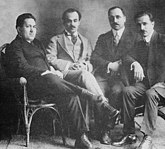
Arab nationalism emerged as a major movement in the early 20th century, with many Arab intellectuals, artists, and political leaders seeking to promote unity and independence for the Arab world.[264] This movement gained momentum after World War II, leading to the formation of the Arab League and the creation of several new Arab states. Pan-Arabism that emerged in the early 20th century and aimed to unite all Arabs into a single nation or state. It emphasized on a shared ancestry, culture, history, language and identity and sought to create a sense of pan-Arab identity and solidarity.[265][266]
The roots of pan-Arabism can be traced back to the Arab Renaissance or Al-Nahda movement of the late 19th century, which saw a revival of Arab culture, literature, and intellectual thought. The movement emphasized the importance of Arab unity and the need to resist colonialism and foreign domination. One of the key figures in the development of pan-Arabism was the Egyptian statesman and intellectual, Gamal Abdel Nasser, who led the 1952 revolution in Egypt and became the country's president in 1954. Nasser promoted pan-Arabism as a means of strengthening Arab solidarity and resisting Western imperialism. He also supported the idea of Arab socialism, which sought to combine pan-Arabism with socialist principles. Similar attempts were made by other Arab leaders, such as Hafiz al-Assad, Ahmed Hassan al-Bakr, Faisal I of Iraq, Muammar Gaddafi, Saddam Hussein, Gaafar Nimeiry and Anwar Sadat.[267]

Many proposed unions aimed to create a unified Arab entity that would promote cooperation and integration among Arab countries. However, the initiatives faced numerous challenges and obstacles, including political divisions, regional conflicts, and economic disparities.[268] The United Arab Republic (UAR) was a political union formed between Egypt and Syria in 1958, with the goal of creating a federal structure that would allow each member state to retain its identity and institutions. However, by 1961, Syria had withdrawn from the UAR due to political differences, and Egypt continued to call itself the UAR until 1971, when it became the Arab Republic of Egypt. In the same year the UAR was formed, another proposed political union, the Arab Federation, was established between Jordan and Iraq, but it collapsed after only six months due to tensions with the UAR and the 14 July Revolution. A confederation called the United Arab States, which included the UAR and the Mutawakkilite Kingdom of Yemen, was also created in 1958 but dissolved in 1961.[269] Later attempts to create a political and economic union among Arab countries included the Federation of Arab Republics, which was formed by Egypt, Libya, and Syria in the 1970s but dissolved after five years due to political and economic challenges. Muammar Gaddafi, the leader of Libya, also proposed the Arab Islamic Republic with Tunisia, aiming to include Algeria and Morocco,[270] instead the Arab Maghreb Union was formed in 1989.[271]
During the latter half of the 20th century, many Arab countries experienced political upheaval and conflicts, including, revolutions. The Arab-Israeli conflict remains a major issue in the region, and has resulted in ongoing tensions and periodic outbreaks of violence. In recent years, the Arab world has faced new challenges, including economic and social inequalities, demographic changes, and the impact of globalization.[272] The Arab Spring was a series of pro-democracy uprisings and protests that swept across several countries in the Arab world in 2010 and 2011. The uprisings were sparked by a combination of political, economic, and social grievances and called for democratic reforms and an end to authoritarian rule. While the protests resulted in the downfall of some long-time authoritarian leaders, they also led to ongoing conflicts and political instability in other countries.[273]
Identity
[edit]Arab identity is defined independently of religious identity, and pre-dates the spread of Islam, with historically attested Arab Christian kingdoms and Arab Jewish tribes. Today, however, most Arabs are Muslim, with a minority adhering to other faiths, largely Christianity, but also Druze and Baháʼí.[274][275] Paternal descent has traditionally been considered the main source of affiliation in the Arab world when it comes to membership into an ethnic group or clan.[276]
Arab identity is shaped by a range of factors, including ancestry, history, language, customs, and traditions.[277] Arab identity has been shaped by a rich history that includes the rise and fall of empires, colonization, and political turmoil. Despite the challenges faced by Arab communities, their shared cultural heritage has helped to maintain a sense of unity and pride in their identity.[278] Today, Arab identity continues to evolve as Arab communities navigate complex political, social, and economic landscapes. Despite this, the Arab identity remains an important aspect of the cultural and historical fabric of the Arab world, and continues to be celebrated and preserved by communities around the world.[279]
Subgroups
[edit]
Arab tribes are prevalent in the Arabian Peninsula, Mesopotamia, Levant, Egypt, Maghreb, the Sudan region and Horn Africa.[280][278][281]
The Arabs of the Levant are traditionally divided into Qays and Yaman tribes. The distinction between Qays and Yaman dates back to the pre-Islamic era and was based on tribal affiliations and geographic locations.; they include Banu Kalb, Kinda, Ghassanids, and Lakhmids.[282] The Qays were made up of tribes such as Banu Kilab, Banu Tayy, Banu Hanifa, and Banu Tamim, among others. The Yaman, on the other hand, were composed of tribes such as Banu Hashim, Banu Makhzum, Banu Umayya, and Banu Zuhra, among others.
There are also many Arab tribes indigenous to Mesopotamia (Iraq) and Iran, including from well before the Arab conquest of Persia in 633 CE.[283] The largest group of Iranian Arabs are the Ahwazi Arabs, including Banu Ka'b, Bani Turuf and the Musha'sha'iyyah sect. Smaller groups are the Khamseh nomads in Fars Province and the Arabs in Khorasan. As a result of the centuries-long Arab migration to the Maghreb, various Arab tribes (including Banu Hilal, Banu Sulaym and Maqil) also settled in the Maghreb and formed the sub-tribes which exist to present-day. The Banu Hilal spent almost a century in Egypt before moving to Libya, Tunisia and Algeria, and another century later moved to Morocco.[284]
According to Arab traditions, tribes are divided into different divisions called Arab skulls, which are described in the traditional custom of strength, abundance, victory, and honor. A number of them branched out, which later became independent tribes (sub-tribes). The majority of Arab tribes are descended from these major tribes.[285][286][287][288][289]
They are:[287]
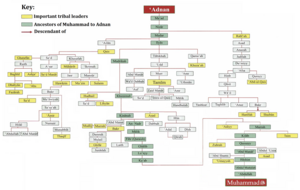
- Bakr, has descendants in Arabia and Iraq.[290]
- Kinanah, has descendants in Arabia, Iraq, Egypt, Sudan, Palestine, Tunisia, Morocco, and Syria.[291]
- Hawazin, has descendants in Arabia, Libya, Algeria, Morocco, Sudan, and Iraq.[292][293][294]
- Tamim, has descendants in Arabia, Iraq, Iran, Palestine, Algeria, and Morocco[295]
- Azd, has descendants in Arabia, Iraq, Levant, and North Africa.[296]
- Ghatafan, has descendants in Arabia and the Maghreb.[297]
- Madhhij, has descendants in Arabia and Iraq.[298]
- Abd al-Qays, has descendants in Arabia.
- Al Qays (القيس), has descendants in Arabia.
- Quda'a, has descendants in Arabia, Syria, and North Africa.
Geographic distribution
[edit]Arab homeland
[edit]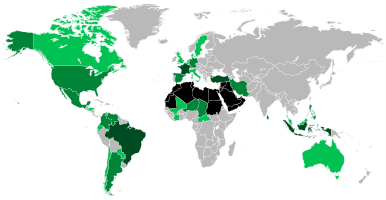
The total number of Arabs living in the Arab nations is estimated at 366 million by the CIA Factbook (as of 2014). The estimated number of Arabs in countries outside the Arab League is estimated at 17.5 million, yielding a total of close to 384 million. The Arab world stretches around 13,000,000 square kilometres (5,000,000 sq mi), from the Atlantic Ocean in the west to the Arabian Sea in the east and from the Mediterranean Sea in the north to the Horn of Africa and the Indian Ocean in the southeast.
Arab diaspora
[edit]Arab diaspora refers to descendants of the Arab immigrants who, voluntarily or as refugees, emigrated from their native lands in non-Arab countries, primarily in East Africa, South America, Europe, North America, Australia and parts of South Asia, Southeast Asia, the Caribbean, and West Africa. According to the International Organization for Migration, there are 13 million first-generation Arab migrants in the world, of which 5.8 million reside in Arab countries. Arab expatriates contribute to the circulation of financial and human capital in the region and thus significantly promote regional development. In 2009, Arab countries received a total of US$35.1 billion in remittance in-flows and remittances sent to Jordan, Egypt and Lebanon from other Arab countries are 40 to 190 per cent higher than trade revenues between these and other Arab countries.[299] The 250,000 strong Lebanese community in West Africa is the largest non-African group in the region.[300][301] Arab traders have long operated in Southeast Asia and along the East Africa's Swahili coast. Zanzibar was once ruled by Omani Arabs.[302] Most of the prominent Indonesians, Malaysians, and Singaporeans of Arab descent are Hadhrami people with origins in southern Arabia in the Hadramawt coastal region.[303]
Europe
[edit]There are millions of Arabs living in Europe, mostly concentrated in France (about 6,000,000 in 2005[304]). Most Arabs in France are from the Maghreb but some also come from the Mashreq areas of the Arab world. Arabs in France form the second largest ethnic group after French people.[305] In Italy, Arabs first arrived on the southern island of Sicily in the 9th century. The largest modern societies on the island from the Arab world are Tunisians and Moroccans, who make up 10.9% and 8% respectively of the foreign population of Sicily, which in itself constitutes 3.9% of the island's total population.[306] The modern Arab population of Spain numbers 1,800,000,[307][308][309][310] and there have been Arabs in Spain since the early 8th century when the Muslim conquest of Hispania created the state of Al-Andalus.[311][312][313] Arabs In Germany the Arab population numbers over 1,401,950.[314][315] in the United Kingdom between 366,769[316] and 500,000,[317] and in Greece between 250,000 and 750,000[318]). In addition, Greece is home to people from Arab countries who have the status of refugees (e.g. refugees of the Syrian civil war).[319] In the Netherlands 180,000,[38] and in Denmark 121,000. Other countries are also home to Arab populations, including Norway, Austria, Bulgaria, Switzerland, North Macedonia, Romania and Serbia.[320] As of late 2015, Turkey had a total population of 78.7 million, with Syrian refugees accounting for 3.1% of that figure based on conservative estimates. Demographics indicated that the country previously had 1,500,000[321] to 2,000,000 Arab residents,[12] Turkey's Arab population is now 4.5 to 5.1% of the total population, or approximately 4–5 million people.[12][322]
Americas
[edit]Arab immigration to the United States began in larger numbers during the 1880s, and today, an estimated 3.7 million Americans have some Arabic background.[14][323][324] Arab Americans are found in every state, but more than two thirds of them live in just ten states, and one-third live in Los Angeles, Detroit, and New York City specifically.[14][325] Most Arab Americans were born in the US, and nearly 82% of US-based Arabs are citizens.[326][327][328][329]
Arabs immigrants began to arrive in Canada in small numbers in 1882. Their immigration was relatively limited until 1945, after which time it increased progressively, particularly in the 1960s and thereafter.[330] According to the website "Who are Arab Canadians", Montreal, the Canadian city with the largest Arab population, has approximately 267,000 Arab inhabitants.[331]
Latin America has the largest Arab population outside of the Arab World.[332] Latin America is home to anywhere from 17–25 to 30 million people of Arab descent, which is more than any other diaspora region in the world.[333][334] The Brazilian and Lebanese governments claim there are 7 million Brazilians of Lebanese descent.[335][336] Also, the Brazilian government claims there are 4 million Brazilians of Syrian descent.[335][7][337][338][339][340] Other large Arab communities includes Argentina (about 3,500,000[15][341][342])
The interethnic marriage in the Arab community, regardless of religious affiliation, is very high; most community members have only one parent who has Arab ethnicity.[343] Colombia (over 3,200,000[344][345][346]), Venezuela (over 1,600,000),[25][347] Mexico (over 1,100,000),[348] Chile (over 800,000),[349][350][351] and Central America, particularly El Salvador, and Honduras (between 150,000 and 200,000).[352][31][32] Arab Haitians (257,000[353]) a large number of whom live in the capital are more often than not, concentrated in financial areas where the majority of them establish businesses.[354]
Caucasus
[edit]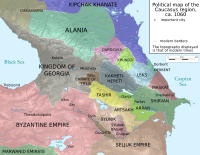
In 1728, a Russian officer described a group of Arab nomads who populated the Caspian shores of Mughan (in present-day Azerbaijan) and spoke a mixed Turkic-Arabic language.[355] It is believed that these groups migrated to the South Caucasus in the 16th century.[356] The 1888 edition of Encyclopædia Britannica also mentioned a certain number of Arabs populating the Baku Governorate of the Russian Empire.[357] They retained an Arabic dialect at least into the mid-19th century,[358] there are nearly 30 settlements still holding the name Arab (for example, Arabgadim, Arabojaghy, Arab-Yengija, etc.). From the time of the Arab conquest of the South Caucasus, continuous small-scale Arab migration from various parts of the Arab world occurred in Dagestan. The majority of these lived in the village of Darvag, to the north-west of Derbent. The latest of these accounts dates to the 1930s.[356] Most Arab communities in southern Dagestan underwent linguistic Turkicisation, thus nowadays Darvag is a majority-Azeri village.[359][360]
Central, South, East and Southeast Asia
[edit]According to the History of Ibn Khaldun, the Arabs that were once in Central Asia have been either killed or have fled the Tatar invasion of the region, leaving only the locals.[361] However, today many people in Central Asia identify as Arabs. Most Arabs of Central Asia are fully integrated into local populations, and sometimes call themselves the same as locals (for example, Tajiks, Uzbeks) but they use special titles to show their Arab origin such as Sayyid, Khoja or Siddiqui.[362]
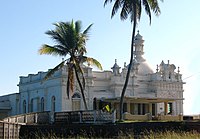
There are only two communities in India which claim Arab descent, the Chaush of the Deccan region and the Chavuse of Gujarat.[364][365] These groups are largely descended from Hadhrami migrants who settled in these two regions in the 18th century. However, neither community still speaks Arabic, although the Chaush have seen re-immigration to Eastern Arabia and thus a re-adoption of Arabic.[366] In South Asia, where Arab ancestry is considered prestigious, some communities have origin myths that claim Arab ancestry. Several communities following the Shafi'i madhab (in contrast to other South Asian Muslims who follow the Hanafi madhab) claim descent from Arab traders like the Konkani Muslims of the Konkan region, the Mappilla of Kerala, and the Labbai and Marakkar of Tamil Nadu and a few Christian groups in India that claim and have Arab roots are situated in the state of Kerala.[367] South Asian Iraqi biradri may have records of their ancestors who migrated from Iraq in historical documents. The Sri Lankan Moors are the third largest ethnic group in Sri Lanka, constituting 9.23% of the country's total population.[368] Some sources trace the ancestry of the Sri Lankan Moors to Arab traders who settled in Sri Lanka at some time between the 8th and 15th centuries.[369][370][371] There are about 118,866 Arab-Indonesians[372] of Hadrami descent in the 2010 Indonesian census.[373]
Sub-Saharan Africa
[edit]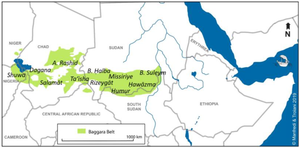
Afro-Arabs are individuals and groups from Africa who are of partial Arab descent. Most Afro-Arabs inhabit the Swahili Coast in the African Great Lakes region, although some can also be found in parts of the Arab world.[374][375] Large numbers of Arabs migrated to West Africa, particularly Côte d'Ivoire (home to over 100,000 Lebanese),[376] Senegal (roughly 30,000 Lebanese),[377] Sierra Leone (roughly 10,000 Lebanese today; about 30,000 prior to the outbreak of civil war in 1991), Liberia, and Nigeria.[378] Since the end of the civil war in 2002, Lebanese traders have become re-established in Sierra Leone.[379][380][381] The Arabs of Chad occupy northern Cameroon and Nigeria (where they are sometimes known as Shuwa), and extend as a belt across Chad and into Sudan, where they are called the Baggara grouping of Arab ethnic groups inhabiting the portion of Africa's Sahel. There are 171,000 in Cameroon, 150,000 in Niger[382]), and 107,000 in the Central African Republic.[383]
Religion
[edit]Arabs are mostly Muslims with a Sunni majority and a Shia minority, one exception being the Ibadis, who predominate in Oman.[384] Arab Christians generally follow Eastern Churches such as the Greek Orthodox and Greek Catholic churches, though a minority of Protestant Church followers also exists.[385] There are also Arab communities consisting of Druze and Baháʼís.[386][387] Historically, there were also sizeable populations of Arab Jews around the Arab World.
Before the coming of Islam, most Arabs followed a pagan religion with a number of deities, including Hubal,[388] Wadd, Allāt,[389] Manat, and Uzza. A few individuals, the hanifs, had apparently rejected polytheism in favor of monotheism unaffiliated with any particular religion. Some tribes had converted to Christianity or Judaism. The most prominent Arab Christian kingdoms were the Ghassanid and Lakhmid kingdoms.[390] When the Himyarite king converted to Judaism in the late 4th century,[391] the elites of the other prominent Arab kingdom, the Kindites, being Himyirite vassals, apparently also converted (at least partly). With the expansion of Islam, polytheistic Arabs were rapidly Islamized, and polytheistic traditions gradually disappeared.[392][393]
Today, Sunni Islam dominates in most areas, vastly so in Levant, North Africa, West Africa and the Horn of Africa. Shia Islam is dominant in Bahrain and southern Iraq while northern Iraq is mostly Sunni. Substantial Shia populations exist in Lebanon, Yemen, Kuwait, Saudi Arabia,[394] northern Syria and Al-Batinah Region in Oman. There are small numbers of Ibadi and non-denominational Muslims too.[384] The Druze community is concentrated in Levant.[395]
Christianity had a prominent presence In pre-Islamic Arabia among several Arab communities, including the Bahrani people of Eastern Arabia, the Christian community of Najran, in parts of Yemen, and among certain northern Arabian tribes such as the Ghassanids, Lakhmids, Taghlib, Banu Amela, Banu Judham, Tanukhids and Tayy. In the early Christian centuries, Arabia was sometimes known as Arabia heretica, due to its being "well known as a breeding-ground for heterodox interpretations of Christianity."[396] Christians make up 5.5% of the population of Western Asia and North Africa.[397] In Lebanon, Christians number about 40.5% of the population.[398] In Syria, Christians make up 10% of the population.[399] Christians in Palestine make up 8% and 0.7% of the populations, respectively.[400][401] In Egypt, Christians number about 10% of the population. In Iraq, Christians constitute 0.1% of the population.[402]
In Israel, Arab Christians constitute 2.1% (roughly 9% of the Arab population).[403] Arab Christians make up 8% of the population of Jordan.[404] Most North and South American Arabs are Christian,[405] so are about half of the Arabs in Australia who come particularly from Lebanon, Syria and Palestine. One well known member of this religious and ethnic community is Saint Abo, martyr and the patron saint of Tbilisi, Georgia.[406] Arab Christians also live in holy Christian cities such as Nazareth, Bethlehem and the Christian Quarter of the Old City of Jerusalem and many other villages with holy Christian sites.
Culture
[edit]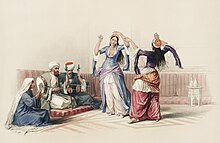
Arab culture is shaped by a long and rich history that spans thousands of years, from the Atlantic Ocean in the west to the Arabian Sea in the east, and from the Mediterranean Sea in the north to the Horn of Africa and the Indian Ocean in the southeast. The various religions the Arabs have adopted throughout their history and the various empires and kingdoms that have ruled and took lead of the Arabic civilization have contributed to the ethnogenesis and formation of modern Arab culture. Language, literature, gastronomy, art, architecture, music, spirituality, philosophy and mysticism are all part of the cultural heritage of the Arabs.[407]
Language
[edit]
Arabic is a Semitic language of the Afro-Asiatic Family.[408] The first evidence for the emergence of the language appears in military accounts from 853 BCE. Today it has developed widely used as a lingua franca for more than 500 million people. It is also a liturgical language for 1.7 billion Muslims.[409][410] Arabic is one of six official languages of the United Nations,[411] and is revered in Islam as the language of the Quran.[409][412]
Arabic has two main registers. Classical Arabic is the form of the Arabic language used in literary texts from Umayyad and Abbasid times (7th to 9th centuries). It is based on the medieval dialects of Arab tribes. Modern Standard Arabic (MSA) is the direct descendant used today throughout the Arab world in writing and in formal speaking, for example, prepared speeches, some radio broadcasts, and non-entertainment content,[413] while the lexis and stylistics of Modern Standard Arabic are different from Classical Arabic. There are also various regional dialects of colloquial spoken Arabic that both vary greatly from both each other and from the formal written and spoken forms of Arabic.[414]
Mythology
[edit]
Arabic mythology comprises the ancient beliefs of the Arabs. Prior to Islam the Kaaba of Mecca was covered in symbols representing the myriad demons, djinn, demigods, or simply tribal gods and other assorted deities which represented the polytheistic culture of pre-Islamic. It has been inferred from this plurality an exceptionally broad context in which mythology could flourish.[415][416]
The most popular beasts and demons of Arabian mythology are Bahamut, Dandan, Falak, Ghoul, Hinn, Jinn, Karkadann, Marid, Nasnas, Qareen, Roc, Shadhavar, Werehyena and other assorted creatures which represented the profoundly polytheistic environment of pre-Islamic.[417]
The most prominent symbol of Arabian mythology is the Jinn or genie.[418] Jinns are supernatural beings that can be good or evil.[419][420] They are not purely spiritual, but are also physical in nature, being able to interact in a tactile manner with people and objects and likewise be acted upon. The jinn, humans, and angels make up the known sapient creations of God.[421]
Ghouls also feature in the mythology as a monster or evil spirit associated with graveyards and consuming human flesh.[422][423] In Arabic folklore, ghouls belonged to a diabolic class of jinn and were said to be the offspring of Iblīs, the prince of darkness in Islam. They were capable of constantly changing form, but always retained donkey's hooves.[424]
Literature
[edit]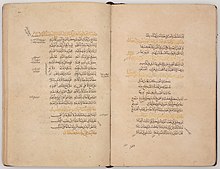
The Quran, the main holy book of Islam, had a significant influence on the Arabic language, and marked the beginning of Arabic literature. Muslims believe it was transcribed in the Arabic dialect of the Quraysh, the tribe of Muhammad.[425][426] As Islam spread, the Quran had the effect of unifying and standardizing Arabic.[425]
Not only is the Quran the first work of any significant length written in the language, but it also has a far more complicated structure than the earlier literary works with its 114 suwar (chapters) which contain 6,236 ayat (verses). It contains injunctions, narratives, homilies, parables, direct addresses from God, instructions and even comments on how the Quran will be received and understood. It is also admired for its layers of metaphor as well as its clarity, a feature which is mentioned in An-Nahl, the 16th surah.
Al-Jahiz (born 776, in Basra – December 868/January 869) was an Arab prose writer and author of works of literature, Mu'tazili theology, and politico-religious polemics. A leading scholar in the Abbasid Caliphate, his canon includes two hundred books on various subjects, including Arabic grammar, zoology, poetry, lexicography, and rhetoric. Of his writings, only thirty books survive. Al-Jāḥiẓ was also one of the first Arabian writers to suggest a complete overhaul of the language's grammatical system, though this would not be undertaken until his fellow linguist Ibn Maḍāʾ took up the matter two hundred years later.[427]
There is a small remnant of pre-Islamic poetry, but Arabic literature predominantly emerges in the Middle Ages, during the Golden Age of Islam.[428] Imru' al-Qais was a king and poet in the 6th century, he was the last king of Kindite. He is among the finest Arabic poetry to date, as well sometimes considered the father of Arabic poetry.[429] Kitab al-Aghani by Abul-Faraj was called by the 14th-century historian Ibn Khaldun the register of the Arabs.[430] Literary Arabic is derived from Classical Arabic, based on the language of the Quran as it was analyzed by Arabic grammarians beginning in the 8th century.[431]

A large portion of Arabic literature before the 20th century is in the form of poetry, and even prose from this period is either filled with snippets of poetry or is in the form of saj or rhymed prose.[432] The ghazal or love poem had a long history being at times tender and chaste and at other times rather explicit.[433] In the Sufi tradition the love poem would take on a wider, mystical and religious importance.
Arabic epic literature was much less common than poetry, and presumably originates in oral tradition, written down from the 14th century or so. Maqama or rhymed prose is intermediate between poetry and prose, and also between fiction and non-fiction.[434] Maqama was an incredibly popular form of Arabic literature, being one of the few forms which continued to be written during the decline of Arabic in the 17th and 18th centuries.[435]
Arabic literature and culture declined significantly after the 13th century, to the benefit of Turkish and Persian. A modern revival took place beginning in the 19th century, alongside resistance against Ottoman rule. The literary revival is known as al-Nahda in Arabic, and was centered in Egypt and Lebanon. Two distinct trends can be found in the nahda period of revival.[436]
The first was a neo-classical movement which sought to rediscover the literary traditions of the past, and was influenced by traditional literary genres—such as the maqama—and works like One Thousand and One Nights. In contrast, a modernist movement began by translating Western modernist works—primarily novels—into Arabic.[437] A tradition of modern Arabic poetry was established by writers such as Francis Marrash, Ahmad Shawqi and Hafiz Ibrahim. Iraqi poet Badr Shakir al-Sayyab is considered to be the originator of free verse in Arabic poetry.[438][439][440]
Cuisine
[edit]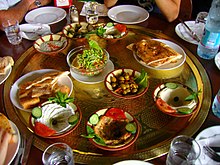
Arab cuisine is largely divided into Khaleeji cuisine, Levantine cuisine and Maghrebi cuisine.[441] Arab cuisine has influenced other cuisines various cultures, including Ottoman, Persian, and Andalusian.
It is characterized by a variety of herbs and spices, including cumin, coriander, cinnamon, sumac, za'atar, cardamom, mint, saffron, sesame, thyme turmeric and parsley.[442][443] Arab cuisine is also known for its sweets and desserts, such as Knafeh, Baklava, Halva, and Qatayef. Arabic coffee, or qahwa, is a traditional drink that is served with dates.
Art
[edit]Arabic art has taken various forms, including, among other things, jewelry, textiles and architecture.[444][445] Arabic script has also traditionally been heavily embellished with often colorful Arabic calligraphy, with one notable and widely used example being Kufic script.[446] Arabic miniatures (Arabic: الْمُنَمْنَمَات الْعَرَبِيَّة, Al-Munamnamāt al-ʿArabīyah) are small paintings on paper, usually book or manuscript illustrations but also sometimes separate artworks that occupy entire pages. The earliest example dates from around 690 CE, with a flourishing of the art from between 1000 and 1200 CE in the Abbasid caliphate. The art form went through several stages of evolution while witnessing the fall and rise of several Arab caliphates.
Arab miniaturists got totally assimilated and subsequently disappeared due to the Ottoman occupation of the Arab world. Nearly all forms of Islamic miniatures (Persian miniatures, Ottoman miniatures and Mughal miniatures) owe their existences to Arabic miniatures, as Arab patrons were the first to demand the production of illuminated manuscripts in the Caliphate, it was not until the 14th century that the artistic skill reached the non-Arab regions of the Caliphate.[447][448][449][450][451]
Despite the considerable changes in Arabic miniature style and technique, even during their last decades, the early Umayyad Arab influence could still be noticed. Arabic miniature artists include Ismail al-Jazari, who illustrated his own Book of Knowledge of Ingenious Mechanical Devices.[452]
The Abbasid artist, Yahya Al-Wasiti, who probably lived in Baghdad in the late Abbasid era (12th to 13th-centuries), was one of the pre-eminent exponents of the Baghdad school. In the period 1236–1237, he transcribed and illustrated the book Maqamat (also known as the Assemblies or the Sessions), a series of anecdotes of social satire written by Al-Hariri of Basra.[453] The narrative concerns the travels of a middle-aged man as he uses his charm and eloquence to swindle his way across the Arabic world.[454]

With most surviving Arabic manuscripts in western museums,[455] Arabic miniatures occupy very little space in modern Arab culture.[456] Arabesque is a form of artistic decoration consisting of "surface decorations based on rhythmic linear patterns of scrolling and interlacing foliage, tendrils" or plain lines,[457] often combined with other elements. Another definition is "Foliate ornament, typically using leaves, derived from stylised half-palmettes, which were combined with spiralling stems".[458] It usually consists of a single design which can be 'tiled' or seamlessly repeated as many times as desired.[459][460]
Architecture
[edit]The Arab world is home to around 8%[461] of UNESCO World Heritage Sites (List of World Heritage Sites in the Arab states). The oldest examples of architecture include those of pre-Islamic Arabia,[462] as well as Nabataean architecture that developed in the ancient kingdom of the Nabataeans, a nomadic Arab tribe that controlled a significant portion of the Middle East from the 4th century BCE to the 2nd century CE.[463][464] The Nabataeans were known for their skill in carving out elaborate buildings, tombs, and other structures from the sandstone cliffs of the region. One of the most famous examples of Nabataean architecture is the city of Petra, which is located in modern-day Jordan, was the capital of the Nabataean kingdom and is renowned for its impressive rock-cut architecture.[465]
Prior to the start of the Arab conquests, Arab tribal client states, the Lakhmids and Ghassanids, were located on the borders of the Sassanid and Byzantine empires and were exposed to the cultural and architectural influences of both.[466][467] They most likely played a significant role in transmitting and adapting the architectural traditions of these two empires to the later Arab Islamic dynasties.[468][469]
The Arab empire expanded rapidly, and with it, came a diverse range of architectural influences. One of the most notable architectural achievements of the Arab Empire is the Great Mosque of Damascus in Syria, which was built in the early 8th century, was constructed on the site of a Christian basilica and incorporated elements of Byzantine and Roman architecture, such as arches, columns, and intricate mosaics. Another important architectural is the Al-Aqsa Mosque in Jerusalem, which was built in the late 7th century. The mosque features an impressive dome and a large prayer hall, as well as intricate geometric patterns and calligraphy on the walls.[470][471]
Music
[edit]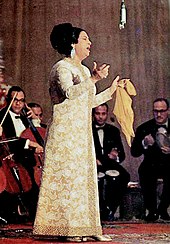
Arabic music, while independent and flourishing in the 2010s, has a long history of interaction with many other regional musical styles and genres. It is an amalgam of the music of the Arab people in the Arabian Peninsula and the music of all the peoples that make up the Arab world today.[473] Pre-Islamic Arab music was similar to that of Ancient Middle Eastern music. Most historians agree that there existed distinct forms of music in the Arabian peninsula in the pre-Islamic period between the 5th and 7th century CE. Arab poets of that "Jahili poets", meaning "the poets of the period of ignorance"—used to recite poems with a high notes.[474] It was believed that Jinns revealed poems to poets and music to musicians.[474] By the 11th century, Islamic Iberia had become a center for the manufacture of instruments. These goods spread gradually throughout France, influencing French troubadours, and eventually reaching the rest of Europe. The English words lute, rebec, and naker are derived from Arabic oud, rabab, and naqareh.[475][476]
A number of musical instruments used in classical music are believed to have been derived from Arabic musical instruments: the lute was derived from the Oud, the rebec (ancestor of violin) from the Maghreb rebab, the guitar from qitara, which in turn was derived from the Persian Tar, naker from naqareh, adufe from al-duff, alboka from al-buq, anafil from al-nafir, exabeba from al-shabbaba (flute), atabal (bass drum) from al-tabl, atambal from al-tinbal,[477] the balaban, the castanet from kasatan, sonajas de azófar from sunuj al-sufr, the conical bore wind instruments,[478] the xelami from the sulami or fistula (flute or musical pipe),[479] the shawm and dulzaina from the reed instruments zamr and al-zurna,[480] the gaita from the ghaita, rackett from iraqya or iraqiyya,[481] geige (violin) from ghichak,[482] and the theorbo from the tarab.[483]
During the 1950s and the 1960s, Arabic music began to take on a more Western tone – artists Umm Kulthum, Abdel Halim Hafez, and Shadia along with composers Mohamed Abd al-Wahab and Baligh Hamdi pioneered the use of western instruments in Egyptian music. By the 1970s several other singers had followed suit and a strand of Arabic pop was born. Arabic pop usually consists of Western styled songs with Arabic instruments and lyrics. Melodies are often a mix between Eastern and Western. Beginning in the mid-1980s, Lydia Canaan, musical pioneer widely regarded as the first rock star of the Middle East[484][485]
Spirituality
[edit]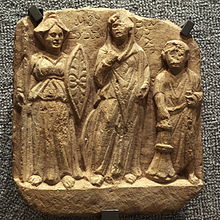
Arab polytheism was the dominant religion in pre-Islamic Arabia. Gods and goddesses, including Hubal and the goddesses al-Lāt, Al-'Uzzá and Manāt, were worshipped at local shrines, such as the Kaaba in Mecca, whilst Arabs in the south, in what is today's Yemen, worshipped various gods, some of which represented the Sun or Moon. Different theories have been proposed regarding the role of Allah in Meccan religion.[486][487][488] Many of the physical descriptions of the pre-Islamic gods are traced to idols, especially near the Kaaba, which is said to have contained up to 360 of them.[489] Until about the fourth century, almost all Arabs practised polytheistic religions.[490] Although significant Jewish and Christian minorities developed, polytheism remained the dominant belief system in pre-Islamic Arabia.[491]
The religious beliefs and practices of the nomadic bedouin were distinct from those of the settled tribes of towns such as Mecca.[492] Nomadic religious belief systems and practices are believed to have included fetishism, totemism and veneration of the dead but were connected principally with immediate concerns and problems and did not consider larger philosophical questions such as the afterlife.[492] Settled urban Arabs, on the other hand, are thought to have believed in a more complex pantheon of deities.[492] While the Meccans and the other settled inhabitants of the Hejaz worshipped their gods at permanent shrines in towns and oases, the bedouin practised their religion on the move.[493]
Most notable Arab gods and goddesses: 'Amm, A'ra, Abgal, Allah, Al-Lat, Al-Qaum, Almaqah, Anbay, ʿAṯtar, Basamum, Dhu l-Khalasa, Dushara, Haukim, Hubal, Isāf and Nā'ila, Manaf, Manāt, Nasr, Nuha, Quzah, Ruda, Sa'd, Shams, Samas, Syn, Suwa', Ta'lab, Theandrios, al-‘Uzzá, Wadd, Ya'uq, Yaghūth, Yatha, Aglibol, Astarte, Atargatis, Baalshamin, Bēl, Bes, Ēl, Ilāh, Inanna/Ishtar, Malakbel, Nabū, Nebo, Nergal, Yarhibol.
Philosophy
[edit]The philosophical thought in the Arab world is heavily influenced by Arabic Philosophy. Schools of Arabic/Islamic thought include Avicennism and Averroism. The first great Arab thinker in the Islamic tradition is widely regarded to be al-Kindi (801–873 A.D.), a Neo-Platonic philosopher, mathematician and scientist who lived in Kufa and Baghdad (modern day Iraq). After being appointed by the Abbasid Caliphs to translate Greek scientific and philosophical texts into Arabic, he wrote a number of original treatises of his own on a range of subjects, from metaphysics and ethics to mathematics and pharmacology.[494]
Much of his philosophical output focuses on theological subjects such as the nature of God, the soul and prophetic knowledge. Doctrines of the Arabic philosophers of the 9th–12th century who influenced medieval Scholasticism in Europe. The Arabic tradition combines Aristotelianism and Neoplatonism with other ideas introduced through Islam. Influential thinkers include the non-Arabs al-Farabi and Avicenna. The Arabic philosophic literature was translated into Hebrew and Latin, this contributed to the development of modern European philosophy. The Arabic tradition was developed by Moses Maimonides and Ibn Khaldun.[495][496]
Science
[edit]
Arabic science underwent considerable development during the Middle Ages (8th to 13th centuries CE), a source of knowledge that later spread throughout Medieval Europe and greatly influenced both medical practice and education. The language of recorded science was Arabic. Scientific treatises were composed by thinkers originating from across the Muslim world. These accomplishments occurred after Muhammad united the Arab tribes and the spread of Islam beyond the Arabian peninsula.[497]
Within a century after Muhammed's death (632 CE), an empire ruled by Arabs was established. It encompassed a large part of the planet, stretching from southern Europe to North Africa to Central Asia and on to India. In 711 CE, Arab Muslims invaded southern Spain; al-Andalus was a center of Arabic scientific accomplishment. Soon after, Sicily too joined the greater Islamic world. Another center emerged in Baghdad from the Abbasids, who ruled part of the Islamic world during a historic period later characterized as the "Golden Age" (~750 to 1258 CE).[498]
This era can be identified as the years between 692 and 945,[499] and ended when the caliphate was marginalized by local Muslim rulers in Baghdad – its traditional seat of power. From 945 onward until the sacking of Baghdad by the Mongols in 1258, the Caliph continued on as a figurehead, with power devolving more to local subordinates.[500] The pious scholars of Islam, men and women collectively known as the ulama, were the most influential element of society in the fields of Sharia law, speculative thought and theology.[501] Arabic scientific achievement is not as yet fully understood, but is very large.[502] These achievements encompass a wide range of subject areas, especially mathematics, astronomy, and medicine.[502] Other subjects of scientific inquiry included physics, alchemy and chemistry, cosmology, ophthalmology, geography and cartography, sociology, and psychology.[503]

Al-Battani was an astronomer, astrologer and mathematician of the Islamic Golden Age. His work is considered instrumental in the development of science and astronomy. One of Al-Battani's best-known achievements in astronomy was the determination of the solar year as being 365 days, 5 hours, 46 minutes and 24 seconds which is only 2 minutes and 22 seconds off.[504] In mathematics, al-Battānī produced a number of trigonometrical relationships.[504] Al-Zahrawi, regarded by many as the greatest surgeon of the Middle Ages.[505] His surgical treatise "De chirurgia" is the first illustrated surgical guide ever written. It remained the primary source for surgical procedures and instruments in Europe for the next 500 years.[506] The book helped lay the foundation to establish surgery as a scientific discipline independent from medicine, earning al-Zahrawi his name as one of the founders of this field.[507]
Other notable Arabic contributions include among other things: the pioneering of organic chemistry by Jābir ibn Hayyān,[508] establishing the science of cryptology and cryptanalysis by al-Kindi,[509][510][511] the development of analytic geometry by Ibn al-Haytham,[512][513] who has been described as the "world's first true scientist",[514] the discovery of the pulmonary circulation by Ibn al-Nafis,[515][516] the discovery of the itch mite parasite by Ibn Zuhr,[517][page needed] the first use of irrational numbers as an algebraic objects by Abū Kāmil,[518] the first use of the positional decimal fractions by al-Uqlidisi,[519][520] the development of the Arabic numerals and an early algebraic symbolism in the Maghreb,[521][522] the Thabit number and Thābit theorem by Thābit ibn Qurra,[523] the discovery of several new trigonometric identities by Ibn Yunus and al-Battani,[524][525] the mathematical proof for Ceva's theorem by Ibn Hűd,[526] the invention of the equatorium by al-Zarqali,[527] the discovery of the physical reaction by Avempace,[528] the identification of more than 200 new plants by Ibn al-Baitar[529] the Arab Agricultural Revolution, and the Tabula Rogeriana, which was the most accurate world map in pre-modern times by al-Idrisi.[530]
Several universities and educational institutions of the Arab world such as the University of Al Quaraouiyine, Al Azhar University, and Al Zaytuna University are considered to be the oldest in the world. Founded by Fatima al Fihri in 859 as a mosque, the University of Al Quaraouiyine in Fez is the oldest existing, continually operating and the first degree awarding educational institution in the world according to UNESCO and Guinness World Records[531][532] and is sometimes referred to as the oldest university.[533]
There are many scientific Arabic loanwords in Western European languages, including English, mostly via Old French.[534] This includes traditional star names such as Aldebaran, scientific terms like alchemy (whence also chemistry), algebra, algorithm, alcohol, alkali, cipher, zenith, etc.
Under Ottoman rule, cultural life and science in the Arab world declined. In the 20th and 21st centuries, Arabs who have won important science prizes include Ahmed Zewail and Elias Corey (Nobel Prize), Michael DeBakey and Alim Benabid (Lasker Award), Omar M. Yaghi (Wolf Prize), Huda Zoghbi (Shaw Prize), Zaha Hadid (Pritzker Prize), and Michael Atiyah (both Fields Medal and Abel Prize). Rachid Yazami was one of the co-inventors of the lithium-ion battery,[535] and Tony Fadell was important in the development of the iPod and the iPhone.[536]
Theatre
[edit]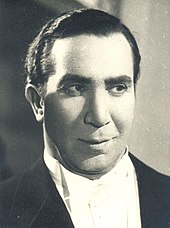
Arab theatre is a rich and diverse cultural form that encompasses a wide range of styles, genres, and historical influences. Its roots in the pre-Islamic era, when poetry, storytelling, and musical performances were the main forms of artistic expressionIt refers to theatrical performances that are created by Arab playwrights, actors, and directors. The roots of Arab theatre can be traced back to ancient Arabic poetry and storytelling, which often incorporated music and dance. In the early Arabic period, storytelling evolved into a more formalized art form that was performed in public gatherings and festivals.[537][538]
During the Islamic Golden Age in the 8th and 9th centuries, the city of Baghdad emerged as a hub of intellectual and artistic activity, including theatre. The court of the Abbasid Caliphate was home to many influential playwrights and performers, who helped to develop and popularize theatre throughout the Islamic world. Arab theatre has a long tradition of incorporating comedy and satire into its performances, often using humor to address social and political issues.[539]
Arab theatre encompasses a wide range of dramatic genres, including tragedy, melodrama, and historical plays. Many Arab playwrights have used drama to address contemporary issues, the role of women in Arab society, and the challenges facing young people in the modern world. In recent decades, many Arab theatre artists have pushed the boundaries of the form, experimenting with new styles and techniques. This has led to the emergence of a vibrant contemporary theatre scene in many Arab countries, with innovative productions and performances that challenge traditional notions of Arab identity and culture.[540]
Fashion
[edit]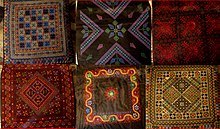
Arab fashion and design have a rich history and cultural significance that spans centuries, each with its unique fashion and design traditions. One of the most notable aspects of Arab fashion is the use of luxurious fabrics and intricate embroidery. Traditional garments, such as the Abaya and Thobe, are often made from high-quality fabrics like silk, satin, brocade, and are embellished with intricate embroidery and beading.[541] In recent years, Arab fashion has gained global recognition, with designers like Elie Saab, Zuhair Murad, and Reem Acra showcasing their designs on international runways.[542]
These designers incorporate traditional Arab design elements into their collections, such as ornate patterns, luxurious fabrics, and intricate embellishments. In addition to fashion, Arab design is also characterized by its intricate geometric patterns, calligraphy, and use of vibrant colors. Arabic art and architecture, with their intricate geometric patterns and motifs, have influenced Arab design for centuries.[543] Arab designers also incorporate traditional motifs, such as the paisley and the arabesque, into their work. Overall, Arab fashion elements are rooted in the rich cultural heritage of the Arab world and continue to inspire designers today.[544]
Wedding and marriage
[edit]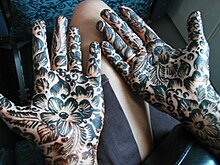
Arabic weddings have changed greatly in the past 100 years. Original traditional Arabic weddings are supposed to be very similar to modern-day Bedouin weddings and rural weddings, and they are in some cases unique from one region to another, even within the same country. The practice of marrying of relatives is a common feature of Arab culture.[545]
In the Arab world today between 40% and 50% of all marriages are consanguineous or between close family members, though these figures may vary among Arab nations.[546][547] In Egypt, around 40% of the population marry a cousin. A 1992 survey in Jordan found that 32% were married to a first cousin; a further 17.3% were married to more distant relatives.[548] 67% of marriages in Saudi Arabia are between close relatives as are 54% of all marriages in Kuwait, whereas 18% of all Lebanese were between blood relatives.[549] Due to the actions of Muhammad and the Rightly Guided Caliphs, marriage between cousins is explicitly allowed in Islam and the Quran itself does not discourage or forbid the practice.[550] Nevertheless, opinions vary on whether the phenomenon should be seen as exclusively based on Islamic practices as a 1992 study among Arabs in Jordan did not show significant differences between Christian Arabs or Muslim Arabs when comparing the occurrence of consanguinity.[549]
Genetics
[edit]Arabs are genetically diverse, arising from admixture with indigenous peoples of pre-Islamic Middle East and North Africa, following the Islamic expansion.[551][552] Genetic ancestry components related to the Arabian Peninsula display an increasing frequency pattern from west to east over North Africa. A similar frequency pattern exist across northeastern Africa with decreasing genetic affinities to groups of the Arabian Peninsula along the Nile river valley across Sudan and South Sudan the more they go south.[553] This genetic cline of admixture is dated to the time of Arab expansion and immigration to the Maghreb and northeast Africa.[553] Genetic research has indicated that Palestinian Arabs and Jews share common genetic ancestry and are closely related.[554][555][556][557][558][559][560][561] According to a 2016 study, indigenous Arabs from the Arabian Peninsula are direct descendants of the first Eurasian populations established by Out of Africa migrations. They are also very distant from contemporary Eurasians although there is signal of European admixture.[562]
See also
[edit]References
[edit]Notes
[edit]- ^ Including 1–2 million native Arabs[12] and 3,763,565 registered Syrian refugees.[13]
- ^ singular: Arab; singular Arabic: عَرَبِيٌّ, DIN 31635 (Classical Arabic): ʿarabiyyun, Arabic pronunciation: [ʕɑ.rɑˈbɪj.jʊn]
- ^ Sources stating Arabs are an ethnic group:[56][57][58][59][60][61][62][63][64][65][66][67][68][69][70][71]
- Arabs share a strong bond through their ethnic, linguistic, and cultural heritage. This connection encompasses their history, nationalism, and geographic ties. Religion also influences it, contributing to its distinct customs, arts, cuisine, and societal identity.[72][73]
- Arab identity concentrating on ethnic identity is another way of defining Arab identity, which can be subdivided into linguistic, cultural, social, historical, political, national, or genealogical terms.
Citations
[edit]- ^ Lorenzo Kamel (31 March 2017). The Frailty of Authority: Borders, Non-State Actors and Power Vacuums in a Changing Middle East. Edizioni Nuova Cultura. p. 25. ISBN 978-88-6812-828-9.
- ^ Kail C. Ellis (12 January 2018). Secular Nationalism and Citizenship in Muslim Countries: Arab Christians in the Levant. Springer. p. 159. ISBN 978-3-319-71204-8.
- ^ Margaret K. Nydell (26 July 2018). Understanding Arabs: A Guide for Modern Times. John Murray Press. p. 11. ISBN 978-1-4736-9091-2.
- ^ Neil Caplan (4 September 2019). The Israel-Palestine Conflict: Contested Histories. John Wiley & Sons. p. 23. ISBN 978-1-119-52387-1.
- ^ a b total population 450 million; CIA Factbook2030 estimates an Arab population of 450 million, see article text.
- ^ a b "World Arabic Language Day | United Nations Educational, Scientific and Cultural Organization". Unesco.org. 15 December 2016. Retrieved 18 December 2017.
- ^ a b IBGE. IBGE | Biblioteca | Detalhes | Características étnico-raciais da população : classificações e identidades IBGE: Características Étnico-Raciais da População.
- ^ Silvia Ferabolli (25 September 2014). Arab Regionalism: A Post-Structural Perspective. Routledge. p. 151. ISBN 978-1-317-65803-0.
According to estimates by the Brazilian Institute of Geography and Statistics (IBGE), countersigned by the League of Arab States, Brazil has the largest Arab colony outside their countries of origin. There are estimated 15 million Arabs living in Brazil today, with some researchers suggesting numbers around 20 million.
- ^ Paul Amar (15 July 2014). The Middle East and Brazil: Perspectives on the New Global South. Indiana University Press. p. 40. ISBN 978-0-253-01496-2.
there are, according to the Ministry of Foreign Affairs, more than sixteen million Arabs and descendants of Arabs in Brazil, constituting the largest community of Arabs descent outside the Middle East.
- ^ Crumley, Bruce (24 March 2009), "Should France Count Its Minority Population?", Time, retrieved 11 October 2014
- ^ "To count or not to count". The Economist. 26 March 2009. ISSN 0013-0613. Retrieved 30 January 2019.
- ^ a b c d "Turkey's demographic challenge". aljazeera.com.
- ^ "UNHCR Situation Syria Regional Refugee Response – Turkey". Government of Turkey. 11 November 2021. Retrieved 17 November 2021.
- ^ a b c "Demographics". Arab American Institute. Archived from the original on 23 October 2016. Retrieved 18 December 2017.
- ^ a b "Inmigración sirio-libanesa en Argentina" (in Spanish). Fearab.org.ar. Archived from the original on 20 June 2010. Retrieved 13 April 2010.
- ^ "Colombia y Medio Oriente". 26 April 2022. Retrieved 2 July 2022.
- ^ "Brazil-Arab News Agency – Colombia awakens to the Arab world". 6 July 2011. Archived from the original on 6 July 2011. Retrieved 17 June 2022.
- ^ Tiempo, Casa Editorial El (7 March 2019). "Los palestinos que encontraron un segundo hogar en el centro de Bogotá". El Tiempo (in Spanish). Retrieved 18 June 2022.
- ^ "Estimación de la mortalidad, 1985–2005" [Estimation of mortality, 1985–2005] (PDF). Postcensal Studies (in Spanish). Bogotá, Colombia: DANE. March 2010. Archived from the original (PDF) on 23 November 2007. Retrieved 29 March 2016.
- ^ "Proyecciones nacionales y departamentales de población. 2006–2020" [National and departmental population projections. 2006–2020] (PDF) (in Spanish). DANE National Statistical Service, Colombia. September 2007. Archived from the original (PDF) on 23 November 2007. Retrieved 22 September 2015.
- ^ "Demographic characteristics – definitions and explanations (translation from Hebrerw into English)". Israel Central Bureau of Statistics. Retrieved 6 January 2024.
- ^ "Chad". The World Factbook (2024 ed.). Central Intelligence Agency. Retrieved 3 April 2019. (Archived 2019 edition.)
- ^ "Iran". The World Factbook (2024 ed.). Central Intelligence Agency. Retrieved 3 August 2013. (Archived 2013 edition.)
- ^ "Arabs". Minority Rights Group. 19 June 2015. Retrieved 26 October 2023.
- ^ a b Margolis, Mac (15 September 2013). "Abdel el-Zabayar: From Parliament to the Frontlines". The Daily Beast.
- ^ "Anzahl der Ausländer in Deutschland nach Herkunftsland in den Jahren 2015 und 2016". statista (in German).
- ^ "Los musulmanes en España superan los 1,8 millones". europapress.es (in Spanish). 30 March 2015. Retrieved 25 April 2017.
- ^ Redaction (9 October 2012). "La cifra de musulmanes en España alcanza los 1,6 millones, de los que casi un tercio viven en Cataluña". alertadigital.com (in Spanish). Archived from the original on 1 December 2017. Retrieved 25 April 2017.
- ^ Sierra, Mauricio (16 June 2021). "Arab Ancestry in Latin America". Berkeley High Jacket. Archived from the original on 15 February 2022. Retrieved 15 February 2022.
Arab Mexicans are an important group within Mexican society. There are around 1,100,000 Mexican citizens of Arab descent, primarily of Lebanese, Syrian, Iraqi and Palestinian heritage.
- ^ "Aurora | Aurora". aurora-israel.co.il. Archived from the original on 18 March 2012.
- ^ a b "Chile: Palestinian refugees arrive to warm welcome". Adnkronos.com. 7 April 2003. Archived from the original on 19 September 2011. Retrieved 17 September 2011.
- ^ a b "500,000 descendientes de primera y segunda generación de palestinos en Chile". Laventana.casa.cult.cu. Archived from the original on 22 July 2009. Retrieved 17 September 2011.
- ^ "Canadian Arab Institute :: 750,925 Canadians Hail from Arab Lands". canadianarabinstitute.org. Archived from the original on 19 March 2017. Retrieved 19 October 2019.
- ^ "Cittadini stranieri in Italia – 2021". tuttitalia.it.
- ^ "Population by country of birth, age and sex. Year 2000 – 2020". Retrieved 19 September 2019.
- ^ Anthony McRoy. "The British Arab". National Association of British Arabs. Archived from the original on 3 January 2015. Retrieved 17 April 2012.
- ^ "australianarab.org/about-us". Archived from the original on 30 October 2016.
- ^ a b "Dutch media perceived as much more biased than Arabic media – Media & Citizenship Report conducted by University of Utrecht" (PDF), Utrecht University, 10 September 2010, archived from the original (PDF) on 28 February 2019, retrieved 29 November 2010
- ^ "Côte d'Ivoire". Minority Rights Group. 30 January 2018.
- ^ J. Espín-Ocampo (2020). Origen y evolución de la comunidad palestina en Chile. Vol. 1. pp. 113–132. doi:10.15359/ri.93-1.5. ISSN 1018-0583. S2CID 241082525.
{{cite book}}:|work=ignored (help) - ^ de 2020, 16 de Octubre (16 October 2020). "El Guayaquil que acogió a los migrantes extranjeros". El Telégrafo. Retrieved 16 April 2022.
{{cite web}}: CS1 maint: numeric names: authors list (link) - ^ "Africa | Niger's Arabs to fight expulsion". BBC News. 25 October 2006. Retrieved 1 June 2020.
- ^ "Demographics and Ethnic Groups of Denmark". WorldAtlas. 8 July 2019. Retrieved 27 October 2023.
- ^ Hartono, Sunaryati (2015). Analisis dan Evaluasi Peraturan Perundang-undangan Tentang Peninggalan Kolonial (Belanda dan Jepang) (PDF). Jakarta: Badan Pembinaan Hukum Nasional, Kementerian Hukum dan Hak Asasi Manusia RI. pp. 25–26. IOS1-INLIS000000000683886.
- ^ "Why So Many Palestinians Live In El Salvador | AJ+". newsvideo.su. Archived from the original on 13 November 2019. Retrieved 13 November 2019.
- ^ "Lebanese Diaspora Worldwide Geographical Distribution". Archived from the original on 14 February 2021. Retrieved 16 October 2018.
- ^ Zielger, Matthew. "El Salvador: Central American Palestine of the West?". The Daily Star. Retrieved 27 May 2015.
- ^ "AJ Plus: The Palestinians of El Salvador". Archived from the original on 13 November 2019. Retrieved 13 November 2019.
- ^ Dellios, Hugh. "El Salvador vote divides 2 Arab clans". Chicago Tribune.
- ^ "Languages of Eritrea". Ethnologue. Retrieved 21 October 2023.
- ^ de 2014, 25 de Junio (24 November 2017). "Más de 10 millones de libaneses empujan el crecimiento social y económico de América Latina". infobae (in European Spanish). Retrieved 15 February 2022.
{{cite web}}: CS1 maint: numeric names: authors list (link) - ^ "Tanzania History and Information – Safari Info for Tanzania". eyesonafrica.net. Archived from the original on 10 January 2020. Retrieved 28 May 2020.
- ^ "2019 Kenya Population and Housing Census Volume IV: Distribution of Population by Socio-Economic Characteristics" (PDF). Kenya National Bureau of Statistics. Archived (PDF) from the original on 9 October 2022. Retrieved 2 May 2021.
- ^ "Somalia", The World Factbook, Central Intelligence Agency, 17 October 2023, retrieved 22 October 2023
- ^ Mbarek, Hamdi; Ismail, Said I. (7 December 2022). "Mapping the Arab genome". Nature Genetics. 54 (12): 1761–1763. doi:10.1038/s41588-022-01239-0. ISSN 1061-4036. PMID 36446885.
- ^ Mackintosh-Smith, Tim (30 April 2019). Arabs: A 3,000-Year History of Peoples, Tribes and Empires. Yale University Press. ISBN 978-0-300-18235-4.
- ^ Levinson, David (1998). Ethnic Groups Worldwide: A Ready Reference Handbook. Oryx Press. ISBN 978-1-57356-019-1.
- ^ Shakry, Omnia El (20 October 2020). Understanding and Teaching the Modern Middle East. University of Wisconsin Pres. ISBN 978-0-299-32760-6.
- ^ Ahrari, Mohammed E. (1994). The Middle East in Transition: An Instructional Guide. Southern Center for International Studies. ISBN 978-0-935082-19-7.
- ^ Hitti, Philip K. (1996). The Arabs: a short history. Washington, D.C.: Regnery Pub. ISBN 0895267063.
- ^ Rogan, Eugene (2011). The Arabs: a history (1st pbk. ed.). New York, NY: Basic Books. ISBN 978-0465025046.
- ^ Hauss, Charles (July 2005). Ie Comparative Politics. Wadsworth. ISBN 978-0-495-06294-3.
- ^ F., Eickelman, Dale (September 2013). "Arabs (anthropology)". Encyclopaedia of Islam. Vol. Three.
{{cite encyclopedia}}: CS1 maint: multiple names: authors list (link) - ^ Shoup, John A. (31 October 2011). Ethnic Groups of Africa and the Middle East: An Encyclopedia. ABC-CLIO. ISBN 9781598843620.
- ^ Barakat, Halim (1993). The Arab world society, culture, and state. Berkeley: University of California Press. ISBN 0520914422.
- ^ Reynolds, Dwight F. (2 April 2015). The Cambridge Companion to Modern Arab Culture. Cambridge University Press. ISBN 9780521898072.
- ^ Jandt, Fred E. (2 February 2012). An Introduction to Intercultural Communication: Identities in a Global Community. SAGE Publications. ISBN 9781412992879.
- ^ Kreider, Kyle L.; Baldino, Thomas J. (2016). Minority voting in the United States. Santa Barbara: Praeger. ISBN 978-1440830242.
- ^ Epstein, Steven (2007). Purity Lost: Transgressing Boundaries in the Eastern Mediterranean, 1000–1400. JHU Press. ISBN 978-0-8018-8484-9.
- ^ "ʿARAB". Encyclopedia Iranica.
- ^ "Arabs". MSN Encarta. 28 October 2009. Archived from the original on 28 October 2009.
- ^ *
- ^
- "Culture and Tradition in the Arab Countries". habiba.org.
- "Arabic Culture & Traditions – Online Resources | Pimsleur Approach™". pimsleurapproach.com.
- El-Shamy, Hasan M. (1995). Folk traditions of the Arab world: a guide to motif classification (1. [Dr.]. ed.). Bloomington u.a.: Indiana Univ. Press. ISBN 0253352223.
- ^ Bureš, Jaroslav (2008). Main characteristic and development trends of migration in the Arab world. Prague: Institute of International Relations. ISBN 978-80-86506-71-5.
- ^ * "HISTORY OF THE ARABS". historyworld.net. Retrieved 1 May 2023.
- Eph'al, Israel (1982). The Ancient Arabs: nomads of the fertile crescent. Jerusalem Leiden: Magnes press Hebrew university E. J. Brill. ISBN 978-965-223-400-1.
- Mackintosh-Smith, Tim (30 April 2019). Arabs: A 3,000-Year History of Peoples, Tribes and Empires. Yale University Press. ISBN 978-0-300-18235-4.
- ^ * Myers, E. A. (11 February 2010). The Ituraeans and the Roman Near East: Reassessing the Sources. Cambridge University Press. p. 18. ISBN 978-1-139-48481-7.
- Hoyland, Robert G. (2001). Arabia and the Arabs. Routledge. pp. 11 METHODOLOGY (modern Saudi Arabia minus the east coast, the Sinai and Negev deserts, and parts of modern Jordan, Syria, and Iraq). ISBN 0-203-76392-0.
- ^ * Smith, Sylvia (21 May 2013). "Bahrain digs unveil one of oldest civilizations". BBC News. BBC.
- "Qal'at al-Bahrain – Ancient Harbour and Capital of Dilmun". UNESCO. Archived from the original on 5 April 2012. Retrieved 17 August 2011.
- ^ * Bowman, Alan K.; Champlin, Edward; Lintott, Andrew (8 February 1996). The Cambridge Ancient History. Cambridge University Press. ISBN 978-0-521-26430-3.
- Retsö, Jan (October 2010). "Arabs (historical)". Encyclopaedia of Islam, Three.
- "The origin of the word "Arab"". Ismaili.net. Retrieved 18 December 2017.
- ^ Werner Daum (1987). Yemen: 3000 Years of Art and Civilization in Arabia Felix. Pinguin-Verlag. p. 73. ISBN 3701622922.
- ^ Fisher, Greg; Wood, Philip (July 2015). Arabs and Empires before Islam. Oxford University Press. p. 368. ISBN 9780191799730. Retrieved 3 August 2023.
Origen, in the third century, was the first Christian to identify the Ishmaelites with the Arabs, but he only does so in a cursory fashion
- ^ "Thamud | History, Tribe, & Location | Britannica". britannica.com. Retrieved 7 April 2023.
- ^ Warwick Ball (2002). Rome in the East: The Transformation of an Empire. Routledge. p. 80. ISBN 9781134823871.
- ^ a b Berndt Schaller, Ituraea, p.1492.
- ^ de Jong, Albert (2013). "Hatra and the Parthian Commonwealth". Oriens et Occidens – Band 21: 143–161.
- Ellerbrock, Uwe (2021). The Parthians: The Forgotten Empire. Oxford: Routledge. ISBN 978-0367481902.
- ^ Jullien, Christelle (22 March 2018), "Beth 'Arabaye", The Oxford Dictionary of Late Antiquity, Oxford University Press, doi:10.1093/acref/9780198662778.001.0001, ISBN 978-0-19-866277-8, retrieved 20 April 2023
- ^ a b Jullien, Christelle (2018). "Beth 'Arabaye". In Nicholson, Oliver (ed.). The Oxford Dictionary of Late Antiquity. Oxford: Oxford University Press. ISBN 978-0-19-866277-8.
- ^ Bowman, Alan; Garnsey, Peter; Cameron, Averil (2005). The Cambridge Ancient History: Volume 12, The Crisis of Empire, AD 193–337. Cambridge University Press. ISBN 9780521301992.; Hornblower, Simon; Spawforth, Antony; Eidinow, Esther (2012). The Oxford Classical Dictionary. OUP Oxford. ISBN 9780199545568.; Burns, Jasper (2006). Great Women of Imperial Rome: Mothers and Wives of the Caesars. Routledge. ISBN 9781134131853.; Prado, Leonardo de Arrizabalaga y (2017). Varian Studies Volume One: Varius. Cambridge Scholars Publishing. ISBN 9781443893855.; Shahid, Irfan (1984). Rome and The Arabs: A Prolegomenon to the Study of Byzantium and the Arabs. Dumbarton Oaks. p. 37. ISBN 0884021157.; Freisenbruch, Annelise (2011). Caesars' Wives: Sex, Power, and Politics in the Roman Empire. Simon and Schuster. ISBN 9781416583059.
- ^ * Bowersock, G. W., Peter Brown and Oleg Grabar, eds. 1999. Late Antiquity: A Guide to the Postclassical World (2nd ed.). Cambridge, MA: Belknap Press. ISBN 978-0-674-51173-6.
- Cameron, Averil (29 April 2015). The Mediterranean World in Late Antiquity: AD 395–700. Routledge. ISBN 978-1-136-67305-4.
- "Lakhmids". Encyclopaedia Iranica. Retrieved 18 December 2017.
- ^ *"Islam, The Arab Empire Of The Umayyads". history-world.org. Archived from the original on 15 December 2014. Retrieved 21 January 2017.
- "The Arab Empire | Mohammed | Umayyad Empire History". Historybits.com. Retrieved 18 December 2017.
- "Top 10 Greatest Empires In History". Listverse. 22 June 2010.
- Pillalamarri, Akhilesh (22 February 2015). "The 5 Most Powerful Empires in History". The National Interest.
- "10 Greatest Empires in the History of World". Top Ten Lists. 24 March 2010. Archived from the original on 2 February 2017. Retrieved 24 January 2017.
- ^ *"The Arab Revolt, 1916–18 | The Ottoman Empire." New Zealand History. Ministry for Culture and Heritage. 30 July 2014.
- McMeekin, Sean. 2012. The Berlin–Baghdad Express. Belknap Press. ISBN 0-674-06432-1. pp. 288, 297.
- Rogan, Eugene L. (2004). Frontiers of the state in the late Ottoman Empire: Transjordan, 1850–1921. Cambridge University Press. ISBN 978-0-521-89223-0. OCLC 826413749.
- Ochsenwald, William L. 1968. "The Vilayet of Syria, 1901–1914: A Re-Examination of Diplomatic Documents As Sources." Middle East Journal 22(1). p. 73.*Arab League formed | This Day in History — 3/22/1945." HISTORY. US: A&E Television Networks. 2010. Retrieved on 28 April 2014.
- MacDonald, Robert W. (8 December 2015). The League of Arab States: A Study in Dynamics of Regional Organization. Princeton University Press. ISBN 978-1-4008-7528-3.
- Arab League from The Columbia Encyclopedia, 6th ed, archived from the original on 13 May 2019[ISBN missing]
- ^ *"Who is an Arab?". al-bab.com.
- Francis M. Deng (1 October 2011). War of Visions: Conflict of Identities in the Sudan. Brookings Institution Press. p. 405. ISBN 978-0-8157-2369-1.
- ^ Rabasa, Angel; Waxman, Matthew; Larson, Eric V.; Marcum, Cheryl Y. (17 November 2004). The Muslim World After 9/11. Rand Corporation. p. 31. ISBN 978-0-8330-3755-8.
- ^ *"Culture and Tradition in the Arab Countries". Habiba.org. Retrieved 18 December 2017.
- "Arabic Culture & Traditions". Pimsleur Approach. Retrieved 18 December 2017.[permanent dead link]
- El-Shamy, Hasan M. (1995). Folk traditions of the Arab world: A guide to motif classification. Vol. 2. Bloomington, IN: Indiana University Press. ISBN 978-0-253-35222-4.
- ^ * "Arab Civilization". Alhewar.org. Archived from the original on 24 October 2017. Retrieved 1 November 2017.
- Holt, P. M. 2013. Studies in the History of the Near East. p. 28. 113627331X: "He held the post until his death in 1624 and was succeeded by his former pupil, James Golius (1596–1667). Erpenius and Golius made outstanding contributions to the development of Arabic studies by their teaching, their preparation of texts,..."
- ^ * Porter Berkey, Jonathan (2003). The Formation of Islam: Religion and Society in the Near East, 600–1800. Cambridge University Press. p. 42. ISBN 978-0-521-58813-3.
- Robinson, Neal (2013). Islam: A Concise Introduction. Routledge. ISBN 978-1-136-81773-1.
- ^ "Arabs". Encyclopedia.com. 21 April 2018. Retrieved 9 May 2018.
- Phares, Walid (2001). "Arab Christians: An Introduction". Arabic Bible Outreach Ministry.
- "Majority and Minorities in the Arab World: The Lack of a Unifying Narrative". Jerusalem Center For Public Affairs.*"Religious Diversity Around The World – Pew Research Center". Pew Research Center's Religion & Public Life Project. 4 April 2014.
- ^ a b Retsö, Jan (2003). The Arabs in Antiquity: Their History from the Assyrians to the Umayyads. Psychology Press. ISBN 978-0-7007-1679-1. pp. 105, 119, 125–27.
- ^ Wehr, Hans, and J. M. Cowan. A Dictionary of Modern Written Arabic (3rd ed.) Ithaca, NY: Spoken Language Services. p. 601.
- ^ ABADY_Yemen_Archaeology_9_12. pp. 127, 128.
- ^ Bowden, William; Lavan, Luke; Machado, Carlos (2004). Recent Research on the Late Antique Countryside. Brill. p. 91. ISBN 978-90-04-13607-6.
- ^ Ira M. Lapidus (2014). A History of Islamic Societies. Cambridge University Press. p. 29. ISBN 978-0-521-51430-9.
- ^ Salles, Jean-François; Healey, J. F. (22 December 2015). "Arabs". Oxford Research Encyclopedia of Classics. doi:10.1093/acrefore/9780199381135.013.644. ISBN 978-0-19-938113-5.
- ^ "The meaning of Arab land in the historical sources". Archived from the original on 15 March 2010.
- ^ Gray, Louis Herbert (2006) Introduction to Semitic Comparative Linguistics
- ^ Courtenay, James John (2009) The Language of Palestine and Adjacent Regions
- ^ Kienast, Burkhart. (2001). Historische semitische Sprachwissenschaft
- ^ Bromiley, Geoffrey W. (1995) The International Standard Bible Encyclopedia
- ^ Murtonen, A. (1967). Early Semitic: A Diachronical Inquiry Into the Relationship of Ethiopic to the Other So-called South-East Semitic Languages. Brill Archive.
- ^ a b Postgate, J. N. (2007). Languages of Iraq, Ancient and Modern. British School of Archaeology in Iraq. ISBN 978-0-903472-21-0.
- ^ Jallad, Ahmad (2018). "The earliest stages of Arabic and its linguistic classification".
{{cite journal}}: Cite journal requires|journal=(help) - ^ Aaron D. Rubin (2008). "The subgrouping of the Semitic languages". Language and Linguistics Compass. 2 (1): 61–84. doi:10.1111/j.1749-818x.2007.00044.x.
- ^ Jallad, Ahmad (2018). "The earliest stages of Arabic and its linguistic classification". In Elabbas Benmamoun; Reem Bassiouney (eds.). The Routledge Handbook of Arabic Linguistics. London: Routledge.
- ^ Kitchen, A.; Ehret, C.; Assefa, S.; Mulligan, C. J. (29 April 2009). "Bayesian phylogenetic analysis of Semitic languages identified an Early Bronze Age origin of Semitic in the Near East". Proceedings of the Royal Society B: Biological Sciences. 276 (1668): 2703–2710. doi:10.1098/rspb.2009.0408. PMC 2839953. PMID 19403539.
- ^ Sabatino Moscati (January 2001). The Phoenicians. I.B. Tauris. p. 654. ISBN 978-1-85043-533-4.
- ^ Jones, Lindsay (2005). Encyclopedia of religion. Macmillan Reference USA. ISBN 978-0-02-865740-0.
- ^ Fredrick E. Greenspahn (2005). "Ishmael". In Lindsay Jones (ed.). Encyclopedia of Religion. Vol. 7. Macmillan Reference USA. pp. 4551–4552. ISBN 9780028657400.
ISHMAEL, or, in Hebrew, Yishmaʿeʾl; eldest son of Abraham. Ishmael's mother was Agar, an Egyptian slave-girl whom Sarah had as her maid and eventually donated to Abraham because this royal couple were aged and childless but they were unaware then of God's plan and Israel; in accordance with Mesopotamian law, the offspring of such a union would be credited to Sarah (Gn. 16:2). The name Yishmaʿeʾl is known from various ancient Semitic cultures and means "God has hearkened," suggesting that a child so named was regarded as the answer to a request. Ishmael was circumcised at the age of thirteen by Abraham and expelled with his mother Agar at the instigation of Sarah, Abraham's wife, who wanted to ensure that Isaac would be Abraham's heir (Gn. 21). In the New Testament, Paul uses this incident to symbolize the relationship between Judaism and Christianity (Gal. 4:21–31). In the Genesis account, God blessed Ishmael, promising that he would be the founder of a great nation and a "wild ass of a man" always at odds with others (Gn. 16:12). So Abraham rose up in the morning, and taking bread and a bottle of water, put it upon her shoulder, and delivered the boy, and sent her away. And she departed, and wandered in the wilderness of Bersabee. [15] And when the water in the bottle was spent, she cast the boy under one of the trees that were there. Genesis chapter 21: [16] And she went her way, and sat over against him a great way off as far as a bow can carry, for she said: I will not see the boy die: and sitting over against, she lifted up her voice and wept. [17] And God heard the voice of the boy: and an angel of God called to Agar from heaven, saying: What art thou doing, Agar? fear not: for God hath heard the voice of the boy, from the place wherein he is. [18] Arise, take up the boy, and hold him by the hand: for I will make him a great nation. [19] And God opened her eyes: and she saw a well of water, and went and filled the bottle, and gave the boy to drink. [20] And God was with him: and he grew, and dwelt in the wilderness, and became a young man, an archer. [21] And he dwelt in the wilderness of Pharan, and his mother took a wife for him out of the land of Egypt. [22] At the same time Abimelech, and Phicol the general of his army said to Abraham: God is with thee in all that thou dost. [23] Swear therefore by God, that thou wilt not hurt me, nor my posterity, nor my stock: but according to the kindness that I have done to thee, thou shalt do to me, and to the land wherein thou hast lived a stranger. [24] And Abraham said: I will swear. [25] And he reproved Abimelech for a well of water, which his servants had taken away by force. [26] And Abimelech answered: I knew not who did this thing: and thou didst not tell me, and I heard not of it till today. [27] And Abraham took sheep and oxen and gave them to Abimelech: and both of them made a league. [28] And Abraham set apart seven ewe lambs of the flock. [29] And Abimelech said to him: What mean these seven ewe lambs which thou hast set apart? [30] But he said: Thou shalt take seven ewe lambs at my hand: that they may be a testimony for me, that I dug this well. [31] Therefore that place was called Bersabee: because there both of them did swear. [32] And they made a league for the well of oath. [33] And Abimelech, and Phicol the general of his army arose and returned to the land of the Palestines. But Abraham planted a grove in Bersabee, and there called upon the name of the Lord God eternal. [34] And he was a sojourner in the land of the Palestines many days. [Genesis 21:1–34]Douay Rheims Bible. He is credited with twelve sons, described as "princes according to their tribes" (Gn. 25:16), representing perhaps an ancient confederacy. The Ishmaelites, vagrant traders closely related to the Midianites, were apparently regarded as his descendants. The fact that Ishmael's wife and mother are both said to have been Egyptian suggests close ties between the Ishmaelites and Egypt. According to Genesis 25:17, Ishmael lived to the age of 137. Islamic tradition tends to ascribe a larger role to Ishmael than does the Bible. He is considered a prophet and, according to certain theologians, the offspring whom Abraham was commanded to sacrifice (although surah Judaism has generally regarded him as wicked, although repentance is also ascribed to him. According to some rabbinic traditions, his two wives were Aisha and Fatima, whose names are the same as those of Muhammad's wife and daughter Both Judaism and Islam see him as the ancestor of Arab peoples. Bibliography A survey of the Bible's patriarchal narratives can be found in Nahum M. Sarna's Understanding Genesis (New York, 1966). Postbiblical traditions, with reference to Christian and Islamic views, are collected in Louis Ginzberg's exhaustive Legends of the Jews, 2d ed., 2 vols., translated by Henrietta Szold and Paul Radin (Philadelphia, 2003). Frederick E. Greenspahn (1987 and 2005)
- Noegel, Scott B.; Wheeler, Brannon M. (April 2010). The A to Z of Prophets in Islam and Judaism. Scarecrow Press. ISBN 9781461718956.
- "Ishmael and Isaac". therefinersfire.org.
- ^ A–Z of Prophets in Islam and Judaism, Wheeler, Ishmael
- ^ Sajjadi, Sadeq (2015) [2008]. "Abraham". In Madelung, Wilferd; Daftary, Farhad (eds.). Encyclopaedia Islamica. Vol. 1. Translated by Negahban, Farzin. Leiden and Boston: Brill Publishers. doi:10.1163/1875-9831_isla_COM_0028. ISBN 978-90-04-16860-2. ISSN 1875-9823.
- ^ Siddiqui, Mona. "Ibrahim – the Muslim view of Ibrahim". Religions. BBC. Retrieved 3 February 2013.
- ^ As for Ishmael, I have heeded you. I hereby bless him. I will make him fertile and exceedingly numerous. He shall be the father of twelve chieftains, and I will make of him a great nation. 17:21
- ^ Genesis 17:20
- ^ "Genesis 17:20 – The Covenant of Circumcision". Bible Hub. Retrieved 1 May 2023.
- ^ "12. Experiencing God's Promises (Genesis 21) | Bible.org". bible.org. Retrieved 1 May 2023.
- ^ Genesis 17:20, King James Version
- ^ "Genesis Chapter 17 – Discover Books of The Bible". Retrieved 1 May 2023.
- ^ Stacey, Aisha. [2013] 2020. "Signs of Prophethood in the Noble Life of Prophet Muhammad (part 1 of 2): Prophet Muhammad’s Early Life." The Religion of Islam. Retrieved 18 December 2017. § 18, p. 215.
- Gibb, Hamilton A. R., and J. H. Kramers. 1965. Shorter Encyclopedia of Islam. Ithaca, NY: Cornell University Press. pp. 191–98
- Maalouf, Tony (2003). Arabs in the Shadow of Israel: The Unfolding of God's Prophetic Plan for Ishmael's Line. Kregel Academic. ISBN 978-0-8254-9363-8.
- Urbain, Olivier (2008). Music and Conflict Transformation: Harmonies and Dissonances in Geopolitics. I.B.Tauris. ISBN 978-1-84511-528-9.
- ^ "Levity.com, Islam". Levity.com. Archived from the original on 21 May 2021. Retrieved 13 April 2010.
- ^ Quran 6:86
- ^ Quran 14:37
- ^ Gaster, Moses (1927). "VIII". The Asatir: the Samaritan book of Moses. London: Royal Asiatic Society. OCLC 540827714.
- ^ Gaster, Moses (1927). The Asatir [microform] the Samaritan book of the "Secrets of Moses". Internet Archive. London : The Royal Asiatic society.
- ^ Josephus, Titus Flavius (1683). "ch. 12: Of Ishmael, Abraham's son; and of the Arabians posterity.". Antiquities of the Jews (in Ancient Greek). Vol. Book 1: From creation to the death of Isaac. OCLC 70357552.
- ^ Josephus, "Book I", The Antiquities of the Jews, retrieved 2 May 2023
- ^ Onkelos. "Section V. Chaiyey Sarah". Targum Onkelos (in Aramaic).
{{cite book}}:|website=ignored (help) - ^ "JCR – Comp. JPS, Targums Onkelos, Palestinian, Jerusalem – Genesis 25". juchre.org. Retrieved 2 May 2023.
- ^ "HISTORY OF THE ARABS". historyworld.net. Retrieved 1 May 2023.
- ^ Noble, John Travis. 2013. "Let Ishmael Live Before You!" Finding a Place for Hagar's Son in the Priestly Tradition. Doctoral dissertation, Harvard University.
- ^ Delitzsche (1912). Assyriesche Lesestuche. Leipzig. OCLC 2008786.
{{cite book}}: CS1 maint: location missing publisher (link) - ^ Montgomery (1934). Arabia and the Bible. Philadelphia: U of Pennsylvania. OCLC 639516.
- ^ Winnet (1970). Ancient Records from North Arabia. University of Toronto Press. pp. 51, 52. ISBN 978-0-8020-5219-3. OCLC 79767.
king of kedar (Qedarites) is named alternatively as king of Ishmaelites and king of Arabs in Assyrian Inscriptions
- ^ Stetkevychc (2000). Muhammad and the Golden Bough. Indiana University Press. ISBN 978-0-253-33208-0.
Assyrian records document Ishmaelites as Qedarites and as Arabs
- ^ Hamilton, Victor P. (1990). The book of Genesis ([Nachdr.] ed.). Grand Rapids, Mich.: William B. Eerdmans. ISBN 978-0-8028-2309-0.
- ^ "The Arabs of North Arabia in later Pre-Islamic Times:Qedar, Nebaioth, and Others". Research Explorer The University of Manchester. Retrieved 29 May 2023.
- ^ Zarins, Juris. "The Archeology Fund". The Archeology Fund. Archived from the original on 1 August 2022. Retrieved 30 November 2021.
- ^ M. Redha Bhacker and Bernadette Bhacker. "Digging in the Land of Magan". Archaeological Institute of America. Archived from the original on 29 May 2012. Retrieved 31 March 2023.
- ^ Dever, W. G. (2006), Who Were the Early Israelites and Where Did They Come From?, William B. Eerdmans Publishing Co., p. 34, ISBN 978-0-8028-4416-3
- ^ "Genesis 25:1–2". Bible Gateway. King James Version.
- ^ E.J. Brill's First Encyclopaedia of Islam 1913–1936. Vol. 1. Brill. 1987. p. 121. ISBN 90-04-08265-4.
- ^ F. Buhl, "ʿĀd", in Encyclopaedia of Islam, ed. by Paul Bearman and others, 2nd edn, 12 vols (Leiden: Brill, 1960–2005), doi:10.1163/1573-3912_islam_SIM_0290, ISBN 9789004161214.
- ^ E.J. Brill's First Encyclopaedia of Islam 1913–1936. Vol. 8. Brill. 1987. p. 1074. ISBN 90-04-08265-4.
- ^ "Josephus: Antiquities of the Jews, Book XV". penelope.uchicago.edu. Retrieved 30 April 2023.
- ^ "HOW TO HANDLE OPPOSITION". abidanshah.com. 23 February 2013. Retrieved 30 April 2023.
- ^ "GESHEM THE ARABIAN - JewishEncyclopedia.com". jewishencyclopedia.com. Retrieved 1 May 2023.
- ^ "Geshem, Gashmu | Encyclopedia.com". encyclopedia.com. Retrieved 1 May 2023.
- ^ Retsö, Jan (2003). The Arabs in antiquity : their history from the Assyrians to the Umayyads. London: RoutledgeCurzon. ISBN 978-1-315-02953-5. OCLC 857081715.
- ^ "Eyewitnesstohistory". Eyewitnesstohistory.com. Archived from the original on 2 April 2010. Retrieved 13 April 2010.
- ^ "Ibn Khaldun and The Myth of "Arab Invasion"". Verso. Retrieved 1 May 2023.
- ^ "HISTORY OF THE ARABS". historyworld.net. Retrieved 1 May 2023.
- ^ "ch. 83: Concerning the King of the Ishmaelites". Kebra Nagast (in Geez).
{{cite book}}:|website=ignored (help) - ^ "tablet". British Museum.
- ^ Transcription: "CDLI-Archival View". cdli.ucla.edu.
- ^ a b Jesper Eidema, Flemming Højlundb (1993). "Trade or diplomacy? Assyria and Dilmun in the eighteenth century BC". World Archaeology. 24 (3): 441–448. doi:10.1080/00438243.1993.9980218.
- ^ Rice, Michael (1991). Egypt's Making: The Origins of Ancient Egypt 5000–2000 BC. Routledge. p. 230. ISBN 9781134492633.
{{cite book}}:|work=ignored (help) - ^ "Bahrain digs unveil one of oldest civilisations". BBC News. 21 May 2013. Archived from the original on 13 November 2014. Retrieved 11 December 2014.
- ^ "Qal'at al-Bahrain – Ancient Harbour and Capital of Dilmun". UNESCO. Archived from the original on 5 April 2012. Retrieved 17 August 2011.
- ^ Kessler, P. L. "Kingdoms of the Arabs – Kedar / Kedarites". The History Files. Retrieved 31 March 2023.
- ^ "Landmarks of the Ancient Kingdom of Saba, Marib". UNESCO World Heritage Centre. Retrieved 23 March 2023.
- ^ a b Quran 27:6–93
- ^ a b Quran 34:15–18
- ^ a b "British Museum – The kingdoms of ancient South Arabia". 4 May 2015. Archived from the original on 4 May 2015. Retrieved 25 March 2023.
- ^ "Saba' | History, Kingdom, & Sabaeans | Britannica". britannica.com. Retrieved 25 March 2023.
- ^ Finkelstein, Israel; Silberman, Neil Asher, David and Solomon: In Search of the Bible's Sacred Kings and the Roots of the Western Tradition, p. 171
- ^ Wheeler, Brannon (18 June 2002). Prophets in the Quran: An Introduction to the Quran and Muslim Exegesis. A&C Black. ISBN 978-0-8264-4956-6.
- ^ Wheeler, Brannon M. (2002). Prophets in the Quran: An Introduction to the Quran and Muslim Exegesis. Continuum International Publishing Group. p. 166. ISBN 0-8264-4956-5 – via Google Books.
- ^ Quran 44:37
- ^ Quran 50:12–14
- ^ Zaidi, Asghar (24 October 2017), "Conceptualising Well-being of Older People", Well-being of Older People in Ageing Societies, Routledge, pp. 33–53, doi:10.4324/9781315234182-2, ISBN 9781315234182, retrieved 25 March 2023
- ^ Kenneth A. Kitchen The World of "Ancient Arabia" Series. Documentation for Ancient Arabia. Part I. Chronological Framework and Historical Sources p.110
- ^ a b "Liḥyān - ANCIENT KINGDOM, ARABIA". Britannica. Retrieved 7 March 2017.
- ^ "Lion Tombs of Dedan". saudiarabiatourismguide.com. Retrieved 31 March 2023.
- ^ Nethanel ben Isaiah (1983). Sefer Me'or ha-Afelah (in Hebrew). Translated by Yosef Qafih. Kiryat Ono: Mechon Moshe. p. 119. OCLC 970925649.
- ^ Rossi, Irene (2014). "The Minaeans beyond Maʿīn". Proceedings of the Seminar for Arabian Studies. 44: 111–123. ISSN 0308-8421. JSTOR 43782855.
- ^ Weimar, Jason (November 2021). "The Minaeans after Maʿīn? The latest presently dateable Minaic text and the God of Maʿīn". Arabian Archaeology and Epigraphy. 32 (S1): 376–387. doi:10.1111/aae.12176. ISSN 0905-7196. S2CID 233780447.
- ^ "Ma'in | History, Minaeans, & Temple | Britannica". britannica.com. Retrieved 23 March 2023.
- ^ a b c d e Van Beek 1997.
- ^ a b c d Bryce 2009, p. 578.
- ^ a b c Kitchen 2001, p. 123.
- ^ Hoyland 2002, p. 48.
- ^ Schiettecatte 2017.
- ^ Hoyland 2002, p. 46.
- ^ Hoyland 2002, p. 42.
- ^ Hoyland 2002, p. 47.
- ^ Sedov, Alexander V.; Bâtâyiʿ, Ahmad (1994). "Temples of Ancient Hadramawt". Proceedings of the Seminar for Arabian Studies. 24: 183–196. ISSN 0308-8421. JSTOR 41223417.
- ^ "Hadhramaut | Yemen, History, & Facts | Britannica". britannica.com. Retrieved 26 March 2023.
- ^ "Arabian Peninsula, 1–500 A.D. | Chronology | Heilbrunn Timeline of Art History | The Metropolitan Museum of Art". The Met’s Heilbrunn Timeline of Art History. Retrieved 26 March 2023.
- ^ "Hadramawt | Encyclopedia.com". encyclopedia.com. Retrieved 26 March 2023.
- ^ "History of Arabia | People, Geography, & Empire | Britannica". britannica.com. Retrieved 7 June 2023.
- ^ a b Playfair, Col (1867). "On the Himyaritic Inscriptions Lately brought to England from Southern Arabia". Transactions of the Ethnological Society of London. 5: 174–177. doi:10.2307/3014224. JSTOR 3014224.
- ^ Encyclopedia of the Peoples of Africa and the Middle East. Infobase Publishing. 2009. ISBN 9781438126760.
- ^ * Herod at Encyclopædia Britannica: "Herod was born in southern Palestine. His father, Antipater, was an Edomite (a Semitic people, identified by some scholars as Arab, who converted to Judaism in the 2nd century BCE). Antipater was a man of great influence and wealth who increased both by marrying the daughter of a noble from Petra (in southwestern Jordan), at that time the capital of the rising Arab Nabataean kingdom. Thus, Herod was of Arab origin, although he was a practicing Jew."
- Perowne, Stewart Henry (25 June 2015). "Herod – king of Judaea". Encyclopedia Britannica. Archived from the original on 25 June 2015. Retrieved 22 November 2020.
{{cite web}}: CS1 maint: unfit URL (link)
- Perowne, Stewart Henry (25 June 2015). "Herod – king of Judaea". Encyclopedia Britannica. Archived from the original on 25 June 2015. Retrieved 22 November 2020.
- ^ "Herod | Biography & Facts". Encyclopedia Britannica. 10 August 2023.
- ^ Catherwood, Christopher (2011). A Brief History of the Middle East. Little, Brown Book Group. ISBN 9781849018074.
- ^ Bryce 2014, p. 278.
- ^ Bryce 2014, p. 359.
- ^ David F. Graf (2003). "Arabs in Syria: Demography and Epigraphy". Topoi. Orient-Occident. 4 (1). Topoi. Orient-Occident. Supplément: 319–340.
- ^ Irfan Shahîd (1984). Rome and the Arabs: A Prolegomenon to the Study of Byzantium and the Arabs (Hardcover ed.). Dumbarton Oaks. p. 5. ISBN 978-0884021155.
- ^ Mark A. Chancey (2002). The Myth of a Gentile Galilee (Society for New Testament Studies Monograph Series) (Hardcover ed.). Cambridge University Press. p. 44. ISBN 0-521-81487-1.
- ^ Zuleika Rodgers; Margaret Daly-Denton; Anne Fitzpatrick-McKinley (2009). A Wandering Galilean: Essays in Honour of Seán Freyne (Supplements to the Journal for the Study of Judaism) (Hardcover ed.). Brill. p. 207. ISBN 978-90-04-17355-2.
- ^ Steve Mason, Life of Josephus,Brill, 2007 p.54, n.306.
- ^ Ball, Warwick (2001), Rome in the East: The Transformation of an Empire, Routledge, ISBN 0-415-11376-8 p. 98-102
- ^ Bowman, Alan; Garnsey, Peter; Cameron, Averil (2005). The Cambridge Ancient History: Volume 12, The Crisis of Empire, AD 193–337. Cambridge University Press. ISBN 9780521301992.
- ^ "Osroëne | Middle East, Syria, Armenia | Britannica". britannica.com.
- ^ Skolnik, Fred; Berenbaum, Michael (2007). Encyclopaedia Judaica. Macmillan Reference USA. ISBN 9780028659435.
- ^ "Arabs" at Encyclopædia Iranica
The fame of Edessa in history rests, however, mainly on its claim to have been the first kingdom to adopt Christianity as its official religion. According to the legend current for centuries throughout the civilized world, Abgar Ukkama wrote to Jesus, inviting him to visit him at Edessa to heal him from sickness. In return he received the blessing of Jesus and subsequently was converted by the evangelist Addai. There is, however, no factual evidence for Christianity at Edessa before the reign of Abgar the Great, 150 years later. Scholars are generally agreed that the legend has confused the two Abgars. It cannot be proved that Abgar the Great adopted Christianity; but his friend Bardaiṣan was a heterodox Christian, and there was a church at Edessa in 201. It is testimony to the personality of Abgar the Great that he is credited by tradition with a leading role in the evangelization of Edessa.
- ^ Ring, Steven. "History of Syriac texts and Syrian Christianity – Table 1". syriac.talktalk.net. Archived from the original on 27 February 2018. Retrieved 26 February 2018.
- ^ de Jong, Albert (2013). "Hatra and the Parthian Commonwealth". Oriens et Occidens – Band 21: 143–161.
- ^ Yaqut, Geographisches Wörterbuch, ii. 263; Payne-Smith, Thesaurus Syriacus, under "Hadyab"; Hoffmann, Auszüge aus Syrischen Akten, pp. 241, 243.
- ^ Kia 2016, p. 54.
- ^ Brunner (1983b), p. 750.
- ^ Rapp (2014), p. 28.
- ^ Bowman, Alan; Garnsey, Peter; Cameron, Averil (2005). The Cambridge Ancient History: Volume 12, The Crisis of Empire, AD 193–337. Cambridge University Press. ISBN 9780521301992.; Hornblower, Simon; Spawforth, Antony; Eidinow, Esther (2012). The Oxford Classical Dictionary. OUP Oxford. ISBN 9780199545568.; Ball 2000; Burns, Jasper (2006). Great Women of Imperial Rome: Mothers and Wives of the Caesars. Routledge. ISBN 9781134131853.; Prado, Leonardo de Arrizabalaga y (2017). Varian Studies Volume One: Varius. Cambridge Scholars Publishing. ISBN 9781443893855.; Birley 2002; Shahid, Irfan (1984). Rome and The Arabs: A Prolegomenon to the Study of Byzantium and the Arabs. Dumbarton Oaks. p. 37. ISBN 0884021157.; Freisenbruch, Annelise (2011). Caesars' Wives: Sex, Power, and Politics in the Roman Empire. Simon and Schuster. ISBN 9781416583059.
- ^ "Dionysius Periegetes". Cartographic-images.net. Archived from the original on 14 September 2018. Retrieved 18 December 2017.
- ^ Harold Bailey The Cambridge history of Iran: The Seleucid, Parthian and Sasanian periods, Volume 1, Cambridge University Press, 1983, ISBN 0-521-20092-X p. 59
- ^ Ganie, Mohammad Hafiz. Abu Bakr: The Beloved Of My Beloved. Mohammad Hafiz Ganie. ISBN 9798411225921. Archived from the original on 17 January 2023. Retrieved 9 March 2022.
- ^ Barker, John W. (1 April 1996). "Byzantium and the Arabs in the Fifth Century". The Journal of the American Oriental Society. 116 (2): 304–306. doi:10.2307/605736. JSTOR 605736. Archived from the original on 2 November 2023.
- ^ a b Wenner, Manfred W. (1980). "The Arab/Muslim Presence in Medieval Central Europe". International Journal of Middle East Studies. 12 (1): 59–79. doi:10.1017/S0020743800027136. ISSN 0020-7438. JSTOR 163627. S2CID 162537404.
- ^ a b "A Golden age of Arab culture". unesdoc.unesco.org. Retrieved 26 March 2023.
- ^ Collins Early Medieval Europe pp. 142–143, 150, 160
- ^ a b Cunliffe Europe Between the Oceans pp. 421–423
- ^ Brown "Transformation of the Roman Mediterranean" Oxford Illustrated History of Medieval Europe p. 15
- ^ Collins Early Medieval Europe pp. 376–377
- ^ a b c C. T. R. Hewer; Allan Anderson (2006). Understanding Islam: The First Ten Steps (illustrated ed.). Hymns Ancient and Modern Ltd. p. 37. ISBN 9780334040323.
- ^ Triana, María (2017). Managing Diversity in Organizations: A Global Perspective. Taylor & Francis. p. 159. ISBN 9781317423683.
- ^ Azyumardi Azra (2006). Indonesia, Islam, and Democracy: Dynamics in a Global Context. Equinox Publishing (London). p. 9. ISBN 9789799988812.
- ^ a b Lunde, Paul (2002). Islam. New York: Dorling Kindersley Publishing. pp. 50–52. ISBN 978-0-7894-8797-1.
- ^ John Joseph Saunders, A history of medieval Islam, Routledge, 1965, page 13
- ^ Clifford Edmund Bosworth Historic cities of the Islamic world, Brill, Leyde, 2007, ISBN 90-04-15388-8 p. 264
- ^ Vartan Gregorian, "Islam: A Mosaic, Not a Monolith", Brookings Institution Press, 2003, pg 26–38 ISBN 0-8157-3283-X
- ^ Shorter Shi'ite Encyclopaedia, By: Hasan al-Amin, "Fatimid Dynasty in Egypt". Archived from the original on 16 June 2010. Retrieved 5 October 2010.
- ^ Zeine N. Zeine (1973) The Emergence of Arab Nationalism (3rd ed.). Delmar, New York: Caravan Books Inc. ISBN 0882060007. pp. 60–61, 83–92.
- ^ Choueiri, pp.166–168.
- ^ William Easterly, The White Man's Burden, (2006) p. 295
- ^ Jeremy Wilson (1989) Lawrence of Arabia: The Authorised Biography of T. E. Lawrence. William Heinemann. ISBN 978-0-434-87235-0. p. 548
- ^ Mikaberidze, Alexander (2011). Conflict and Conquest in the Islamic World: A Historical Encyclopedia, Volume 1. ABC-CLIO. pp. 799–802. ISBN 978-1598843361.
- ^ Saliba, George (1994). A History of Arabic Astronomy: Planetary Theories During the Golden Age of Islam. New York University Press. pp. 245, 250, 256–257. ISBN 0-8147-8023-7.
- ^ King, David A. (1983). "The Astronomy of the Mamluks". Isis. 74 (4): 531–55. doi:10.1086/353360. S2CID 144315162.
- ^ Hassan, Ahmad Y (1996). "Factors Behind the Decline of Islamic Science After the Sixteenth Century". In Sharifah Shifa Al-Attas (ed.). Islam and the Challenge of Modernity, Proceedings of the Inaugural Symposium on Islam and the Challenge of Modernity: Historical and Contemporary Contexts, Kuala Lumpur, 1–5 August 1994. International Institute of Islamic Thought and Civilization (ISTAC). pp. 351–99. Archived from the original on 2 April 2015.
- ^ Islamic Radicalism and Multicultural Politics. Taylor & Francis. 1 March 2011. p. 9. ISBN 978-1-136-95960-8. Retrieved 26 August 2012.
- ^ "University Libraries | The University of Iowa". Retrieved 25 April 2023.
- ^ Al-Tamimi, Aymenn Jawad (13 May 2022). "A 13th-Century Text Teaches Us About Arabs and Europeans". New Lines Magazine. Retrieved 26 March 2023.
- ^ "Biology – The Arab world and the European Middle Ages | Britannica". britannica.com. Retrieved 26 March 2023.
- ^ Wenner, Manfred W. (August 1980). "The Arab/Muslim Presence in Medieval Central Europe". International Journal of Middle East Studies. 12 (1): 59–79. doi:10.1017/S0020743800027136. ISSN 1471-6380. S2CID 162537404.
- ^ Dionisius A. Agius; Richard Hitchcock, eds. (1996). The Arab influence in medieval Europe (1st pbk ed.). Reading, UK: Ithaca Press. ISBN 0-86372-213-X. OCLC 38255663.
- ^ Ali, Samer M. (2010). Arabic literary salons in the Islamic Middle Ages : poetry, public performance, and the presentation of the past. Notre Dame, Ind.: University of Notre Dame Press. ISBN 978-0-268-07465-4. OCLC 794925469.
- ^ Perry, Marvin; Jacob, Margaret; Jacob, James; Chase, Myrna; Laue, Theodore Von (29 October 2008). Western Civilization: Ideas, Politics, and Society, Comprehensive Edition. Cengage Learning. ISBN 978-0-547-14701-7.
- ^ Carney, R (6 June 2021). "Timurid Architecture and the Timurid Renaissance". Architecture of Cities. Retrieved 29 May 2023.
- ^ Stephen Sheehi, Foundations of Modern Arab Identity. Gainesville: University Press of Florida, 2004 [1]
- ^ Adnan A. Musallam, Arab Press, Society and Politics at the End of The Ottoman Era Archived 19 July 2011 at the Wayback Machine
- ^ Pacini, Andrea (1998). Christian Communities in the Arab Middle East: The Challenge of the Future. Clarendon Press. pp. 38, 55. ISBN 978-0-19-829388-0. Archived from the original on 10 March 2021. Retrieved 21 October 2016.
- ^ "Ottoman Empire – The decline of the Ottoman Empire, 1566–1807". Encyclopedia Britannica. Retrieved 7 July 2021.
- ^ "Geography of the Modern Middle East and North Africa | Middle East Teaching Tools". Archived from the original on 9 July 2021. Retrieved 7 July 2021.
- ^ Teitelbaum, Joshua (1998). "Sharif Husayn ibn Ali and the Hashemite Vision of the Post-Ottoman Order: From Chieftaincy to Suzerainty". Middle Eastern Studies. 34 (1): 103–122. doi:10.1080/00263209808701212. ISSN 0026-3206. JSTOR 4283920.
- ^ Hans Wehr. Dictionary of Modern Written Arabic (4th ed.). p. 1195.
- ^ "Requiem for Arab Nationalism" by Adeed Dawisha, Middle East Quarterly, Winter 2003
- ^ Charles Smith, The Arab-Israeli Conflict, in International Relations in the Middle East by Louise Fawcett, p. 220.
- ^ Sela, 151
- ^ "The Rise and Fall of Pan-Arabism | IHEID". graduateinstitute.ch. Retrieved 27 March 2023.
- ^ "Egypt, Syria Union Aim at Arab Unity". The San Francisco Examiner. Associated Press. 2 February 1958.
- ^ "Arab Unity." The Continuum Political Encyclopedia of the Middle East. Ed. Avraham Sela. New York: Continuum, 2002. pp. 160–166.
- ^ Aghrout, A. & Sutton, K. (1990). Regional Economic Union in the Maghrib. The Journal of Modern African Studies, 28(1), 115
- ^ "Africa Research Bulletin". Blackwell. 7 August 1973 – via Google Books.
- ^ "The Arab-Israeli conflict is fading". The Economist. 19 September 2020.
- ^ "Uprisings in the region and ignored indicators". Payvand. Archived from the original on 25 April 2013. Retrieved 31 March 2023.
- ^ Ori Stendel (1996). The Arabs in Israel. Sussex Academic Press. p. 45. ISBN 978-1-898723-24-0. Retrieved 4 March 2014.
- ^ Khalil, Mohammad Hassan (31 January 2013). Between Heaven and Hell: Islam, Salvation, and the Fate of Others. Oxford University Press. p. 297. ISBN 978-0-19-994541-2. Retrieved 1 March 2014.
- ^ Parolin, Gianluca Paolo (2009). Citizenship in the Arab World: Kin, Religion and Nation-state. Amsterdam University Press. ISBN 978-90-8964-045-1.
- ^ Phillips, Christopher (2013). Everyday Arab identity : the daily reproduction of the Arab world. Abingdon, Oxon: Routledge. ISBN 978-0-203-09674-1. OCLC 1058434843.
- ^ a b Webb, Peter (2016). Imagining the Arabs : Arab identity and the rise of Islam. Edinburgh, UK. ISBN 978-1-4744-0827-1. OCLC 964933606.
{{cite book}}: CS1 maint: location missing publisher (link) - ^ Carmichael, Joel (2016). The shaping of the Arabs : a study in ethnic identity. London. ISBN 978-1-000-11333-4. OCLC 1198893560.
{{cite book}}: CS1 maint: location missing publisher (link) - ^ "ص204 – كتاب الأعلام للزركلي – يعلى بن أمية – المكتبة الشاملة الحديثة". maktaba.org. 2 October 2021. Archived from the original on 2 October 2021. Retrieved 21 August 2022.
- ^ * Hourani, Albert (2010). A history of the Arab peoples (1st Harvard Press paperback ed.). Cambridge, Mass.: Belknap Press of Harvard University Press. ISBN 978-0-674-05819-4.
- "HISTORY OF MIGRATION". Historyworld.net. Retrieved 18 December 2017.
- Power, Bethany G. "The Emergence and Expansion of Islam to 1500." Education 613: MTEL Guide. University of Massachusetts. Archived from the original on 3 September 2016.
- "History of the Arabs (book)". Historyworld.net. Retrieved 18 December 2017.
- ^ Hugh Kennedy The Armies of the Caliphs: Military and Society in the Early Islamic State p.33 Routledge, 17 June 2013 ISBN 1-134-53113-3
- ^ Daniel, E. L. "Arab settlements in Iran". Encyclopædia Iranica. Archived from the original on 29 April 2011. Retrieved 9 April 2011.
- ^ Clio. "François Decret, Les invasions hilaliennes en Ifrîqiya – Clio – Voyage Culturel". clio.fr. Retrieved 28 September 2015.
- ^ Al Andulsi, Ibn Abd Rabuh (939). Al Aqid Al Fareed.
- ^ Al-Qthami, Hmood (1985). North of Hejaz. Jeddah: Dar Al Bayan. p. 235.
- ^ a b Ali, Jawad (2001). "A Detailed Account of the History of Arabs Before Islam". Al Madinah Digital Library. Dar Al Saqi. Archived from the original on 4 March 2016. Retrieved 11 September 2020.
- ^ Al Zibeedi, Murtathi (1965). Taj Al Aroos min Jawahir Al Qamoos.
- ^ Al Hashimi, Muhammed Ibn Habib Ibn Omaya Ibn Amir (859). Al Mahbar. Beirut: Dar Al Afaaq.
- ^ Trudy Ring, Noelle Watson, Paul Schellinger. 1995. International Dictionary of Historic Places. Vol. 3 Southern Europe. Routledge. p.190.
- ^ M. Th. Houtsma, ed. (1993). "Kinana". E. J. Brill's First Encyclopaedia of Islam, 1913–1936, Volume 4. Brill. pp. 1017–1018. ISBN 9789004097902.
- ^ "نهاية الأرب في معرفة أنساب العرب • الموقع الرسمي للمكتبة الشاملة". 26 February 2018. Archived from the original on 26 February 2018. Retrieved 21 August 2022.
- ^ "موسوعة تاريخ المغرب العربي – ʻAbd al-Fattāḥ Miqlad Ghunaymī, عبد الفتاح مقلد الغنيمي – كتب Google". 3 September 2019. Archived from the original on 26 August 2022. Retrieved 21 August 2022.
- ^ "موسوعة العشائر العراقية – Thāmir ʻAbd al-Ḥasan ʻĀmirī – كتب Google". 17 December 2019. Archived from the original on 26 August 2022. Retrieved 21 August 2022.
- ^ "ص204 – كتاب الأعلام للزركلي – يعلى بن أمية – المكتبة الشاملة الحديثة". 2 October 2021. Archived from the original on 2 October 2021. Retrieved 21 August 2022.
- ^ "الموسوعة الشاملة – قلائد الجمان في التعريف بقبائل عرب الزمان". Archived from the original on 24 March 2018. Retrieved 21 August 2022.
- ^ Fück, J. W. (24 April 2012), "G̲h̲aṭafān", Encyclopaedia of Islam, Second Edition, Brill, archived from the original on 14 March 2022, retrieved 21 August 2022
- ^ عشائر العراق – عباس العزاوي
- ^ Intra-Regional Labour Mobility in the Arab World Archived 7 May 2016 at the Wayback Machine, International Organization for Migration (IOM) Cairo
- ^ "Lebanese in west Africa: Far from home". The Economist. 20 May 2011.
- ^ "Tenacity and risk – the Lebanese in West Africa". BBC News. 10 January 2010.
- ^ "Zanzibar profile". BBC News. 18 July 2012.
- ^ "The world's successful diasporas". Managementtoday.co.uk. 3 April 2007.
- ^ "French-Arabs battle stereotypes – Entertainment News, French Cinema, Media". Variety. 29 January 2008. Archived from the original on 21 February 2010. Retrieved 22 August 2010.
- ^ France's ethnic minorities: To count or not to count. The Economist (26 March 2009). Retrieved on 12 July 2013.
- ^ "Cittadini stranieri 2020 – Sicilia". Tuttitalia.it (in Italian). Retrieved 9 September 2021.
- ^ "¿Cuántos musulmanes hay en España?". Islamhoy.com. 4 December 2013. Archived from the original on 9 June 2013. Retrieved 18 December 2017.
- ^ Medina, Miguel Ángel. "Los musulmanes son el 3,6% de la población en España (1,7 millones)". Blogs.elpais.com. Retrieved 18 December 2017.
- ^ "Los musulmanes en España superan los 1,8 millones". Europapress.es. 30 March 2015. Retrieved 18 December 2017.
- ^ "La cifra de musulmanes en España alcanza los 1,6 millones, de los que casi un tercio viven en Cataluña". Alertadigital.com. 9 October 2012. Archived from the original on 1 December 2017. Retrieved 18 December 2017.
- ^ "spanish property". Villa.spain-property-costa-blanca.com. Archived from the original on 29 November 2017. Retrieved 18 December 2017.
- ^ "Arab Influences on Spanish Language and Culture | don Quijote". donQuijote.
- ^ "BBC – Religions – Islam: Muslim Spain (711–1492)". BBC.
- ^ "Anzahl der Ausländer in Deutschland nach Herkunftsland in den Jahren 2015 und 2016". statista (in German).
- ^ "Arabische Christen in Deutschland". Archived from the original on 30 December 2013. Retrieved 27 September 2014.
- ^ "REPORT ON THE 2011 CENSUS – MAY 2013 – Arabs and Arab League Population in the UK". National Association of British Arabs. Archived from the original on 8 October 2014. Retrieved 9 April 2015.
- ^ "British Arabs". Naba.org.uk. Archived from the original on 3 January 2015. Retrieved 18 December 2017.
- ^ "Refugees, migrants reach 54,574 in Greece on Wednesday". Kathimerini. 19 May 2016. Retrieved 19 May 2016.
- ^ Hannes Kniffka (June 1995). Elements of culture-contrastive linguistics. P. Lang. p. 244. ISBN 978-0-8204-2927-4.
- ^ Intra-Regional Labour Mobility in the Arab World, Facts and Figures (PDF), International Organization for Migration, 2010, archived from the original (PDF) on 7 May 2016, retrieved 21 July 2010
- ^ "Turkey – Arabs". countrystudies.us.
- ^ "The Impact of Syrian Refugees on Turkey". washingtoninstitute.org.
- ^ Kayyali, Randa (2006). The Arab Americans. Greenwood Press. p. 26.
- ^ Kayyali, Randa (2006). The Arab Americans. Greenwood Press. p. 27.
- ^ Kayyali, Randa (2006). The Arab Americans. Greenwood Press. p. 35.
- ^ Orfalea, Gregory (2006). The Arab Americans: A History. Olive Branch Press. p. 189.
- ^ "Arab American Population Highlights" (PDF). Archived from the original (PDF) on 23 July 2011. Retrieved 7 July 2011. Arab American Population Highlights Arab American Institute Foundation
- ^ de la Cruz, G. Patricia; Angela Brittingham (December 2003). "The Arab Population: 2000" (PDF). U.S. Census Bureau. Archived (PDF) from the original on 9 October 2022. Retrieved 17 October 2016.
- ^ "U.S. Census website". US Bureau of Statistics. Retrieved 18 March 2015.
- ^ "The Arab Community in Canada". Statcan.gc.ca. Retrieved 18 December 2017.
- ^ "Home". Canadians of Arab Origin – Who are they?. 12 March 2015.
- ^ "Out of MENA: Nine cities the Arab Diaspora calls home". Al Bawaba. 8 May 2015.
- ^ "Arab roots grow deep in Brazil's rich melting pot". Washington Times. Retrieved 17 April 2016.
- ^ "Origem e destino dos imigrantes do Levante". ibge. Retrieved 11 April 2016.
- ^ a b "Lebanese Republic". Itamaraty.gov.br. Archived from the original on 23 September 2015. Retrieved 18 December 2017.
- ^ "Lebanon: Geography". Embassy of Lebanon in Brazil (in Portuguese). 1996. Archived from the original on 29 May 2008.
- ^ "The Arabs of Brazil". Saudi Aramco World. Retrieved 17 September 2011.
- ^ "Sleiman meets Brazilian counterpart, Lebanese community". The Daily Star. 23 April 2010.
- ^ "O Líbano: Geografia" [Lebanon: Geography] (in Portuguese). Lebanese Embassy in Brazil. 1996. Archived from the original on 12 November 2010.
- ^ "Estadão de Hoje". Estadao.com.br. Archived from the original on 1 January 2013. Retrieved 17 September 2011.
- ^ "Sirios, turcos y libaneses" [Syrians, Turks and Lebanese] (in Spanish). oni.escuelas.edu.ar. Archived from the original on 11 December 2008.
- ^ "Mapping the Global Muslim Population: A Report on the Size and Distribution of the World's Muslim Population" (PDF). Pew Research Center. October 2009. p. 24. Archived from the original (PDF) on 19 June 2018. Retrieved 4 November 2016.
- ^ Barros, Carolina (23 August 2012). "Argentina's Syrians". buenosairesherald.com. Retrieved 4 November 2016.
- ^ "Colombia y Medio Oriente". Diario La República (in Spanish). 26 April 2022. Retrieved 12 July 2022.
- ^ "Brazil-Arab News Agency – Colombia awakens to the Arab world". 6 July 2011. Archived from the original on 6 July 2011. Retrieved 19 June 2022.
- ^ "Los palestinos que encontraron un segundo hogar en el centro de Bogotá". El Tiempo (in Spanish). 7 March 2019. Retrieved 19 June 2022.
- ^ Habeeb Salloum, "Arabs Making Their Mark in Latin America: Generations of Immigrants in Colombia, Venezuela and Mexico", Al Jadid, Vol. 6, no. 30 (Winter 2000).
- ^ Sierra, Mauricio (16 June 2021). "Arab Ancestry in Latin America". Berkeley High Jacket. Archived from the original on 5 August 2021. Retrieved 15 February 2022.
Arab Mexicans are an important group within Mexican society. There are around 1,100,000 Mexican citizens of Arab descent
- ^ "Zalaquett pone a Chile como modelo de convivencia palestino-judía". La Nación. Archived from the original on 8 March 2016.
- ^ Arab and Jewish immigrants in Latin America: images and realities, by Ignacio Klich, Jeff Lesser, 1998, p. 165.
- ^ Nemy, Enid (14 September 1969). "In Santiago Society, No One Cares If Your Name Is Carey or de Yrarrazaval". The New York Times.
- ^ "The Arabs of Honduras". Saudiaramcoworld.com. 27 June 1936. Retrieved 17 September 2011.
- ^ "A brief history of Haiti as a destination for groups seeking refuge". Haitian Times. 19 May 2022.
- ^ "From Lebanon to Haiti: A Story Going Back to the 19th Century". Retrieved 30 January 2014.
- ^ Genko, A. The Arabic Language and Caucasian Studies. USSR Academy of Sciences Publ. Moscow-Leningrad. 8–109
- ^ a b Zelkina, Anna. Arabic as a Minority Language. Walter de Gruyter, 2000; ISBN 3-11-016578-3 p. 101
- ^ Baynes, Thomas Spencer (ed). "Transcaucasia." Encyclopædia Britannica. 1888. p. 514
- ^ Golestan-i Iram by Abbasgulu Bakikhanov. Translated by Ziya Bunyadov. Baku: 1991, p. 21
- ^ Seferbekov, Ruslan. Characters Персонажи традиционных религиозных представлений азербайджанцев Табасарана. Archived 16 December 2008 at the Wayback Machine
- ^ Stephen Adolphe Wurm et al. Atlas of languages of intercultural communication. Walter de Gruyter, 1996; p. 966
- ^ History of Ibn Khaldun
- ^ Arabic As a Minority Language By Jonathan Owens, pg. 184
- ^ Jayawardena, Dulip (13 March 2018). "Communal violence and political instability in Sri Lanka". The Daily Mirror. Retrieved 20 May 2020.
- ^ People of India: Vol. XIII: Andhra Pradesh (3 Parts-Set)Edited by D.L. Prasada Rao, N.V.K. Rao and S. Yaseen Saheb, Affiliated East-West Press
- ^ People of India: Volume XXII: Gujarat (3 Parts-Set): Edited by R.B. Lal, P.B.S.V. Padmanabham, Gopal Krishan and Md. Azeez Mohidden, Popular Prakashan for ASI, 2003.
- ^ Muslim society in transition Javed, Arifa Kulsoom ISBN 81-7169-096-3
- ^ Frontiers of embedded Muslim communities in India / editor, Vinod K. Jairath ISBN 978-0-415-66888-0
- ^ "A2 : Population by ethnic group according to districts, 2012". Census of Population & Housing, 2011. Department of Census & Statistics, Sri Lanka. Archived from the original on 28 April 2017. Retrieved 19 December 2016.
- ^ "Race in Sri Lanka What Genetic evidence tells us". Retrieved 20 July 2014.
- ^ de Munck, Victor (2005). "Islamic Orthodoxy and Sufism in Sri Lanka". Anthropos. 100 (2): 401–414 [403]. doi:10.5771/0257-9774-2005-2-401. JSTOR 40466546.
- ^ Mahroof, M. M. M. (1995). "Spoken Tamil Dialects Of The Muslims Of Sri Lanka: Language As Identity-Classifier". Islamic Studies. 34 (4): 407–426 [408]. JSTOR 20836916.
- ^ Shahab, Alwi (21 January 1996). "Komunitas Arab Di Pekojan Dan Krukut: Dari Mayoritas Menjadi Minoritas" (in Indonesian). Archived from the original on 9 August 2008. Retrieved 19 April 2015.
- ^ Aris Ananta, Evi Nurvidya Arifin, M Sairi Hasbullah, Nur Budi Handayani, Agus Pramono (14 July 2015). Demography of Indonesia's Ethnicity (Table 4.38 The 145 Ethnic Groups: Indonesia, 2010). Institute of Southeast Asian Studies. ISBN 9789814519878. Retrieved 29 August 2022.
{{cite book}}: CS1 maint: multiple names: authors list (link) - ^ Romero, Patricia W. (1997). Lamu. Markus Wiener. p. 7. ISBN 978-1-55876-106-3. Retrieved 25 November 2014.
- ^ Sorbø, Gunnar M; Ahmed, Abdel Ghaffar Muhammad (2013). Sudan Divided: Continuing Conflict in a Contested State. Palgrave Macmillan. p. 90. ISBN 978-1-137-33824-2. Retrieved 25 November 2014.
- ^ "Ivory Coast – The Levantine Community". Countrystudies.us. Retrieved 17 September 2011.
- ^ Lebanese Immigrants Boost West African Commerce, By Naomi Schwarz, voanews.com, 10 July 2007
- ^ Lebanese man shot dead in Nigeria, BBC News
- ^ "African Union Summit". Archived from the original on 7 March 2012.
- ^ Randall, Colin (19 November 2004). "The night westerners were hunted for being white". The Daily Telegraph. London. Archived from the original on 10 January 2022. Retrieved 26 June 2009.
- ^ Handloff, Robert E., ed. (1988). "The Levantine Community". Ivory Coast: A Country Study. Country Studies. Washington, DC: GPO for the Library of Congress.
- ^ "Niger's Arabs to fight expulsion". BBC News. 25 October 2006. Retrieved 18 December 2017.
- ^ "Central African Republic", The World Factbook, Central Intelligence Agency, 22 March 2023, retrieved 28 March 2023
- ^ a b See, for example:
- Stendel, Ori (1996). The Arabs in Israel. Sussex Academic Press. p. 45. ISBN 978-1-898723-24-0. Retrieved 4 March 2014.
- Mohammad Hassan Khalil (31 January 2013). Between Heaven and Hell: Islam, Salvation, and the Fate of Others. Oxford University Press. p. 297. ISBN 978-0-19-994541-2. Retrieved 1 March 2014.
- ^ "Christians (in the Arab world)". Medea.be. Archived from the original on 11 June 2010. Retrieved 13 April 2010.
- ^ The Bahá'í World Centre: Focal Point for a Global Community, The Baháʼí International Community, archived from the original on 29 June 2007, retrieved 2 July 2007
- ^ "Shishakli and the Druzes: Integration and Intransigence"
- ^ "Is Hubal The Same As Allah?". Islamic-awareness.org. Archived from the original on 25 March 2010. Retrieved 13 April 2010.
- ^ Dictionary of Ancient Deities. Oxford University Press. 2001. ISBN 978-0-19-514504-5.
- ^ "From Marib The Sabean Capital To Carantania". Buzzle.com. Archived from the original on 16 March 2009. Retrieved 13 April 2010.
{{cite web}}: CS1 maint: unfit URL (link) - ^ Msn Encarta entry on Himyarites. Archived from the original on 4 July 2004. Retrieved 10 April 2009.
- ^ "History of Islam". Mnsu.edu. 6 January 2009. Archived from the original on 31 May 2010. Retrieved 13 April 2010.
- ^ "Encyclopedia of Politics and Religion". Cqpress.com. Archived from the original on 28 April 2010. Retrieved 13 April 2010.
- ^ Beehner, Lionel. "Shia Muslims in the Mideast". Cfr.org. Archived from the original on 11 April 2010. Retrieved 13 April 2010.
- ^ C. Held, Colbert (2008). Middle East Patterns: Places, People, and Politics. Routledge. p. 109. ISBN 9780429962004.
Worldwide, they number 1 million or so, with about 45 to 50 percent in Syria, 35 to 40 percent in Lebanon, and less than 10 percent in Israel. Recently there has been a growing Druze diaspora.
- ^ Kamal S. Salibi (2003). A House of Many Mansions: The History of Lebanon Reconsidered (illustrated, reprint, revised ed.). I.B.Tauris. p. 88. ISBN 978-1-86064-912-7.
- ^ Andrea Pacini, ed. (1998). Christian Communities in the Middle East. Oxford University Press. ISBN 978-0-19-829388-0.
- ^ "Lebanon". The World Factbook (2024 ed.). Central Intelligence Agency.
- ^ "Syria". The World Factbook (2024 ed.). Central Intelligence Agency.
- ^ "Gaza Strip". The World Factbook (2024 ed.). Central Intelligence Agency.
- ^ "West Bank". The World Factbook (2024 ed.). Central Intelligence Agency.
- ^ Arab Christians – Who are they? Archived 6 December 2010 at the Wayback Machine. Arabicbible.com. Retrieved on 3 January 2011.
- ^ "Israel". The World Factbook (2024 ed.). Central Intelligence Agency. Retrieved 18 July 2011. (Archived 2011 edition.)
- ^ "Jordan". The World Factbook (2024 ed.). Central Intelligence Agency. Retrieved 18 July 2011. (Archived 2011 edition.)
- ^ "The Arab American Institute | Arab Americans". Aaiusa.org. Archived from the original on 3 April 2010. Retrieved 10 March 2010.
- ^ Mgaloblishvili, Tamila (1998). Ancient Christianity in the Caucasus. Routledge. p. 272. ISBN 978-0-7007-0633-4.
- ^ Behrens-Abouseif, Doris (1 January 1999). Beauty in Arabic culture. Markus Wiener Publishers. ISBN 978-1558761995. OCLC 40043536.
- ^ "Al-Jallad. The earliest stages of Arabic and its linguistic classification (Routledge Handbook of Arabic Linguistics, forthcoming)". Academia.edu. Retrieved 27 October 2016.
- ^ a b "Executive Summary". Future of the Global Muslim Population. Pew Research Center. 27 January 2011. Retrieved 22 December 2011.
- ^ "Table: Muslim Population by Country | Pew Research Center's Religion & Public Life Project". Pew Research Center's Religion & Public Life Project. Features.pewforum.org. 27 January 2011. Retrieved 18 May 2014.
- ^ "UN official languages". United Nations. Un.org. Retrieved 18 October 2015.
- ^ "Table: Muslim Population by Country | Pew Research Center's Religion & Public Life Project". Features.pewforum.org. 27 January 2011. Retrieved 18 May 2014.
- ^ Bin-Muqbil 2006, p. 14.
- ^ "Arabs facts, information, pictures | Encyclopedia.com articles about Arabs". Encyclopedia.com. Retrieved 18 December 2017.
- ^ Stetkevych, Jaroslav (2000). Muhammad and the Golden Bough: Reconstructing Arabian Myth. Indiana University Press. ISBN 978-0-253-21413-3.
- ^ Arabian Mythology, Noah's Ark, Hafaza, Jesus, Khidr, Dhul-Qarnayn, Isra and Mi'raj, Luqman, Devil, Throne of God. General Books. 2011. ISBN 978-1-233-18051-6.
- ^ Leeming, David (2004). Jealous Gods and Chosen People: The Mythology of the Middle East. Oxford University Press. p. 119. ISBN 978-0-19-534899-6.
- ^ "jinni | Arabian mythology". Encyclopedia Britannica. 2 January 2024.
- ^ Benjamin W. McCraw, Philosophical Approaches to Demonology Robert Arp Routledge 2017 ISBN 978-1-315-46675-0
- ^ Qur'ān 55:15
- ^ Amira El-Zein Islam, Arabs, and Intelligent World of the Jinn Syracuse University Press 2009 ISBN 978-0-8156-5070-6 page 19
- ^ "The Story of Sidi-Nouman". Retrieved 5 July 2012.
- ^ "Ghoul Facts, information, pictures | Encyclopedia.com articles about Ghoul". Encyclopedia.com. Retrieved 23 March 2011.
- ^ "ghoul | Arabian mythology". Encyclopedia Britannica. 14 June 2024.
- ^ a b Van Brummelen, Glen (2013). "Seeking the Divine on Earth: The Direction of Prayer in Islam". Math Horizons. 21 (1): 15–17. doi:10.4169/mathhorizons.21.1.15. JSTOR 10.4169/mathhorizons.21.1.15. S2CID 218543141 – via JSTOR.
- ^ "الوثائقية تفتح ملف "اللغة العربية"". الجزيرة الوثائقية (in Arabic). 8 September 2019. Retrieved 18 June 2020.
- ^ Shawqi Daif, Introduction to Ibn Mada's Refutation of the Grammarians, pg. 48. Cairo, 1947.
- ^ "Arabic literature". Encyclopædia Britannica.
- ^ Pendergast, Tom (2003). Reference Guide to World Literature. St. James Press. p. 30. ISBN 978-1-55862-490-0.
- ^ Sawa, George Dimitri (2016). Erotica, Love and Humor in Arabia : Spicy Stories from The Book of Songs by al-Isfahani. McFarland & Company. p. 2. ISBN 9781476663654.
- ^ "Literature". Library.cornell.edu. Archived from the original on 2 January 2017.
- ^ "Arabic literature". Infoplease.com. Retrieved 18 December 2017.
- ^ Richards, D.S. (2006). Allen, Roger (ed.). Arabic literature in the post-classical period (1st ed.). Cambridge, UK: Cambridge University Press. ISBN 978-1-139-05399-0.
- ^ Irwin, Robert, ed. (2002). Night and horses and the desert : an anthology of classical Arabic literature (1st Anchor Books ed.). New York: Anchor Books. ISBN 978-0-385-72155-4.
- ^ "Islamic History in Arabia and Middle East". Islamicity.com. Retrieved 18 December 2017.
- ^ "Arabic Literature". Indigenouspeople.net. Retrieved 18 December 2017.
- ^ Gelder, Geert Jan Van (1 January 2012). Classical Arabic Literature. NYU Press. ISBN 978-0-8147-4511-3.
- ^ "Arabian literature". Slideshare.net. 17 September 2013.
- ^ Badawi, M.M., ed. (1992). Modern Arabic literature (1. publ. ed.). Cambridge [u.a.]: Cambridge Univ. Press. ISBN 978-0-521-33197-5.
- ^ Cachia, Pierre (2002). Arabic literature : an overview (1. publ. ed.). New York: RoutledgeCurzon. ISBN 978-0-7007-1725-5.
- ^ Flandrin, Jean-Louis; Montanari, Massimo; Sonnenfeld, Albert, eds. (1999). Food : a culinary history from Antiquity to the present. Translated by Clarissa Botsford (English ed.). New York: Penguin Books. ISBN 978-0-231-11154-6.
- ^ "Food and recipes". al-bab.com.
- ^ "Arabic Cuisine". Canadianarabcommunity.com. Archived from the original on 25 December 2017. Retrieved 18 December 2017.
- ^ d'Avennes, Prisse (1 January 1978). Arabic Art in Color. Courier Corporation. ISBN 978-0-486-23658-2.
- ^ Arabic art : after monuments in Cairo. L'Aventurine. 1 January 2007. ISBN 978-2-914199-60-5. OCLC 216662541.
- ^ "A Brief History on Arabic Art: Different Forms of Arabic Artworks Outlined". Bright Hub Education. 25 April 2011.
- ^ Mihram, Danielle. "Research Guides: Medieval Studies and Research: Manuscripts: Art & Techniques". libguides.usc.edu. Retrieved 27 May 2022.
- ^ "Miniature Painting". The David Collection. Retrieved 30 December 2017.
- ^ "Islamic Miniature Painting and Book Illumination" (PDF). Bulletin of the Metropolitan Museum of Art. 28 (10): 166–171. October 1933. Archived from the original (PDF) on 6 April 2012. Retrieved 28 June 2022.
- ^ Dutton, Yasin (2016). "Review of Qur'ans of the Umayyads: A First Overview (Leiden Studies in Islam & Society), François Déroche". Journal of Qur'anic Studies. 18 (1): 153–157. doi:10.3366/jqs.2016.0227. ISSN 1465-3591. JSTOR 44031130.
- ^ La Peinture arabe
- ^ al-Jazari, The Book of Knowledge of Ingenious Mechanical Devices: Kitáb fí ma'rifat al-hiyal al-handasiyya, transl. & anno. Donald R. Hill. (1973), Springer Science+Business Media.
- ^ "Baghdad school – Islamic art". Britannica. britannica.com. Retrieved 23 May 2022.
- ^ Esanu, Octavian, ed. (22 November 2017). Art, Awakening, and Modernity in the Middle East. Routledge. doi:10.4324/9781315121970. ISBN 978-1-315-12197-0.
- ^ "الكنوز الضائعة.. هكذا انتقلت أشهر المخطوطات العربية إلى مكتبات العالم المختلفة". ساسة بوست. 30 August 2017. Archived from the original on 5 October 2022. Retrieved 27 May 2022.
- ^ Thābit, Mahmūd; Albin, Michael W. (1977). "The Tragedy of Arabic Manuscripts, (1)". MELA Notes (12): 16–19. ISSN 0364-2410. JSTOR 29785032.
- ^ Fleming, John; Honour, Hugh (1977). Dictionary of the Decorative Arts. Penguin. ISBN 978-0-670-82047-4.
- ^ Rawson, 236
- ^ Robinson, Francis (1996). The Cambridge Illustrated History of the Islamic World. Cambridge University Press. ISBN 978-0-521-66993-1.
- ^ "Arts of the Islamic World (article)". Khan Academy.
- ^ "Number of World Heritage Properties by region". World Heritage Convention. UNESCO. Retrieved 21 November 2023.
- ^ Finster, Barbara (2009). "Arabian Peninsula, art and architecture". In Fleet, Kate; Krämer, Gudrun; Matringe, Denis; Nawas, John; Rowson, Everett (eds.). Encyclopaedia of Islam, Three. Brill. ISBN 9789004161658.
- ^ "Nabataean Architectural Identity and its Impact on Contemporary Architecture in Jordan", Dirasat, Engineering Sciences.
- ^ "Nabataean Kingdom and Petra | Essay | the Metropolitan Museum of Art | Heilbrunn Timeline of Art History".
- ^ Bloom, Jonathan; Blair, Sheila S. (14 May 2009). Grove Encyclopedia of Islamic Art & Architecture: Three-Volume Set. OUP USA. ISBN 978-0-19-530991-1.
- ^ Shahîd 1995a, pp. 401–403.
- ^ Flood & Necipoğlu 2017, p. 58.
- ^ Shahîd 1995a, pp. 391, 402.
- ^ Ettinghausen, Grabar & Jenkins-Madina 2001, pp. 4–5.
- ^ Fletcher, Banister A History of Architecture on the Comparative Method 4th Edition, London, p. 476.
- ^ Krautheimer, Richard. Early Christian and Byzantine Architecture Yale University Press Pelican History of Art, Penguin Books Ltd., 1965, p. 285.
- ^ Rolling Stone Magazine named iconic singer Umm Kulthum among the greatest 200 singers of all time., 8 January 2023
- ^ Touma, Habib Hassan (1972). "[Review of Das arabische Tonsystem im Mittelalter by Liberty Manik]". Book Reviews. Ethnomusicology. 16 (1): 140–144. doi:10.2307/850449. JSTOR 850449.
- ^ a b "الغناء في العصر الجاهلي". 16 December 2004.
- ^ Smith, Douglas Alton (2002). A History of the Lute from Antiquity to the Renaissance. Lute Society of America. ISBN 978-0-9714071-0-7.
- ^ "Asian Music Tribal Music of India, 32, 1, Fall, 2000/ Winter, 2001". 20 December 2008. Archived from the original on 20 December 2008. Retrieved 18 December 2017.
- ^ Farmer, Henry George (1988), Historical facts for the Arabian Musical Influence, Ayer Publishing, ISBN 0-405-08496-X, OCLC 220811631. Page 137
- ^ Farmer 1988, p. 140
- ^ Farmer 1988, pp. 140–41
- ^ Farmer 1988, p. 141
- ^ Farmer 1988, p. 142
- ^ Farmer 1988, p. 143
- ^ Farmer 1988, p. 144
- ^ O'Connor, Tom. "Lydia Canaan One Step Closer to Rock n' Roll Hall of Fame" Archived 29 April 2016 at the Wayback Machine, The Daily Star, Beirut, 27 April 2016.
- ^ "Lydia Canaan: The Mideast's first rock star | News, Lebanon News | THE DAILY STAR". dailystar.com.lb. Archived from the original on 5 May 2015. Retrieved 8 May 2015.
- ^ Robinson, Neal (5 November 2013). Islam: A Concise Introduction. Routledge. p. 75. ISBN 978-1-136-81773-1.
- ^ Peters, Francis E. (1994). Muhammad and the Origins of Islam. SUNY Press. p. 110. ISBN 978-0-7914-1875-8.
- ^ Peterson, Daniel C. (26 February 2007). Muhammad, Prophet of God. Wm. B. Eerdmans Publishing. p. 21. ISBN 978-0-8028-0754-0.
- ^ Armstrong, Karen (2000). Islam: A Short History. Random House Publishing. p. 11. ISBN 978-0-8129-6618-3.
- ^ Hoyland 2002, p. 139.
- ^ Nicolle, David (20 June 2012). The Great Islamic Conquests AD 632–750. Osprey Publishing. p. 19. ISBN 978-1-78096-998-5.
- ^ a b c Aslan, Reza (2 December 2008). No God But God: The Origins, Evolution and Future of Islam. Random House. p. 6. ISBN 978-1-4070-0928-5.
- ^ Peters, Francis E. (1994). Muhammad and the Origins of Islam. SUNY Press. p. 105. ISBN 978-0-7914-1875-8.
- ^ "Arabic philosophy". Encyclopædia Britannica. 28 January 2024.
- ^ Street, Tony (1 January 2015). Arabic and Islamic Philosophy of Language and Logic. Metaphysics Research Lab, Stanford University.
{{cite book}}:|work=ignored (help) - ^ "Arabic and Islamic Philosophy – Bibliography – PhilPapers". philpapers.org.
- ^ Falagas, Matthew E.; Zarkadoulia, Effie A.; Samonis, George (1 August 2006). "Arab science in the golden age (750–1258 CE) and today". The FASEB Journal. 20 (10): 1581–1586. doi:10.1096/fj.06-0803ufm. ISSN 0892-6638. PMID 16873881. S2CID 40960150.
- ^ "Rediscovering Arabic Science | Muslim Heritage". Muslimheritage.com. Archived from the original on 20 December 2016. Retrieved 18 December 2016.
- ^ Marshall Hodgson, The Venture of Islam; Conscience and History in a World Civilisation Vol 1. The University of Chicago, 1974, pg. 234.
- ^ Marshall Hodgson, The Venture of Islam; Conscience and History in a World Civilisation Vol 1. The University of Chicago, 1974, pg. 233.
- ^ Marshall Hodgson, The Venture of Islam; Conscience and History in a World Civilisation Vol 1. The University of Chicago, 1974, pg. 238.
- ^ a b Robinson, Francis, ed. (1996). The Cambridge Illustrated History of the Islamic World. Cambridge University Press. pp. 228–229.
- ^ "The Origins of Islamic Science | Muslim Heritage". Muslimheritage.com. 30 August 2010. Retrieved 18 December 2016.
- ^ a b O'Connor, John J.; Robertson, Edmund F., "Abu Abdallah Mohammad ibn Jabir Al-Battani", MacTutor History of Mathematics Archive, University of St Andrews
- ^ Weinberg, Steven (2015). To Explain the World: The Discovery of Modern Science. Penguin Books Limited. ISBN 978-0-241-19665-6.
- ^ Krebs, Robert E. (2004). Groundbreaking Scientific Experiments, Inventions, and Discoveries of the Middle Ages and the Renaissance. Greenwood Publishing Group. ISBN 978-0-313-32433-8.
- ^ Krebs, Robert E. (2004). Groundbreaking Scientific Experiments, Inventions, and Discoveries of the Middle Ages and the Renaissance. Greenwood Publishing Group. ISBN 978-0-313-32433-8.
- ^ Stapleton, Henry E.; Azo, R.F.; Hidayat Husain, M. (1927). "Chemistry in Iraq and Persia in the Tenth Century A.D." Memoirs of the Asiatic Society of Bengal. VIII (6): 317–418. OCLC 706947607. pp. 338–340; Kraus, Paul (1942–1943). Jâbir ibn Hayyân: Contribution à l'histoire des idées scientifiques dans l'Islam. I. Le corpus des écrits jâbiriens. II. Jâbir et la science grecque. Cairo: Institut Français d'Archéologie Orientale. ISBN 978-3-487-09115-0. OCLC 468740510. vol. II, pp. 41–42. Note that Jabir ibn Hayyan, if he ever existed at all, may also have been a non-Arab client of the Arab Azd tribe: see Kraus 1942–1943, vol. I, p. xli, note 1, and further Jabir ibn Hayyan#Biography.
- ^ Kahn, David (1996). The Codebreakers: The Comprehensive History of Secret Communication from Ancient Times to the Internet. Simon and Schuster. ISBN 978-1-4391-0355-5.
Cryptology was born among the Arabs. They were the first to discover and write down the methods of cryptoanalysis.
- ^ Borda, Monica (2011). Fundamentals in Information Theory and Coding. Springer Science & Business Media. p. 122. ISBN 978-3-642-20347-3.
Al Kindi, an Arab scientist from 9th century is considered the father of cryptology, his book on this subject being, at this moment, the oldest available.
- ^ "Arab Code Breakers | Simon Singh". simonsingh.net.
- ^ Glick, Thomas F.; Livesey, Steven; Wallis, Faith (2014). Medieval Science, Technology, and Medicine: An Encyclopedia. Routledge. p. 237.
- ^ Kalin, Ibrahim (2014). The Oxford Encyclopedia of Philosophy, Science, and Technology in Islam. Oxford University Press. p. 321.
- ^ Al-Khalili, Jim (4 January 2009). "BBC News". Retrieved 11 April 2014.
- ^ Kidder, David S.; Oppenheim, Noah D. (2010). The Intellectual Devotional Biographies: Revive Your Mind, Complete Your Education, and Acquaint Yourself with the World's Greatest Personalities. Rodale. ISBN 978-1-60529-088-1.
- ^ "Ibn an-Nafīs | Muslim physician". Encyclopedia Britannica. 14 March 2024.
- ^ Glick, Thomas F.; Livesey, Steven; Wallis, Faith (2014). Medieval Science, Technology, and Medicine: An Encyclopedia. Routledge. ISBN 978-1-135-45932-1.
- ^ Akyeampong, Emmanuel Kwaku; Niven, Mr. Steven J (1970). Dictionary of African Biography. 1St- Ed.; 1970. Oup USA. ISBN 978-0-19-538207-5.
- ^ "Al-Uqlidisi biography". www-history.mcs.st-andrews.ac.uk.
- ^ Selin, Helaine (2013). Encyclopaedia of the History of Science, Technology, and Medicine in Non-Western Cultures. Springer Science & Business Media. p. 69. ISBN 978-94-017-1416-7.
Historian J. L. Berggren, for example, concludes that while the Hindus were the first to use a "cipherized, decimal positional system", the Arabs pioneered in extending this system to "represent parts of the unit by decimal fractions".
- ^ Selin, Helaine (2013). Encyclopaedia of the History of Science, Technology, and Medicine in Non-Western Cultures. Springer Science & Business Media. ISBN 978-94-017-1416-7.
- ^ "Al-Qalasadi biography". www-history.mcs.st-andrews.ac.uk.
- ^ Rashed, Roshdi (1994). The development of Arabic mathematics: between arithmetic and algebra. Vol. 156. Dordrecht, Boston, London: Kluwer Academic Publishers. p. 278,279. ISBN 978-0-7923-2565-9.
- ^ Tonias, Elias C.; Tonias, Constantine N. (2016). Geometric Procedures for Civil Engineers. Springer. ISBN 978-3-319-24295-8.
- ^ Ben-Menahem, Ari (2009). Historical Encyclopedia of Natural and Mathematical Sciences. Springer Science & Business Media. ISBN 978-3-540-68831-0.
- ^ Holme, Audun (2010). Geometry: Our Cultural Heritage. Springer. p. 194. ISBN 978-3-642-14440-0.
- ^ May, Andrew (2017). The Telescopic Tourist's Guide to the Moon. Springer. ISBN 978-3-319-60741-2.
- ^ Franco, Abel B.. "Avempace, Projectile Motion, and Impetus Theory". Journal of the History of Ideas. Vol. 64(4): 543.
- ^ "Ibn al-Baitar – Dictionary definition of Ibn al-Baitar | Encyclopedia.com: FREE online dictionary". encyclopedia.com.
- ^ Bacharach, 2006, p. 140.
- ^ "Oldest university". Guinnessworldrecords.com. Retrieved 18 December 2017.
- ^ "Medina of Fez". UNESCO World Heritage Centre. UNESCO. Retrieved 7 April 2016.
- ^ Verger, Jacques: "Patterns", in: Ridder-Symoens, Hilde de (ed.): A History of the University in Europe. Vol. I: Universities in the Middle Ages, Cambridge University Press, 2003, ISBN 978-0-521-54113-8, pp. 35–76 (35)
- ^ Lebedel, p.113
- ^ "UT Austin's John B. Goodenough Wins Engineering's Highest Honor for Pioneering Lithium-Ion Battery". UT News | The University of Texas at Austin. 6 January 2014. Archived from the original on 14 May 2016. Retrieved 18 December 2018.
- ^ Salter, Jessica (14 November 2014). "Tony Fadell, father of the iPod, iPhone and Nest, on why he is worth $3.2bn to Google". Archived from the original on 14 June 2014.
- ^ "Arab theatre". al-bab.com. Retrieved 19 March 2023.
- ^ Ḥamdān, Masʻūd (2006). Poetics, politics and protest in Arab theatre : the bitter cup and the holy rain. Brighton [England]: Sussex Academic Press. ISBN 1-84519-106-4. OCLC 60697132.
- ^ Guo, Li (2020). Arabic shadow theatre, 1300–1900 : a handbook. Leiden. ISBN 978-90-04-43615-2. OCLC 1157810700.
{{cite book}}: CS1 maint: location missing publisher (link) - ^ Maleh, Ghassan (1997). "The Birth of modern Arab theatre". The UNESCO Courier. Retrieved 31 March 2023.
- ^ Foreman, Liza. "The visionaries modernising Arab fashion". bbc.com. Retrieved 19 March 2023.
- ^ "The evolution of Arab Fashion". The Chic Icon. 9 February 2022. Retrieved 19 March 2023.
- ^ "Arab Fashion Week | MENA". Europa Regina. Retrieved 19 March 2023.
- ^ Pedro Machado; Sarah Fee; Gwyn Campbell, eds. (2018). Textile Trades, Consumer Cultures, and the Material Worlds of the Indian Ocean : an Ocean of Cloth. Cham. ISBN 978-3-319-58265-8. OCLC 1029071537.
{{cite book}}: CS1 maint: location missing publisher (link) - ^ Jehad, Al-Omari (1 January 2008). Understanding the Arab culture : a practical cross-cultural guide to working in the Arab world. How To Books. ISBN 978-1-84803-646-8. OCLC 408662262.
- ^ "Middle East Health Magazine". Middleeasthealthmag.com. Archived from the original on 10 October 2017. Retrieved 18 December 2017.
- ^ Bener A, Dafeeah EE, Samson N (2012). "Does consanguinity increase the risk of schizophrenia? Study based on primary health care centre visits". Ment Health Fam Med. 9 (4): 241–8. PMC 3721918. PMID 24294299.
- ^ Consanguineous marriage: Keeping it in the family. Economist, 27 February 2016
- ^ a b "Inbreeding". As.wvu.edu. Archived from the original on 20 December 2017. Retrieved 18 December 2017.
- ^ Surah chapter 4, verse 23
- ^ Hajjej, Abdelhafidh; Almawi, Wassim Y.; Arnaiz-Villena, Antonio; Hattab, Lasmar; Hmida, Slama (9 March 2018). "The genetic heterogeneity of Arab populations as inferred from HLA genes". PLOS ONE. 13 (3): e0192269. Bibcode:2018PLoSO..1392269H. doi:10.1371/journal.pone.0192269. ISSN 1932-6203. PMC 5844529. PMID 29522542.
- ^ Teebi, Ahmad S.; Teebi, Saeed A. (2005). "Genetic Diversity among the Arabs". Community Genetics. 8 (1): 21–26. doi:10.1159/000083333. ISSN 1422-2795. JSTOR 26679441. PMID 15767750. S2CID 21134947.
- ^ a b Schlebusch, Carina M.; Jakobsson, Mattias (31 August 2018). "Tales of Human Migration, Admixture, and Selection in Africa". Annual Review of Genomics and Human Genetics. 19 (1): 405–428. doi:10.1146/annurev-genom-083117-021759. ISSN 1527-8204. PMID 29727585. S2CID 19155657.
- ^ "Jews and Arabs Share Recent Ancestry". science.org. Retrieved 8 June 2023.
- ^ "Confirmed Cousins, Jews and Arabs Genetically and Anciently Linked | Israel – Between The Lines". 4 June 2020. Retrieved 8 June 2023.
- ^ Nebel, Almut; Filon, Dvora; Weiss, Deborah A.; Weale, Michael; Faerman, Marina; Oppenheim, Ariella; Thomas, Mark G. (December 2000). "High-resolution Y chromosome haplotypes of Israeli and Palestinian Arabs reveal geographic substructure and substantial overlap with haplotypes of Jews" (PDF). Human Genetics. 107 (6): 630–641. doi:10.1007/s004390000426. PMID 11153918. S2CID 8136092.
According to historical records part, or perhaps the majority, of the Muslim Arabs in this country descended from local inhabitants, mainly Christians and Jews, who had converted after the Islamic conquest in the seventh century CE (Shaban 1971; Mc Graw Donner 1981). These local inhabitants, in turn, were descendants of the core population that had lived in the area for several centuries, some even since prehistorical times (Gil 1992)... Thus, our findings are in good agreement with the historical record...
- ^ Doron M. Behar; Bayazit Yunusbayev; Mait Metspalu; Ene Metspalu; Saharon Rosset; Jüri Parik; Siiri Rootsi; Gyaneshwer Chaubey; Ildus Kutuev; Guennady Yudkovsky; Elza K. Khusnutdinova; Oleg Balanovsky; Olga Balaganskaya; Ornella Semino; Luisa Pereira; David Comas; David Gurwitz; Batsheva Bonne-Tamir; Tudor Parfitt; Michael F. Hammer; Karl Skorecki; Richard Villems (July 2010). "The genome-wide structure of the Jewish people". Nature. 466 (7303): 238–42. Bibcode:2010Natur.466..238B. doi:10.1038/nature09103. PMID 20531471. S2CID 4307824.
- ^ Atzmon, G; et al. (2010). "Abraham's Children in the Genome Era: Major Jewish Diaspora Populations Comprise Distinct Genetic Clusters with Shared Middle Eastern Ancestry". American Journal of Human Genetics. 86 (6): 850–859. doi:10.1016/j.ajhg.2010.04.015. PMC 3032072. PMID 20560205.
- ^ Nebel (2000), quote: By the fifth century CE, the majority of non-Jews and Jews had become Christians by conversion (Bachi 1974). The first millennium CE was marked by the immigration of Arab tribes, reaching its climax with the Moslem conquest from the Arabian Peninsula (633–640 CE). This was followed by a slow process of Islamization of the local population, both of Christians and Jews (Shaban 1971; Mc Graw Donner 1981). Additional minor demographic changes might have been caused by subsequent invasions of the Seljuks, Crusaders, Mongols, Mamelukes and Ottoman Turks. Recent gene-flow from various geographic origins is reflected, for example, in the heterogeneous spectrum of globin mutations among Israeli Arabs (Filon et al. 1994). Israeli and Palestinian Arabs share a similar linguistic and geographic background with Jews. (p.631) According to historical records part, or perhaps the majority, of the Moslem Arabs in this country descended from local inhabitants, mainly Christians and Jews, who had converted after the Islamic conquest in the seventh century CE (Shaban 1971; Mc Graw Donner 1981). These local inhabitants, in turn, were descendants of the core population that had lived in the area for several centuries, some even since prehistorical times (Gil 1992). On the other hand, the ancestors of the great majority of present-day Jews lived outside this region for almost two millennia. Thus, our findings are in good agreement with historical evidence and suggest genetic continuity in both populations despite their long separation and the wide geographic dispersal of Jews.(p.637)
- ^ Kalmar, Ivan (21 March 2016), "4. Jews, Cousins Of Arabs: Orientalism, Race, Nation, And Pan-Nation In The Long Nineteenth Century", Is there a Judeo-Christian Tradition?, De Gruyter, pp. 53–74, doi:10.1515/9783110416596-005, ISBN 978-3-11-041659-6
- ^ Nebel A, Filon D, Brinkmann B, Majumder PP, Faerman M, Oppenheim A (November 2001). "The Y chromosome pool of Jews as part of the genetic landscape of the Middle East". American Journal of Human Genetics. 69 (5): 1095–112. doi:10.1086/324070. PMC 1274378. PMID 11573163.
- ^ Rodriguez-Flores, Juan L.; Fakhro, Khalid; Agosto-Perez, Francisco; D. Ramstetter, Monica (2016). "Indigenous Arabs are descendants of the earliest split from ancient Eurasian populations". Genome Research. 26 (2): 151–162. doi:10.1101/gr.191478.115. PMC 4728368. PMID 26728717.
Sources
[edit]- Abu-Amero, Khaled K; Hellani, Ali; González, Ana M; Larruga, Jose M; Cabrera, Vicente M; Underhill, Peter A (2009). "Saudi Arabian Y-Chromosome diversity and its relationship with nearby regions". BMC Genet. 10: 59. doi:10.1186/1471-2156-10-59. PMC 2759955. PMID 19772609.
- Alshamali, Farida; Pereira, Luísa; Budowle, Bruce; Poloni, Estella S.; Currat, Mathias (2009). "Local Population Structure in Arabian Peninsula Revealed by Y-STR diversity". Human Heredity. 68 (1): 45–54. doi:10.1159/000210448. PMID 19339785.
- Ankerl, Guy (2000). Coexisting Contemporary Civilizations: Arabo-Muslim, Bharati, Chinese, and Western. Geneva: INU PRESS. ISBN 978-2-88155-004-1.
- Bacharach, Jere L. (1996). "Marwanid Umayyad Building Activities: Speculations on Patronage". In Necipoğlu, Gülru (ed.). Muqarnas: An Annual on the Visual Cultures of the Islamic World. Vol. 13. Brill. ISBN 978-90-04-25933-1. ISSN 0732-2992.
{{cite book}}:|work=ignored (help) - Ball, Warwick (2000). Rome in the East: The Transformation of an Empire. Routledge. ISBN 9780415113762.
- Birley, A. R. (2002). Septimius Severus: The African Emperor. Routledge.
- Bin-Muqbil, Musaed (2006). "Phonetic and Phonological Aspects of Arabic Emphatics and Gutturals". University of Wisconsin–Madison.
- Brunner, Christopher (1983b). "Geographical and Administrative divisions: Settlements and Economy". The Cambridge History of Iran: The Seleucid, Parthian, and Sasanian periods (2). Cambridge University Press. ISBN 9780521200936.
- Bryce, Trevor (2014). Ancient Syria: A Three Thousand Year History. Oxford University Press. ISBN 978-0-19-100292-2.
- Bryce, Trevor (2009). The Routledge Handbook of the Peoples and Places of Ancient Western Asia: From the Early Bronze Age to the Fall of the Persian Empire. London: Routledge. ISBN 978-0-415-39485-7.
- Burns, Ross (2007) [2005]. Damascus: A History. Routledge. ISBN 978-1-134-48849-0.
- Cobb, Paul M. (2001). White Banners: Contention in 'Abbasid Syria, 750–880. State University of New York Press. ISBN 978-0-7914-4880-9.
- Retso, Jan (2002). Arabs in Antiquity: Their History from the Assyrians to the Umayyads. Routledge. ISBN 978-0-7007-1679-1.
- Cragg, Kenneth (1991). The Arab Christian: A History in the Middle East. Westminster John Knox Press. ISBN 978-0-664-22182-9.
- Cribb, Robert; Kahin, Audrey (2004). Historical Dictionary of Indonesia. Historical dictionaries of Asia, Oceania, and the Middle East. Lanham, Maryland: Scarecrow Press. ISBN 978-0-8108-4935-8.
- Deng, Francis Mading (1995). War of Visions: Conflict of Identities in the Sudan. Brookings Institution Press. ISBN 9780815717942.
- Ettinghausen, Richard; Grabar, Oleg; Jenkins-Madina, Marilyn (2001). Islamic Art and Architecture: 650–1250. Yale University Press. ISBN 978-0-300-08869-4. Retrieved 17 March 2013.
- Flood, Finbarr Barry; Necipoğlu, Gülru, eds. (2017). A Companion to Islamic Art and Architecture. Wiley Blackwell. ISBN 9781119068662.
- Grabar, Oleg; Holod, Reneta; Knustad, James; Trousdale, William (1978). City in the Desert. Qasr al-Hayr East. Harvard Middle Eastern Monographs. Vol. 23–24. Harvard University Press. ISBN 978-0-674-13195-8.
- Hawting, Gerald R. (1991). "Marwan II". In Bosworth, Clifford Edmund; van Donzel, Emeri J.; Lewis, Bernard; Pellat, Charles (eds.). The Encyclopaedia of Islam (New Edition/EI-2). Vol. 6. Brill. ISBN 978-90-04-08112-3.
- Hillenbrand, Robert (1999). "'Anjar and Early Islamic Urbanism". In Brogiolo, Gian Pietro; Perkins, Bryan Ward (eds.). The Idea and Ideal of the Town Between Late Antiquity and the Early Middle Ages. The Transformation of the Roman World. Vol. 4. Brill. ISBN 978-90-04-10901-8. ISSN 1386-4165.
- Hoyland, Robert G. (2002). Arabia and the Arabs: From the Bronze Age to the Coming of Islam. London: Routledge. ISBN 978-1-134-64634-0.
- Kia, Mehrdad (2016). The Persian Empire: A Historical Encyclopedia. ABC-CLIO. ISBN 978-1610693912. (2 volumes)
- Kitchen, Kenneth (2001). "Economics in Ancient Arabia from Alexander to the Augustans". In Archibald, Zofia H.; Davies, John; Gabrielsen, Vincent; Oliver, G. J. (eds.). Hellenistic Economies. London: Routledge. pp. 119–132. ISBN 978-1-134-56592-4.
- Le Strange, Guy (1890). Palestine under the Moslems, a description of Syria and the Holy Land from A.D. 650 to 1500. Translated from the works of the medieval Arab geographers. Houghton, Mifflin and Co. OCLC 5965873.
- Rapp, Stephen H. (2014). The Sasanian World through Georgian Eyes: Caucasia and the Iranian Commonwealth in Late Antique Georgian Literature. Ashgate Publishing, Ltd. ISBN 978-1472425522.
- Saliba, George (1994b), A History of Arabic Astronomy: Planetary Theories During the Golden Age of Islam, New York University Press, ISBN 978-0-8147-8023-7
- Schiettecatte, Jérémie (2017). "Himyar". The Encyclopedia of Ancient History (PDF). John Wiley & Sons, Inc. pp. 1–2. doi:10.1002/9781444338386.wbeah30219. ISBN 9781405179355. Retrieved 8 November 2022.
{{cite book}}:|website=ignored (help) - Shahîd, Irfan (1995a). Byzantium and the Arabs in the Sixth Century. Vol. 2 (Part 1). Dumbarton Oaks. ISBN 978-0-88402-284-8.
- Speake, Graham (1996). "Palmyra (Homs, Syria)". In Berney, Kathryn Ann; Ring, Trudy; Watson, Noelle (eds.). International Dictionary of Historic Places. Vol. 4 (Middle East and Africe). Fitzroy Dearborn Publishers. ISBN 978-1-884964-03-9.
- Touma, Habib Hassan. The Music of the Arabs. Portland, Oregon: Amadeus P, 1996. ISBN 0-931340-88-8.
- Van Beek, Gus W. (1997). "Qataban". In Meyers, Eric M.; Dever, William G.; Meyers, Carol L.; Muhly, James D.; Pardee, Dennis; Sauer, James A.; Finney, Paul Corby; Jorgensen, John S. (eds.). The Oxford Encyclopedia of Archaeology in the Near East. Vol. 4. Oxford & New York: Oxford University Press. pp. 383–384. ISBN 978-0-195-06512-1.
- Lipinski, Edward. Semitic Languages: Outlines of a Comparative Grammar, 2nd ed., Orientalia Lovanensia Analecta: Leuven 2001
- Kees Versteegh, The Arabic Language, Edinburgh University Press (1997)
- The Catholic Encyclopedia, Robert Appleton Company, 1907, Online Edition, K. Night 2003: article Arabia
- History of Arabic language(1894), Jelsoft Enterprises Ltd.
- The Arabic language, National Institute for Technology and Liberal Education web page (2006)
- Ankerl, Guy (2000) [2000]. Global communication without universal civilization. INU societal research. Vol. 1: Coexisting contemporary civilizations : Arabo-Muslim, Bharati, Chinese, and Western. Geneva: INU Press. ISBN 978-2-88155-004-1.
- Hooker, Richard. "Pre-Islamic Arabic Culture." WSU Web Site. 6 June 1999. Washington State University.
- Owen, Roger. "State Power and Politics in the Making of the Modern Middle East 3rd Ed" Page 57 ISBN 0-415-29714-1
- Levinson, David (1998). Ethnic groups worldwide: a ready reference handbook. Oryx Press. ISBN 978-1-57356-019-1.
- Raymond, André (1993). Le Caire (in French). Fayard.
- Strawn, Brent A. (2000a). "Shem". In Freedman, David Noel; Myers, Allen C. (eds.). Eerdmans Dictionary of the Bible. Amsterdam University Press. ISBN 9789053565032.
Further reading
[edit]- Price-Jones, David. The Closed Circle: an Interpretation of the Arabs. Pbk. ed., with a new preface by the author. Chicago: I. R. Dee, 2002. xiv, 464 p. ISBN 1-56663-440-7
- Ankerl, Guy. Coexisting Contemporary Civilizations: Arabo-Muslim, Bharati, Chinese, and Western. INU PRESS, Geneva, 2000. ISBN 2-88155-004-5.
- Bitar, Amer (2020). Bedouin Visual Leadership in the Middle East: The Power of Aesthetics and Practical Implications. Springer Nature. ISBN 9783030573973.
External links
[edit]- www.LasPortal.org
- ArabCultureFund AFAC (archived 2 December 2016)
 KSF
KSF